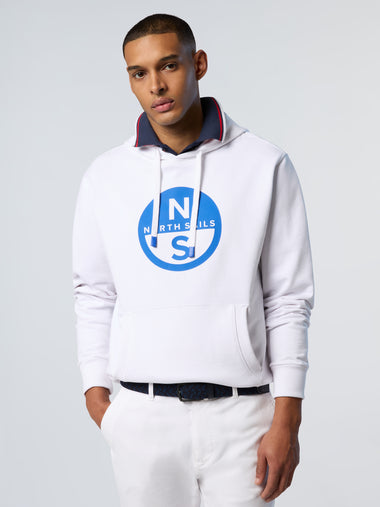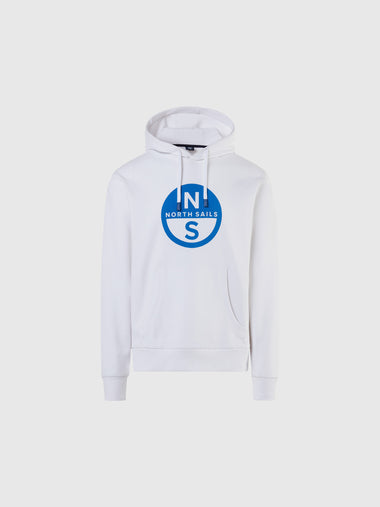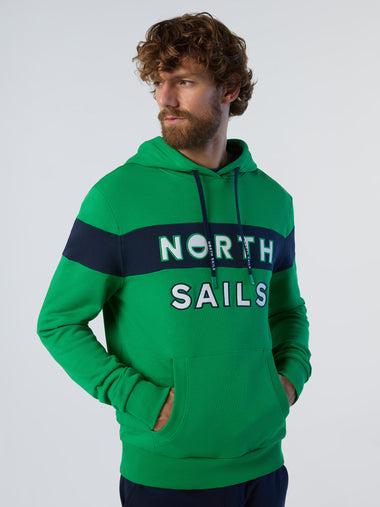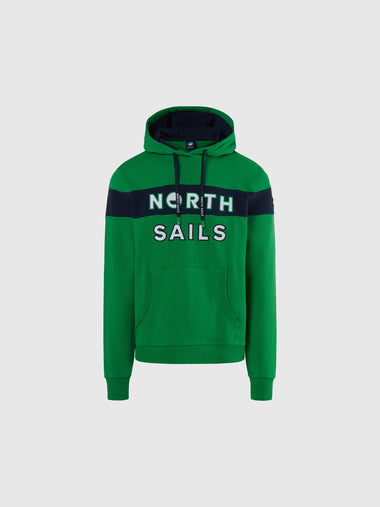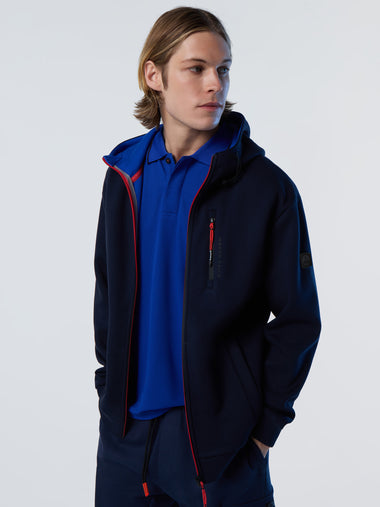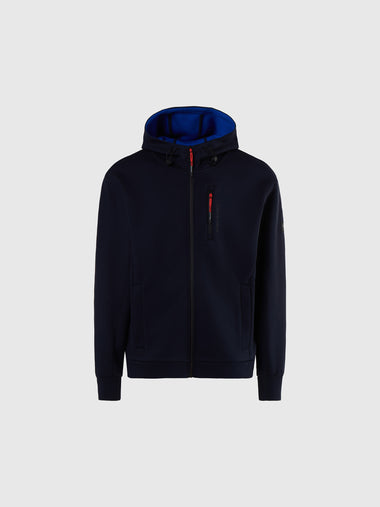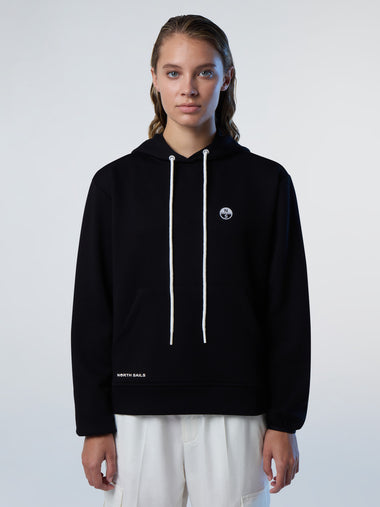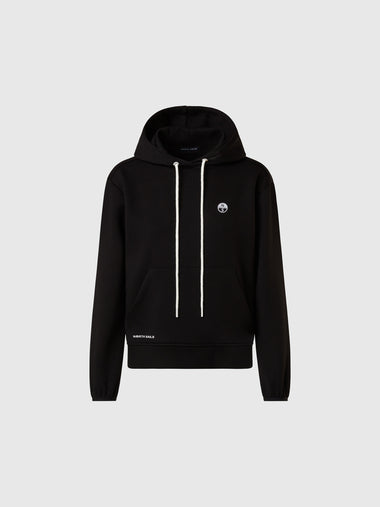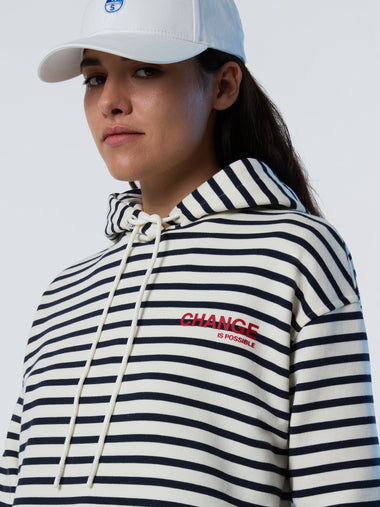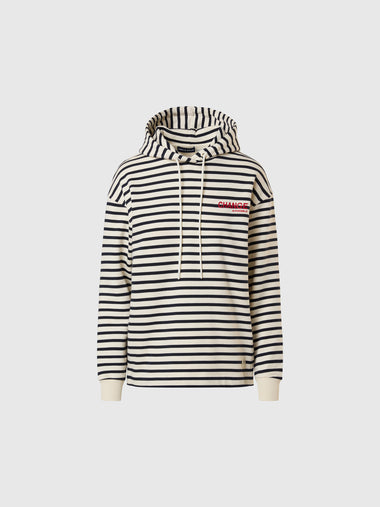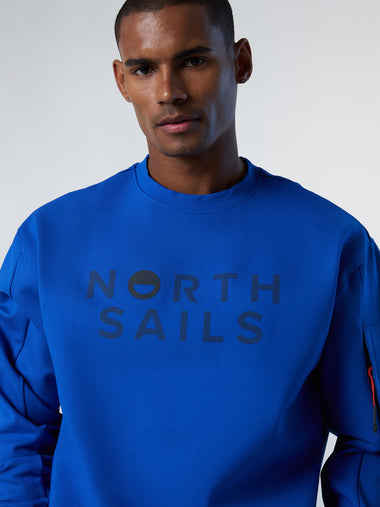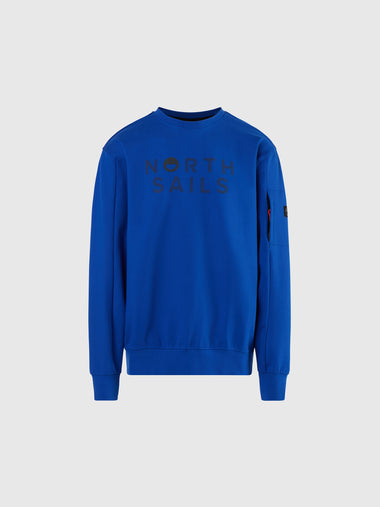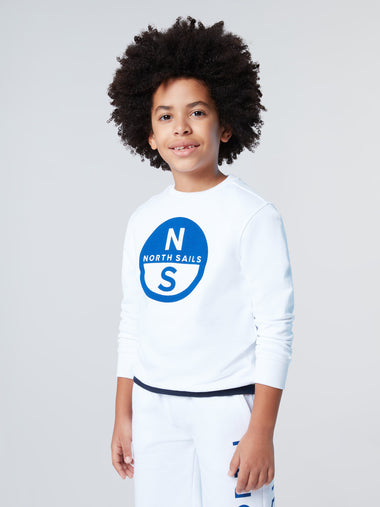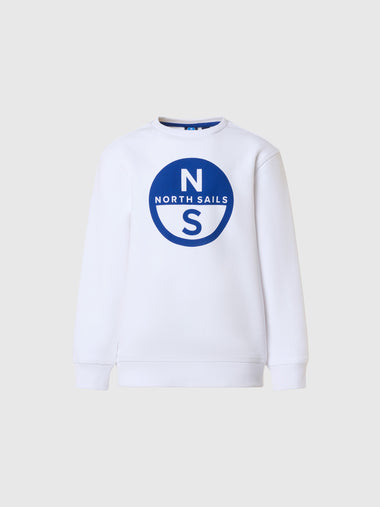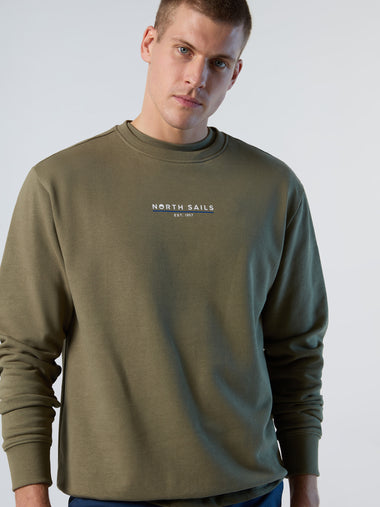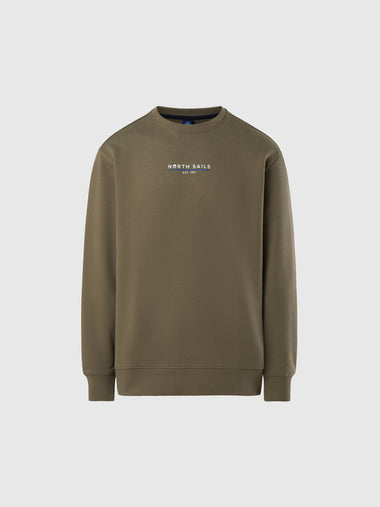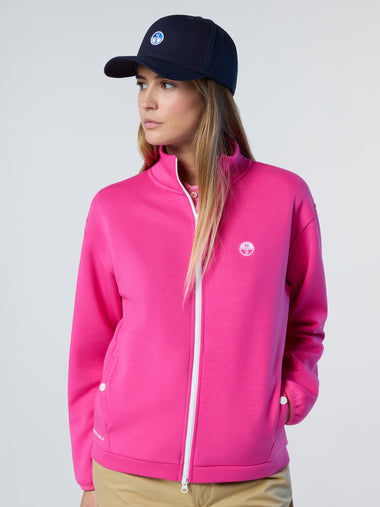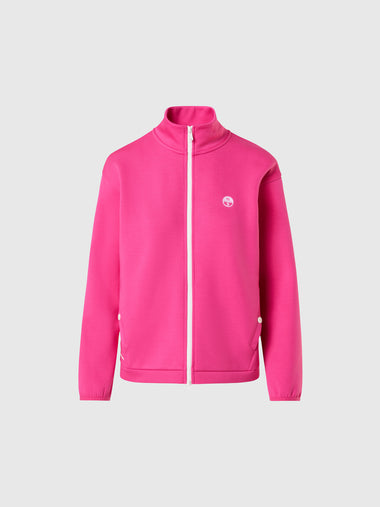NORTH SAILS BLOG
Todo
Events
Guides
News
People
Podcast
Sustainability
Tech & Innovation
Travel & Adventure
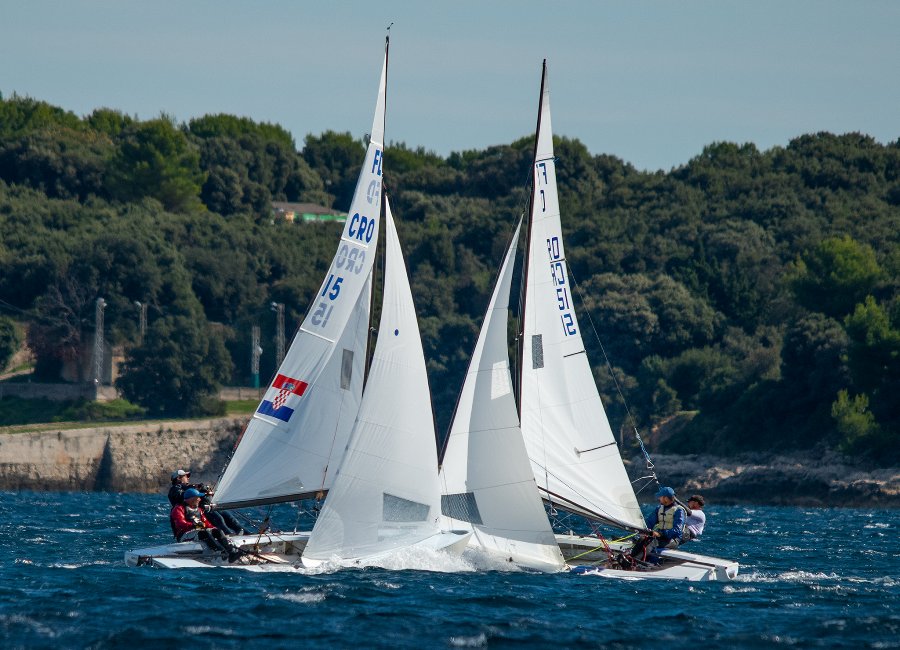
NOVI POČETAK FLYING DUTCHMANA
Novi početak Flying Dutchmana
FOTO: ĐANI CELIJA
Za vikend od 4. do 6. listopada prekinuta je suša koja je trajala dugih 27 godina, naime toliko dugo nije održani državno prvenstvo klase Leteći Holandez. Drugim riječima ovo je bilo tek drugo Prvenstvo Hrvatske organizirano za ovu klasu!
Domaćini, ujedno i organizatori, regate bili su članovi JK Vega iz Pule, a glavni i odgovorni posada objedinjena pod imenom Bole i Fudo Racing inače u službenim dokumentima poznati kao Boško Čelić i Nadan Kosanović. Riječ je o trenutno našoj najaktivnijoj posadi.
Flying Dutchman je klasa koju su 1951. dizajnirali nizozemci Uus Van Essen i Conrad Gulcher. Duljina trupa je 6.06m, masa 130kg, jedri se u dvoje, opremljena je s jedrom, flokom i spinakerom i postiže fantastične brzine i u orcu i u krmu.Od 1960. godine i olimpijade u Rimu postaje olimpijska klasa i ovaj prestižni status drži do Barcelone 1992. kad se posljednji put na njoj jedrilo na najvećoj sportskoj smotri.
Naravno, nakon tog izostavljanja s olimpijskih popisa klasa nije iščeznula, već je nastavila i dalje s radom, samo što sad u njoj prevladavaju jedriličari starijih dobnih skupina. I dalje se održavaju kontinentalna i svjetska prvenstva, a dvojac Čelić - Kosanović je ove godine sudjelovao i na Europskom prvenstvu koje se jedrilo na Balatonu.
Da se ne bi krivo razumjelo, u ovih 27 godina, koliko se nije organiziralo PH ipak je bilo regata organiziranih u Hrvatskoj, a svakako treba izdvojiti Europska prvenstva koja su se organizirala u Rapcu 2008. i u Umagu 2015. To je vrijeme kad je Hrvatska imala jednu vrlo perspektivnu i ozbiljnu posadu u vidu braće Tina i Robina Matulje. Oni su nastavili obiteljsku tradiciju koju je započeo njihov otac Ferdo Matulja. On je osamdesetih godina bio član nacionalne selekcije tadašnje države i čak tri puta bio kandidat za olimpijsku reprezentaciju.
Njih dvojica se prestaju aktivno baviti klasom 2015. godine zbog Tinove ozljede leđa, tada prodaju svoju jedrilicu i ulaze u fazu FD apstinencije koja je trajala do proteklog vikenda. Za ovu regatu su dobili poziv organizatora, uspijevaju pronaći jedrilicu i priključuju se hrvatskom timu koji je za ovu regatu bio sastavljen od ukupno četiri posade.
Osim ove dvije posade na PH u Puli jedrila su još dva hrvatska tima. Antun Vuletić i Igor Šepić na regatu stižu iz Rijeke, dok snage kluba domaćina pojačavaju Andrea Battistin i Dren Dejanović. I u još jednoj posadi smo imali predstavnika, a to je bio Andrej Hinić koji je jedrio u kombinaciji s grkom Ioannisom Remoundosom.
Ukupno je bilo deset posada. Uz spomenute hrvatske i hrvatsko - grčke kombinacije, predstavnike su imale Mađarska, Švicarska, Njemačka, Slovenija i Poljska. Kao što je to običaj s višeljudnijim i ekonomski jačim nacijama u mnogim drugim klasama, tako je i u Flyingu. Najviše jedrilica ove klase je u Njemačkoj, dok je i na Balatonu impozantna flota, jednako kao i na svakom većem jezeru na starom kontinentu i u svakom većem klubu na sjevernim europskim obalama.
Priprema za ovaj članak je napravljena u razgovoru s g.Kosanovićem i ono što je posebno isticao u više navrata je to da je jedrenje na Flyingu, slično Šljukama koje se kod nas također vraćaju na scenu, i sama regata događaj u kojem više dolazi do izražaja pristup u stilu života, nego što do izražaja dolazi natjecateljski naboj i forsiranje rezultata.
Vrijeme nam je bilo full dobro. Stvarno su uvjeti bili savršeni. Kad smo bili na Balatonu Švicarci su nas pitali kakvo će vrijeme biti u Puli. Morao sam im obećati da će biti vjetrovito i evo ispao sam čovjek koji ispunjava obećanja :) Prvi dan smo imali petnaestak čvorova neke grbinade koja je išla na maestral. Malo je miješalo, nije bilo konstantno, ali se lijepo jedrilo. Drugi dan smo odjedrili dva plova po laganom jugu i u nedjelju smo imali 25 čvorova bure. Uglavnom svi su veseli i prezadovoljni, ekipa već sama među sobom komentira da ovdje bez problema možemo organizirati EP ili SP bez ikakvih problema. Moram spomenuti da je s nama bila i jedna mađarica, starija gospođa od preko 70 godina, koja više od 30 godina obnaša različite funkcije u klasi. Sama je sjela u auto i dovezla se iz Mađarske u Pulu, a glavni motiv joj je bila želja da ponovno u klasi vidi braću Matulja. Bila je s nama cijelo vrijeme, s Regatnim odborom, a kad je bilo proglašenje pobjednika i kad su se Matulje popeli na postolje kao viceprvaci počela je plakati. A koliko je i njima dvojici ovaj rezultat bio drag govori i to da su bili konstantno u top 10 na svijetu desetak godina, a nikad nisu imali prilike postati prvaci Hrvatske jer nije bilo uvjeta za organiziranje istog. A njih dvojica nisu jedrili 4 godine u ovoj barci. Za regatu su je posudili u Mamića i da im nisu pucali boceli i dešavali se neki takvi tehnički problemi bili bi prvi. Stvarno lijepa i posebna priča. Poanta svega ovog je to da je ovo poseban đir ljudi koji uživaju u tome što rade. Nije bilo niti jednog protesta. Protesti ovdje ne postoje! Kako mi je rekao jedan talijan na Balatonu: "This is gentleman class!". Mislim, uvijek se u žaru borbe dogode neke situacije, ali sve se to rješava na moru ili eventualno uz pivu na povratku.
Nadan Kosanović, JK Vega
FOTO: ĐANI CELIJA
Ako je nekog nakon čitanja ovog teksta zainteresiralo jedrenje u FD-u možda se malo pokoleba zbog cijene nove jedrilice. Ako se želi kupiti novi trup, kompletno opremljen, mora se spremiti na popriličan iznos od 45.000€, ali naravno, kao i u mnogim drugim klasama uvijek se može naći polovan brod i opremiti ga za mnogo manje novca.
Posebna karakteristika Flyingova trupa je konstrukcija koja ima dvodno. To mu je garancija za strukturalnu čvrstoću i trajnost mnogo veću nego npr. od 420 i 470, jedrilica sličnog koncepta. Znači, ne dolazi do torzija i izvitoperenosti trupova niti nakon deset i više godina. Kao primjer trajnosti i kvalitete može se spomenuti da su ovogodišnji Europski vicceprvaci, njemačka posada, braća Borowski (bivši olimpijci i svjetski prvaci u 470) jedrili na trupu iz 1994. godine, a jedra su im bila stara 4 godine. Zaključak je da su najvažniji trim i taktika.
Jednako tako braća Matulja su na ovom PH jedrili na jedrilici iz 1991. Inače ta jedrilica se upisala u povijest kao posljednja koja je pobijedila u plovu na Olimpijskim igrama, a kormilar je bio Slovenac Kosmina.
Klasa je tehnički dosta zahtjevna i dozvoljava eksperimente s mnogim idejama. Npr. jarbol se može trimati i za vrijeme jedrenja u orcu. Peraja osim što standardno ide gore - dolje, ima mogućnost da se namješta naprijed - natrag. Prilikom jedrenja u orcu peraja se podiže za jednu četvrtinu i ponaša se kao daska za jedrenje. Zato u orcu u kombinaciji velike genove i trima peraje može postizati velike brzine i glisirati.
Ali da se vratimo regati. Nakon tri dana jedrenja i sedam odjedrenih plovova (s jednim odbacivanjem) pobjeda odlazi u ruke mađarske posade Suli - Papp, dok su braća Matulja drugi u tvorenom dijelu regate i prvaci Hrvatske u zatvorenom dijelu bodovanja.
Posada Kosanović - Čelić su peti u generalnom plasmanu i drugi u Hrvatskoj, a Vuletić i Šepić regatu završavaju kao deveti, dok su Battistin i Dejanović deseti, odnosno 3. i 4. u Hrvatskoj.
Kompletne rezultate regate možete pronaći na ovom linku. Fotogalerije i ostalo možete pronaći na Bole i Fudo Racing.
READ MORE
READ MORE
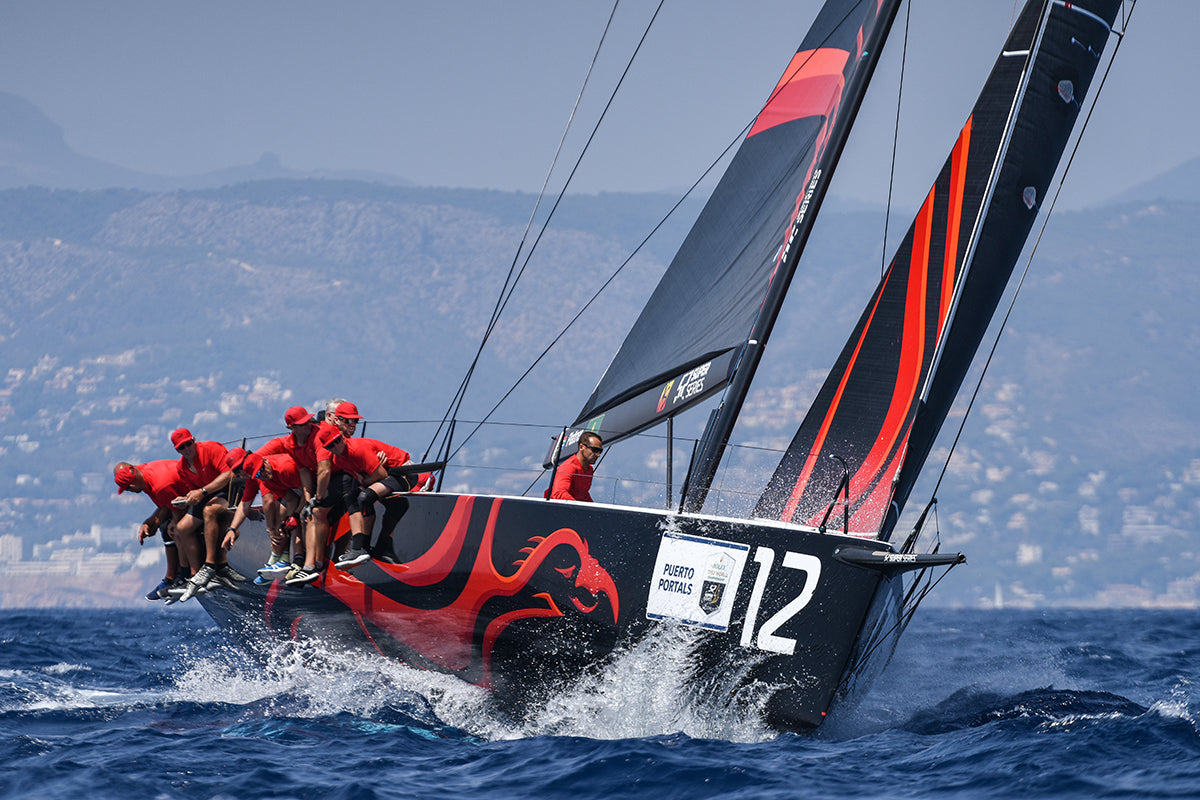
TP SEASON KEEPS GLENFIELD LOFT BUSY
TP SEASON KEEPS GLENFIELD LOFT BUSY
It’s been a busy winter for the team at North Sails New Zealand’s Glenfield loft, with more than 6 tonnes of new sails heading out the door
TP 52 'Phoenix'
Head sailmaker Casey Bellingham, who specialises in upwind sails, says the loft has been busy making race sails for the northern hemisphere TP 52 Super Series, which has seen an intense season of racing in Spain, Portugal and Italy. The NZ loft alone, has finished nearly 100 TP sails this year, including all the sails for Hasso Plattner’s Phoenix 11 and Phoenix 12 and the Sled, Bronenosec and Alegre teams, as well as producing sails for IRC TP 52s such as Hooligan, Ichi Ban, Team Hollywood, Envy Scooters and Beau Geste, and Pacific 52s Invisible Hand and Rio. North Sails made sail inventories for all, but two boats in this years Super Series.
"Every team requires small custom details, and that is what we do well", Bellingham says.
The majority of the TP sails are made from North 3Di RAW 880 cloth, a blend of carbon, aramid and Ultra PE fibres, which provides a high level of shape stability and strength in a lightweight sail.
"This is a product that North has been developing over the past few years," Bellingham says. "Everything superfluous has been stripped out of the structure so these sails are much lighter, which is what every sailor wants. It’s not only an advantage on the water but also makes them much easier to handle in the loft."
For example, the 3Di RAW 880 headsail for Fast 40 Team Hollywood, on which North Sails sales and marketing manager Andrew Wills sailed at Hamilton Island, weighed 10% less than our previous 3Di headsail, but had even more useful structure.
At the conclusion of the end of this season, designers and sailors will have a performance review, working out how the concept can be refined for even more gains.
The team is now working on major orders in preparation for the Sydney–Hobart race in December, and the superyacht season. Among them are sails for Wild Oats and Black Jack, and a suit of sails for the 34 metre Sassafrass, including a mainsail with a 37 metre luff, in preparation for January’s Millennium Cup event in the Bay of Islands.
Wills says having Bellingham’s nearly 30 years of expertise in the loft has made the busy production season run smoothly.
"Casey has such a wealth of experience, and he really takes the young sailmakers under his wing and teaches them a lot," Wills says. "It’s great for everyone that he and the other highly experienced sailmakers here are able to share that knowledge and pass on their passion for making great sails."
READ MORE
READ MORE
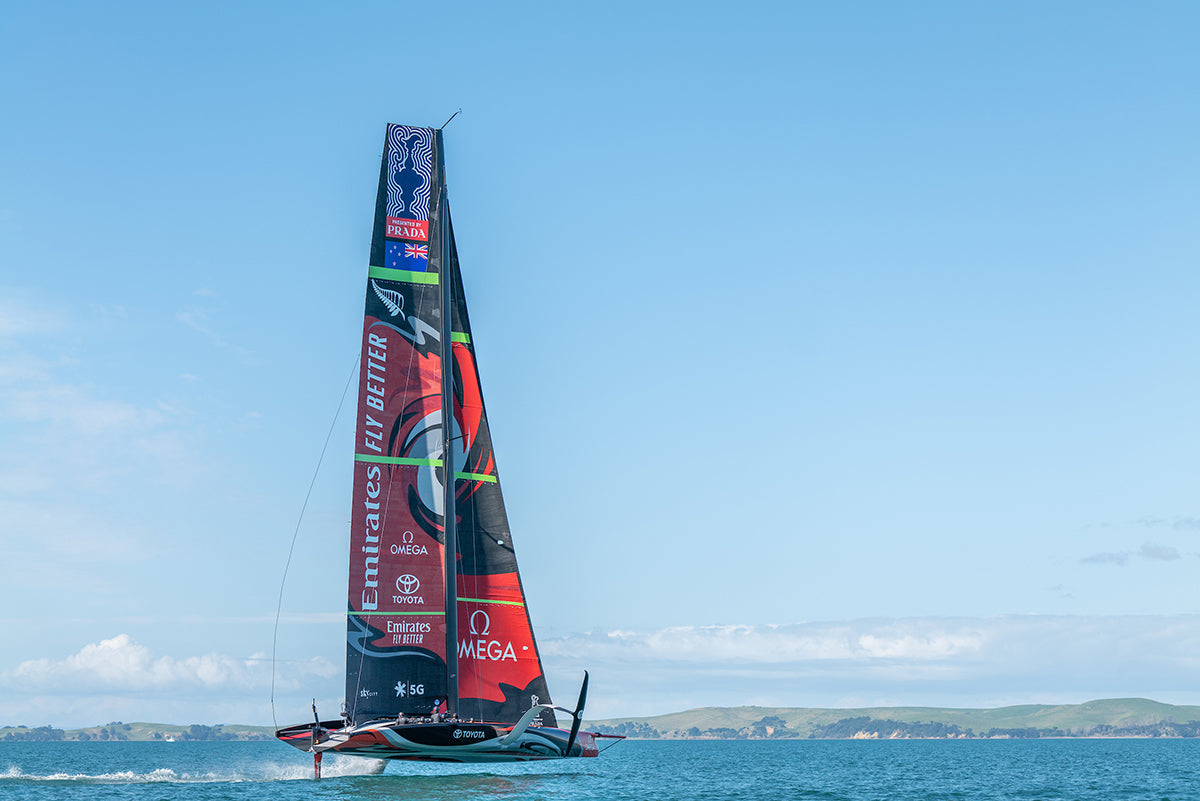
TEAM NEW ZEALAND'S FIRST IN WATER FOR 2021 AMERICA'S CUP
Representatives from North Sails New Zealand were in the crowd watching the race boat, christened Te Aihe or 'Dolphin', hit the water on a rainy Friday morning at Auckland’s Viaduct Harbour. "It was an amazing thing to witness," North Sails New Zealand sales and marketing manager Andrew Wills says.
READ MORE
READ MORE
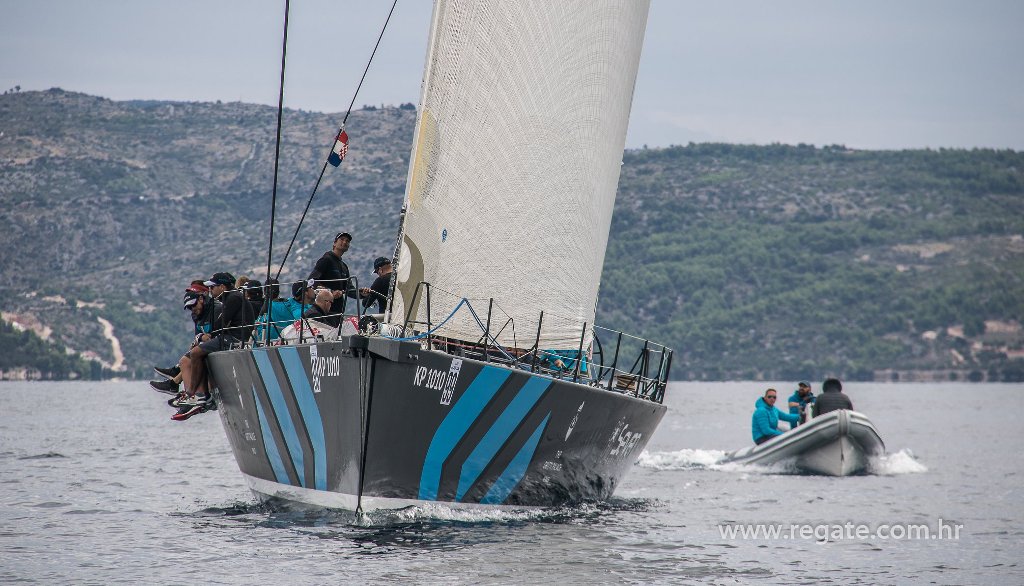
I S 88. MRDUJE NAŠI KLIJENTI SE ZADOVOLJNI VRAĆAJU DOMA
I s 88. Mrduje naši klijenti se zadovoljni vraćaju doma
Odnos LOA dvije prve jedrilice, odnosno pobjedničkog slovenskog super maxija Way of Life i Matine Fatamorgane iz skupine 4 je 23.99m : 9.98m. Stvarno ogromna razlika, a ono što im je zajedničko je da su dijelom opremljeni North Sails jedrima.
Naravno, u pitanju je Mate Arapov iz JK Mornar koji se vrlo dobro držao za vrijeme cijele regate do otočića Mrduje i natrag, pogotovo u prvom dijelu kad je držao priključak za Gašparom Vinčecom i njegovim gigantom koji je vrlo vjerojatno jedna od najvećih, ako ne i najveća, jedrilica koja je jedrila na ovoj tradicionalnoj regati.
Riječ je o 88. izdanju ove najstarije regate s hrvatske strane Jadrana, a za čiju realizaciju i održavanje tradicije je zaslužan JK Labud iz Splita.
Sudionici regate su podijeljeni u 13 skupina, a organizator na svojim web stranicama barata s impozantnom brojkom od 162 jedrilice koje su presjekle startnu liniju.
Uvjeti na moru nisu bili nimalo naklonjeni prosječnim sudionicima, odnosno jedrilicama koje nisu ultra lagane i s jarbolom među oblacima. Na startu je bilo najvjetrovitije, a puhalo je svega nekoliko čvorova s kojima su se vodeći odmah izdvojili od ostatka flote. Osim spomenutog dvojca u samom vrhu je jedrio i Shining, maxi jedrilica koja prvi put na Mrduji nastupa pod crnogorskom zastavom.
Spomenuta trojka je startala s desne strane linije, ali tijekom jedrenja prema Splitskim vratima pokrili su sva tri moguća pravca. Shining je otišao pod Brač, Way of Life je uspješno održavao rutu kroz sredinu polja, dok je Fatamorgana malo otklizala pod Šoltu. Na kraju se ta strana polja, u tom dijelu regate, pokazala najlošijom, jer je Shining mnogo brže jedrio s nekim povjetarcem koji je puhao uz Brač.
Do Mrduje ipak prvi uspijeva stići Way of Life, dok je Shining bio iza njega na nekoliko dužina. Kako je Mrduja bila pomoćni cilj zabilježena su i vremena obilazaka na tom mjestu. Sat, 54 minute i 29 sekundi je trebalo prvom do ovog mjesta, a drugoplasirani su kasnili za njima minutu i 57 sekundi, dok su trećeplasirani Mrduju obišli 20 minuta i 39 sekundi nakon Shininga.
Radili smo stvarno puno zadnjih mjesec dana oko broda. Promijenili smo timun i kolombu i bilo je posla za poluditi, ali pokazalo se da to kao cjelina dobro radi! Posada je bila odlična. Jedrili smo maksimalno fokusirani, forsirali smo cijelo vrijeme s tim da sam znao otprilike što će nam se dogoditi na ulazu u vrata, ali bilo nam je bitno da držimo kontakt s velikima. Nismo mogli ići skroz na Brač, već nas je odnijelo na Šoltu i tu smo izgubili taj priključak. Ali smo super zadovoljni. Povratak je bio skroz dobar. Kad smo izašli iz Vrata vjetar je skroz pao i otišli smo lijevo na maestralić, ali smo iz vrata izašli po nekom sjevernom vjetru i očekivali smo da će vjetar u jednom trenutku prebaciti na južni smjer. Tada smo zaobišli Shininga i na kraju smo došli paralelno s Way of Life, ali protiv njega nismo mogli. Njima je dovoljno da posada malo prošeta po palubi i oni dobiju dovoljan poriv za nastavak. Mi smo se mučili, ali nije išlo. Sve u svemu je bilo dobro i cijela posada je zadovoljna.
Mate Arapov, Fatamorgana
Što se tiče ostalih aktera regate iz prvih redova tu treba istaknuti Overloada koji se držao lijeve strane sredine polja i do Brača je u nekim trenucima bio i ispred Shininga. Također se i jedini splitski TP52, Polet Furioso, istinski trudio držati priključak. Ova ekipa je izabrala Bračku stranu, ali kasnije se prebacuju pod Šoltu i kao četvrti obilaze Mrduju. Kroz sredinu je nekoliko minuta kasnije, praktički iz drugog plana, na visoko 5. mjesto dojurio kralj bonace, Full Pelt.
90% ostalih jedrilica je prema Mrduji jedrila desnom stranom polja, a karavana se rastegnula skoro od Čiova...
Vremensko ograničenje je postavljeno na 7 i pol sati, tako da se jedrenje moralo završiti do 18:30. Kompletnu regatnu rutu koja je završavala ispred "galebova" uspješno je odjedrilo samo 12 jedrilica! Njih je do kraja predvodio Way of Life, a na drugo mjesto se probila Fatamorgana.
Vremena ulaska u pravi cilj Mrduje su slijedeća:
Way of Life - 04:57:02 (partly NS inventory)
Fatamorgana - 05:49:17 (partly NS inventory)
Shining MM - 06:23:20
Full Pelt - 06:44:44 (partly NS inventory)
Polet Furioso - 06:45:44 (partly NS inventory)
Overload - 06:54:53 (partly NS inventory)
Furiosa 2 - 07:00:35
Gringo 2 - 07:03:47 (partly NS inventory)
Bare V - 07:07:26 (full NS inventory)
Arhimed - 07:20:22
My May - 07:25:38 (full NS inventory)
Magnum x3 - 07:29:30
Prolaske ostalih jedrilica oko Mrduje i plasmane po grupama možete pronaći u službenim rezultatima, a iduća velika regata koju organizira JK Labud je 75. Viška regata čiji Oglas možete pronaći na ovom linku.
READ MORE
READ MORE
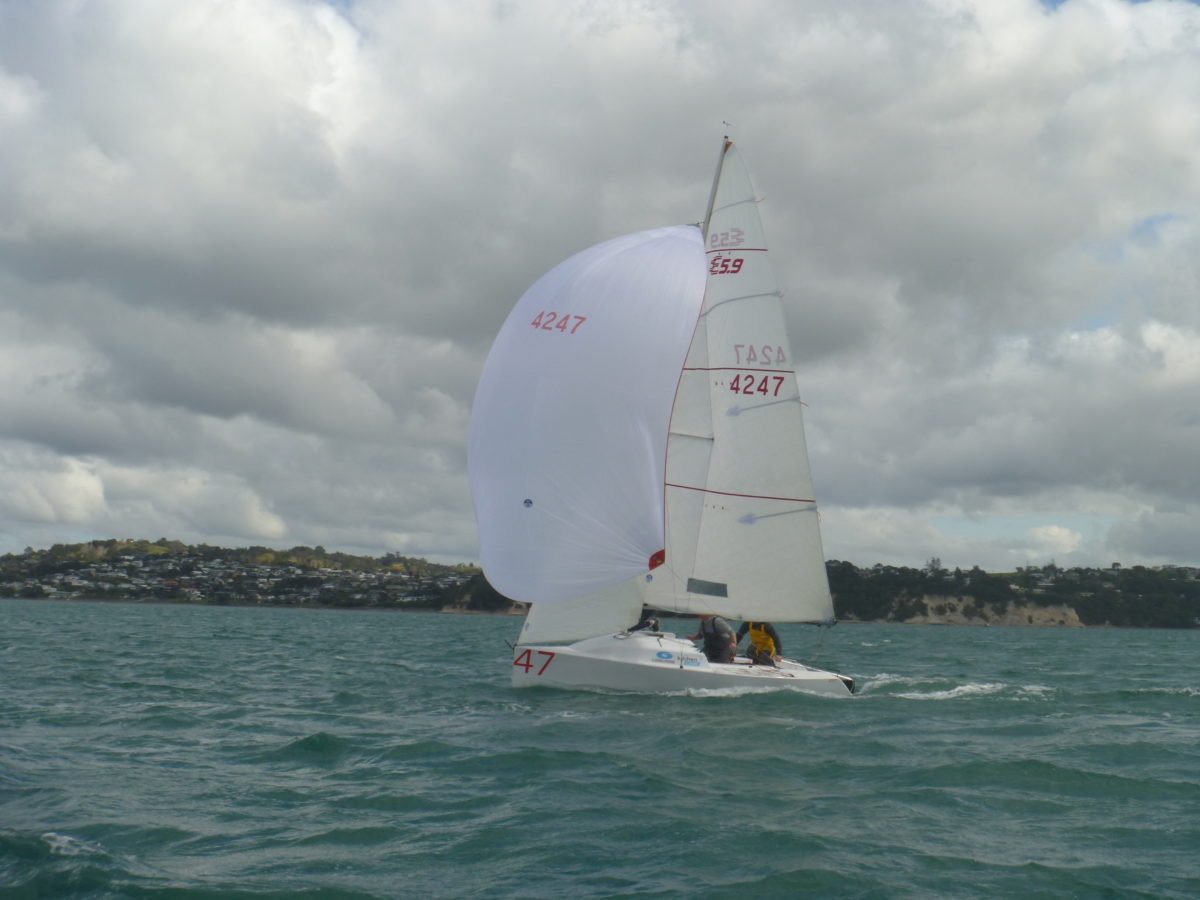
ALL NEW ELLIOTT 5.9 SAIL INVENTORY FOR 2020
ALL NEW ELLIOTT 5.9 INVENTORY FOR 2020
North Sails Announces Winning Inventory
With the change to 3Di Raw 330 sails in the Elliott 5.9 class, we were eager to talk to the current New Zealand National Champion, Craig Satterthwaite about how his team achieved multiple victories using the new One Design sails.
After the E5.9 Association announced a new model of boat, Craig caught the bug and raced at various venues which is how his team R&R came to be six year ago. Along with teammate Bart, Craig is from Auckland and first sailed an Elliot 5.9 in the Royal New Zealand Yacht Squadron Youth Training Programme. The team made sure to have plenty of fun both off and on the water, which is another reason why the E5.9 Class is appealing to Craig.
Not only are B&B current National champions, they are impressive five-time National champions in a competitive fleet which ranges from 12-18 boats. Craig credits these multiple victories to having a strong crew. “Having a good crew is important. We have been together for a while so we’ve learned a lot from our mistakes and we know what works for us. We worked really hard on turning light air sailing into a strength which is not that easy when we always seem to be the heaviest crew!’’
Since using the new 3Di RAW sails for the past two Nationals, Craig has noticed key differences in the performance and handling of the sails, finding the decrease in material stretch leading to a change in sail stability: “When a puff hits, we accelerate rather than heel. 3Di sails are also easier to set the rig up for – it is very easy to change modes from the high slow to the lower fast mode and 3Di sails are easier than panelled sails to set up.’’
“When a puff hits, we accelerate rather than heel and it is easy to change modes from high slow to the lower fast mode.’’
Sailing with a full North inventory, Craig and the team used the new MNi-1 Mainsail which has been designed to make maximum sail area and to be easier to trim. B&B used the new-design 3Di RAW Light/All-Purpose/Heavy Jibs alongside the AP Spinnaker and flatter VMG Spinnaker designed for lighter airs. Craig explains how he felt the 3Di RAW sails responded to a mix of wind strengths: “With the stability and stiffness of the 3Di RAW sails, it is very easy to change gears as the wind increases. Rig tension becomes less important as the sails do not stretch. We are very happy with the sail quality – we sailed in big winds and saw no signs of material or shape damage.’’
Craig and the team onboard B&B are soon to challenge the fleet during the Omaha Regatta, with the New Zealand Nationals coming up at the end of the season.
Craig Satterthwaite (4247) sailing well upwind with the nicely trimmed new-design MNi-1 Mainsail
READ MORE
READ MORE
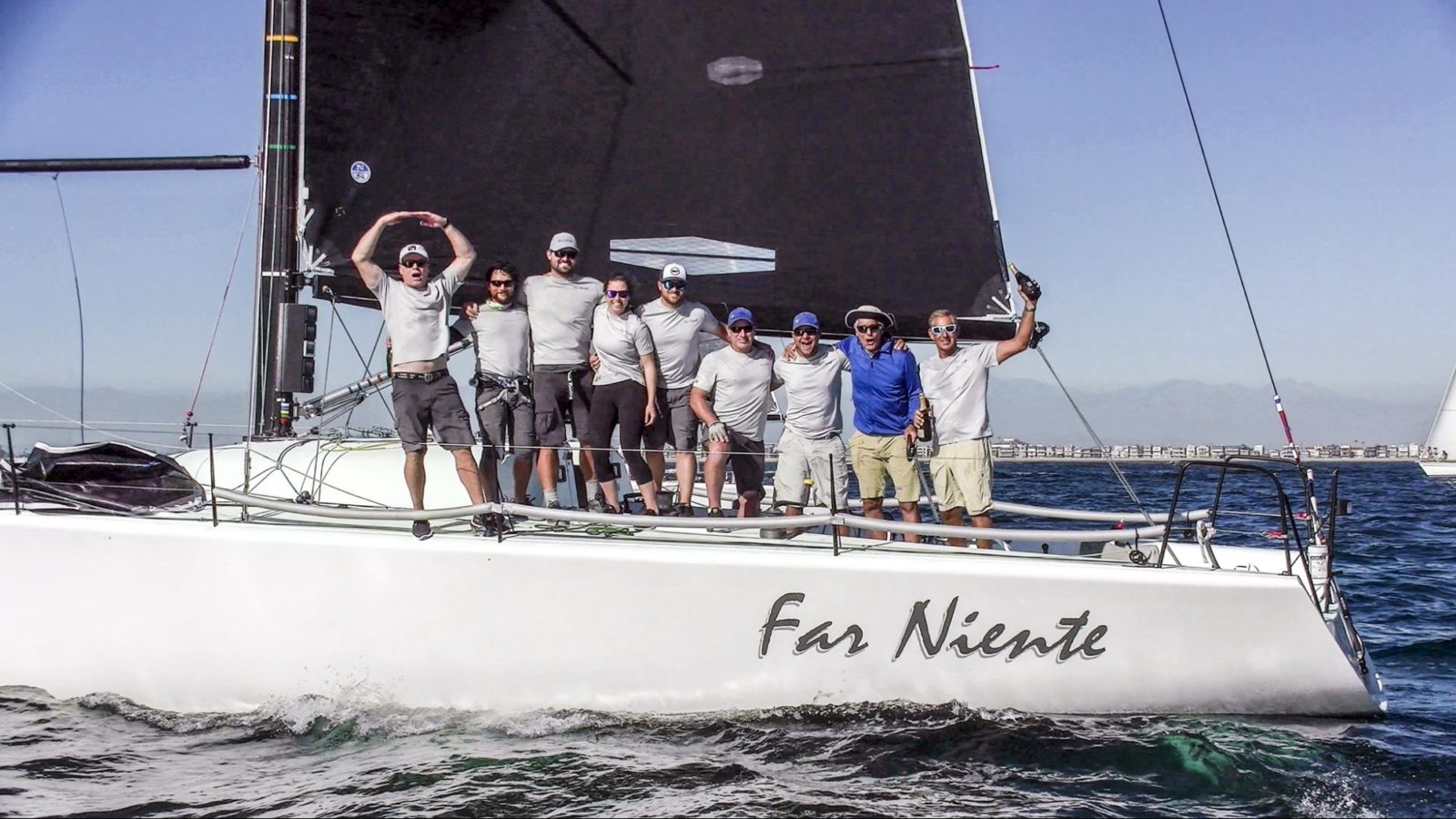
FAR NIENTE WINS FARR 40 WORLDS
FAR NIENTE WINS THE FARR 40 WORLDS
Brun & Freides Create The Winning Combination
Long time North Sails legend Vince Brun and his boat partner (and long-time friend) Drew Freides put together a strong program for the 2019 Farr 40 World Championship and sailed brilliantly to come away with a win over a talented international field in Long Beach, CA. Over a wide variety of conditions in the eleven-race regatta, team Far Niente showed great boat speed, excellent tactics, and solid starts to take the victory over last year’s champion Strungie Light from Germany. Competitors from Australia, Germany, Canada, Uruguay, Great Britain, Mexico and the US enjoyed a great week of racing in Southern California in a total of fourteen teams.
The Prep
Vince and Drew have had the boat for several years, but did only a few local regattas in the San Diego Bay area. When the World Championship was awarded to Long Beach Yacht Club, a team was assembled, a work list was started, and sails were ordered. Two weekends of training and tuning were set up but not a lot of fleet racing was done until just before the event started. The trimming team of Vince, John Hayes, Eric Doyle and Charlie Smythe worked very hard to improve the rig tune, boat handling, and trimming techniques throughout the whole event. Under the watchful eye of coach Ed Adams, changes and improvements were being made right up until the last day. Drew Freides commented; “We had the very best team and kept an open mind to learn and try new setups. These were the keys for our success. We were improving our performance every race.”
“We knew we had a good boat, but in any one design program you need fast sails.”
Conditions
The conditions were typical Long Beach sea breeze the first day but then were generally on the light side. Lots of 7 to 11 knot races with nice flat water. Powering the boat up as quickly as possible was the key to success upwind. Maintaining speed at the correct angle was paramount downwind and in light conditions it required maximum concentration and teamwork.
The Sails
“We knew we had a good boat, but in any one design program you need fast sails,” said Vince Brun. Team Far Niente’s upwind sails were 780 3Di RAW and performed well throughout the wind range winning races in everything from 8-22 knots, using tuning suggested settings practically straight from the standard North Sails Tuning Guide. Vince Brun commented; “Having good sails is not enough, you need to know how to use the sails. Just like a big family, we contacted the North Sails Farr 40 experts around the world and they shared everything they knew, making it easier for us to get up to speed.”
Rob Davis and his team Nutcracker also used a full inventory of North Sails to finish 4th overall.
📸 Bronny Daniels / Joy Sailing
📸 Bronny Daniels / Joy Sailing
READ MORE
READ MORE
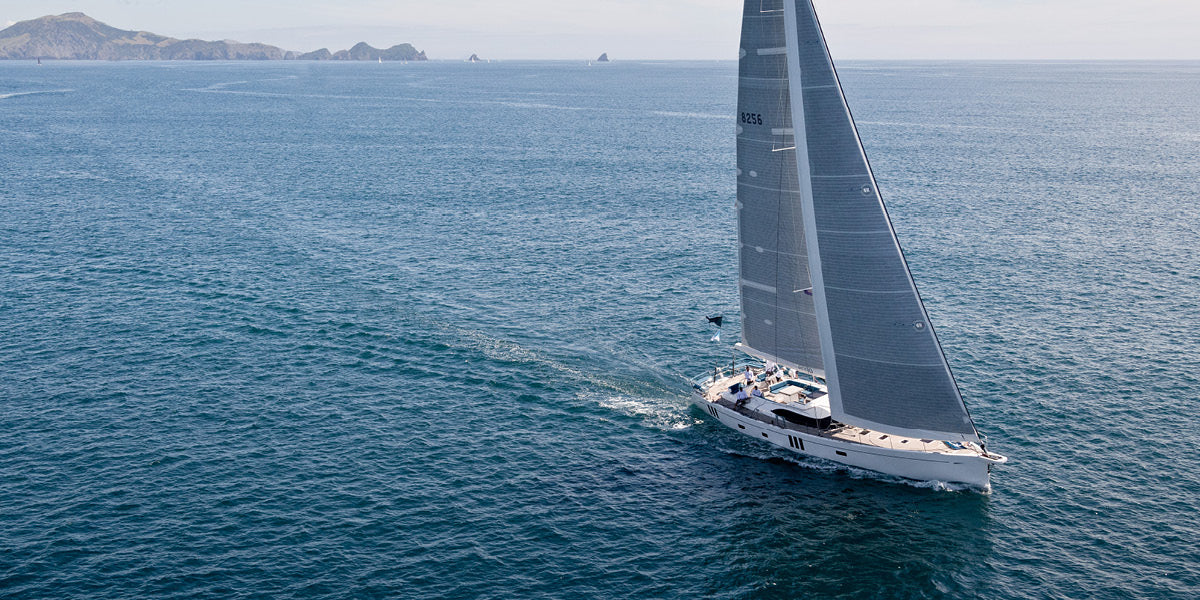
THE ULTIMATE SUPERYACHT CRUISING SAILS
3Di OCEAN: THE ULTIMATE SUPERYACHT CRUISING SAIL
Revolutionary cruising sails for boats over 60 feet
3Di OCEAN is the ultimate superyacht cruising sail, providing medium to large cruising yachts more choice within the North Sails product line. Everything North Sails has learned as the preeminent builder of superyacht sails for more than three decades has been combined with current state of the art 3Di technology to deliver high strength and a supremely reliable sail for cruising yachts over 60 feet. 3Di OCEAN sails are more durable and easier to handle than any string sail counterpart.
3Di OCEAN is a cosmetically beautiful sail where North design, material science, and 3Di longevity are engineered for the ultimate cruising experience. And in 2019, North Sails has continued to refine and optimize the benefits of UltraPE in 3Di sailmaking for the large boat cruising market. 3Di OCEAN is a true cruising product.
Per Andersson, 3D General Manager for North Sails, led the development of 3Di OCEAN: “The successful launch of the revolutionary 3Di Nordac in 2017 opened our eyes that there was a gap in our product line to serve the larger boat cruising market. This is the reason we created 3Di OCEAN, a sail that has the benefits of North 3Di yet with a design that is more forgiving and easier to set up and trim. Unlike racing yachts, cruisers are normally sailing short handed and want ease of handling. Unique in the 3Di line of sails, OCEAN sails carry a specially developed woven exterior tape which has eight times the chafe resistance of our standard non-woven Endurance surface, which also adds greater UV resistance. A 3Di OCEAN sail will carry through a wider range of sailing angles and generally make your sailing more enjoyable.”
A proven technology, North Sails has made 1,900 3Di sails for yachts over 70’ since 2013. Like with the introduction of 3Di NORDAC, 3Di OCEAN has been immediately welcomed by serious cruisers, with 200 sail sold in the first 12 months to boats ranging from 60′ up to 200.’ With perfectionist design and manufacturing built-in, 3Di sails are stronger, more resistant to stretch and more durable, delivering inherent value for money. The durability of 3Di OCEAN is underlined by the nature of all 3Di sails, which contain zero “mylar” film and are true composite structures, resisting strain and compressive forces in all directions. Being 3D molded, 3Di OCEAN sails are a more efficient use of material and manufacturing to meet the demands of global cruising yachts, including high resilience to UV, flex, and abrasion. And because there is no mylar, 3Di OCEAN sails will not delaminate.
Andersson explains, “Using our patented 3Di technology to craft precise sails for each client, we use high Dyneema content with 3D molded construction to achieve the perfect cruising sail, which is very different from our racing products.”
Adding even greater value, every North sail includes access to the unparalleled worldwide network of North Sails expertise and service. Wherever you cruise there is a North Sails loft and people ready to support your adventure and committed to world-class customer service, 24/7, 365 days a year at over 100 loft sites across five continents.
3Di OCEAN is available now. Click here to learn more.
READ MORE
READ MORE
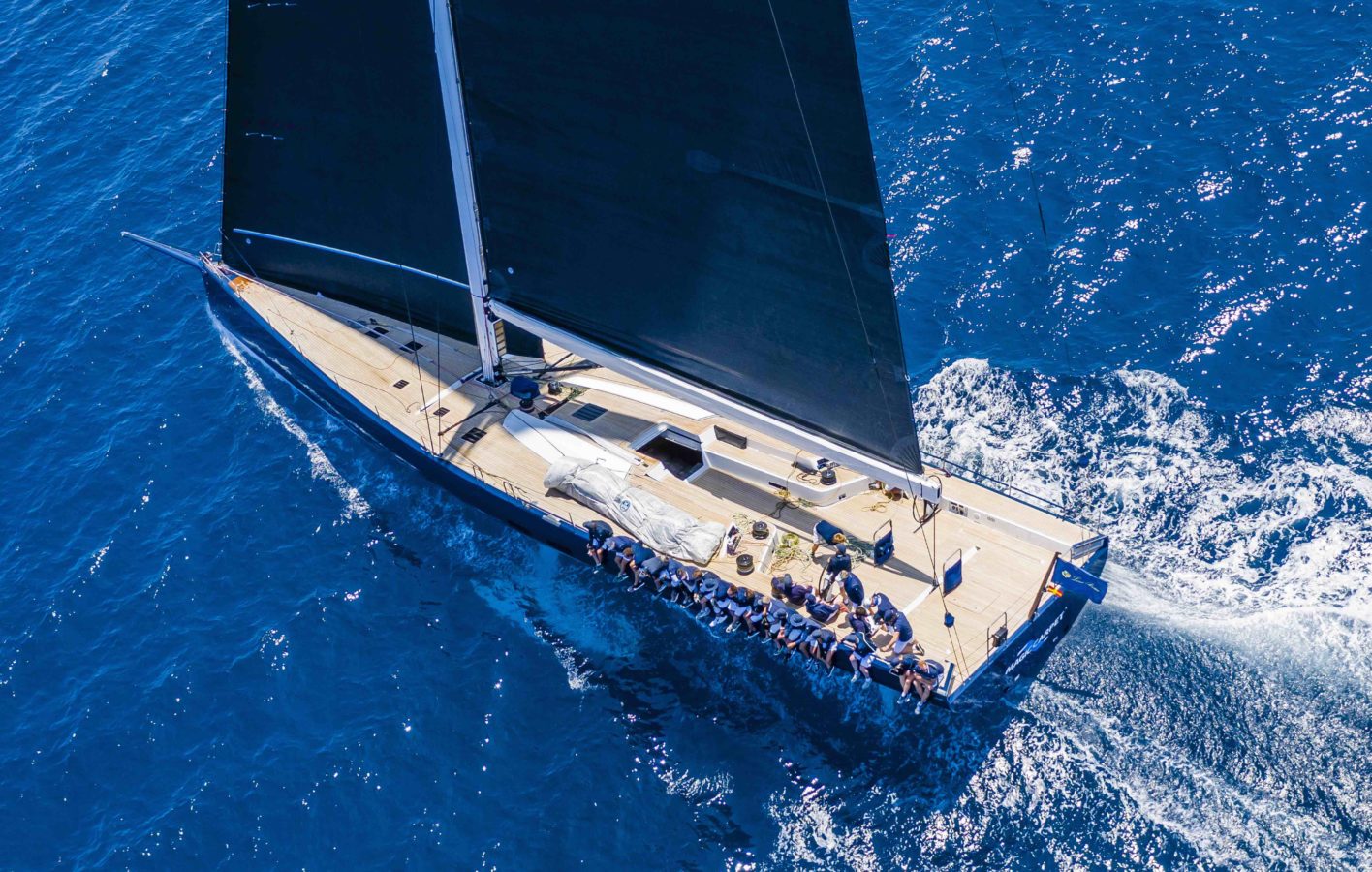
NORTH SAILS IS THE SUPERYACHT SPECIALIST
THE SUPERYACHT SPECIALIST
The North Sails Industry-Leading Team Offers Unparalleled Support
At North Sails we understand that every superyacht is unique. And this philosophy shapes the North approach to serving this premier segment of our sport. Each superyacht project combines North design tools with decades of experience, which is why we are known for finding solutions to any challenge. And with each new yacht, the North Sails team of superyacht experts is uniquely positioned to deliver an experience as custom as the design of each boat.
Our Superyacht group is led by Jens Christensen, who is well-known and highly respected, and whose superyacht expertise is in demand by the world’s most high profile projects. Alongside him, North Sails has amassed a group of superyacht experts across design, sales, and aftercare sail service who deliver industry-leading customer support.
“We are well aware that our products are only as good as the people that work for us,” Jens says. “We need to have the leading experts working for us across design, development, cloth, sailing, and everything in between to make sure we stay at the forefront of the superyacht industry.”
“We are also aware that people want to go sailing for a whole lot of different reasons – some want to cruise the world, some want to focus on charter, and some want to race (and win). So making sure that any boat is fitted and optimized for purpose is at the core of what we do. We want clients to have the best possible experience whatever they are doing and wherever they are going. And we are able to do this through our extensive network of salesmen and designers backed by our world-class selection of product, Design Services, and our global network of lofts. It is a complete package for any boat owner, that is unmatched.”
True to the company’s heritage, many North Sails superyacht sales experts and designers sail on the yachts to make sure they understand how a sail interacts in real terms. Jens explains: “When you have a ketch with an inner forestay, and you have to furl the jib through the tacks in St. Barths in 20 knots of breeze, you see the beating that everything takes. It is essential that we’re there with clients to see all the small improvements that can be made to a sail: the kind of details that you’d never know about if you didn’t get out on the water with the crew.”
Expert Sail Consultation: A Stable of Superyacht Specialists
The North Sails stable of superyacht specialists is second to none. Veterans such as Mike Toppa, Tom Dodson, Ken Read, and Tom Whidden are currently mentoring the next generation of North Sails Superyacht experts, who continue to work together to expand our ability to service clients.
The coordinated effort by the North Superyacht group has resulted in location and personnel acquisitions that have helped shape the future of the business. In 2018 North Sails acquired the former Doyle Palma, enhancing our presence at the heart of superyacht activity. North Sails Palma, led by Quinny Houry, is now the largest sales and service site within our global network. We have also made other key hires to support the segment, including Andrew Schneider, Peter Grimm and the latest addition, sail designer Glenn Cook who was attracted to North from Doyle for access to the best tools and products on the market.
Better by Design: World-Class Analytics To Deliver Optimized Performance
North Sails goes beyond just traditional sail design. North Design Services is an elite team of engineers who help yacht designers bring an owner’s vision to life. Headed up by Jeremy Elliot, North Design Services works directly with yacht designers, project managers, boatbuilders, sparmakers and riggers to test and optimize virtually any part of any sailboat in any sailing environment, even before the boat is built. Analysis can range from determining load ratings for specific winches to complex relationships of yacht balance, target speed, wind angle, sea state, rig loads, sail shapes, ratings and more. Once the owner’s brief is understood, North Design Services works with all external parties, and alongside a North Superyacht sail designer, to create the optimum solution for the boat and type of sailing. It is a unique service that gives clients the very best solutions for their new boat.
Superyacht Service and Support: A Global Network of Sales & Service
As any superyacht owner knows, the journey only starts when the boat is delivered – support and service is a huge part of life on the water. And that is why North Sails have put so much time and effort into North Sails Certified Service. It gives superyacht crews and boat owners the benefits of convenience and experience through an unrivaled global network of sail lofts. In the last two years, North Sails has an expanded presence in Palma, Mallorca, Ft. Lauderdale, Florida, and Newport, Rhode Island. With 14 dedicated superyacht service lofts across five continents, clients get the best service and results thanks to local experts, loft space, and technology. All of these facilities can handle the unique logistical needs of superyacht sails, including trucks, cranes and specialty sailmaking equipment. You will also find North Certified Service offered at key regattas on the Superyacht racing circuit.
With a yearly maintenance check-in offered on all sails and a stringent 10 point inspection, the team works hard to ensure any issues are spotted early and dealt with quickly. But its the North Sails Blue Book that really stands the company apart from anyone else. The Blue Book ensures that wherever you are in the world, whatever loft you go into, your sail will get the same world class treatment as if you went back to where you bought it. It is a manual for company-wide consistency and depth of knowledge from the Pacific Islands to the Canary Islands and everywhere in between.
READ MORE
READ MORE

SAVE A BUNDLE ON CRUISING SAILS
SAVE A BUNDLE WITH SPECIAL PRICING
Talk To Your Expert About How You Can Save On Cruising Sails
The time to buy new North cruising sails is now. For a limited time, receive a G1 all-purpose gennaker with the purchase of a 3Di NORDAC or NPL TOUR main and headsail. Visit the United States Sailboat Show or get in touch with your local North loft now to add North Sails performance, quality, and value to your cruising.
Choose Your G1 Gennaker
North Sails G1 all-purpose cruising asymmetrical spinnaker delivers fast and easy downwind sailing. These custom, built to order spinnakers are optimized for your boat with wider steering grooves for maximum versatility, and made out of propriety Norlon fabric.
Terms: Free G1 Gennaker promotion valid when customer orders one mainsail and one headsail of either 3Di NORDAC 330 or NPL TOUR Xi with max P dimension of 18m. G1 Gennaker must be made of single, select colors Norlon fabric. Minimum 50% deposit at the time of order with balance due at the time of completion and prior to delivery. All sails must be delivered no later than December 31, 2019. Offer expires November, 4, 2019.
READ MORE
READ MORE
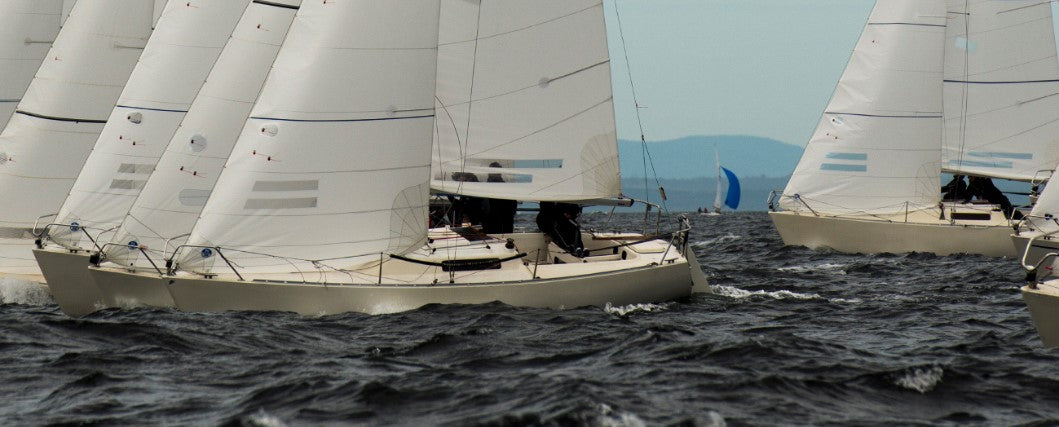
NORTH SAILS DOMINERER I EXPRESS KLASSEN
Team Hvergang, med skipper Esben Keim, rormann Trygve Leergaard, trimmer Stein Broch Olsen og fordekk Tellev Tveit seilte overbevisende gjennom hele serien og kunne endelig smykke seg meg NM-tittelen. Laget valgte for 2019 sesongen å seile med North Sails. Vi syns derfor det var interessant og ta en prat med Esben for å høre hva han mente om seilene og hvordan de trimmer for maks fart.
Foto: Morten Jensen
Intervju med Esben Keim
Dere er kanskje det laget som har lengst erfaring i Express i Norge, dere har seil sammen i hvor mange år?
Vi har seilt sammen i 20 sesonger nå, både Trygve Leergaard, Stein Broch Olsen og meg selv. Tellef Tveit kom om bord før 2018 sesongen og er superivrig etter å lære og bidra. Han har nå lært seg å se etter vind og trykk, det hjelper oss alle.
Ryktet fra NM-banen var at dere var feltets raskeste båt? Hadde dere fartsoverskudd?
Vi er veldig raske i år. Spesielt opp til 5-6 m/s. Vi har alltid vært raske opp til 2-3 m/s,nå på slutten og spesielt under NM fant vi supergearet også på litt sterkere vind. I første racet hadde vi ikke det, vi gjorde så noen grep med flytting av skjøtepunkt på fokken. Det ga veldig uttelling og vi opplevde deretter at vi hadde overskudd hele veien.
Eller var dere bare smarte?
Med 52 båter på linjen er det selvsagt viktig å være smart, det smarteste vi gjorde var å bruke en hel kveld i uken før mesterskapet på startdrill, timing og gearing av båten. Vi hadde gode starter på alle regattaene med unntak av den vi ble påseilt ca.1,5 minutter før start, da var vi på rett side av linjen, men ca 10 sekunder for sene. Vi bestemte oss umiddelbart for å seile oss fri og gikk for fri vind hele første kryss i kombinasjon med vindskift. Det traff bra og vi ble tilslutt nr. 6.
Dere brukte North Sails/Ottoson for en del år tilbake, så hadde dere en annen leverandør noen år, og fra 2019 var dere tilbake på North Sails. Hvordan opplever du de nye North Sails modellene?
Sammenlignet med tidligere North Sails/Ottosson så ser vi jo at verden er gått videre. Vi gjorde det enkelt med Ottosson seilene før; hadde stort sett samme riggsetting, alltid stramt uthal på storseil og et fast gir på fokken. Med de nye seilene får vi bedre respons på justeringene, spesielt uthal på storseil gir større effekt. Vi tror nok at disse seilene er de raskeste vi har hatt, det gir det litt ekstra som kan bety en båtlengde på en kryss, det kan være nok til å gå foran rundt toppmerket og kunne seile fritt.
Følger dere tuning guiden? Seilte dere på noe annet enn base rig-setup under NM?
Vi har ikke fulgt tuning guiden så mye. Mulig vi burde gjort det mer. Vi har stort sett valgt å konsekvent seile med ca 5-10 mm pre-benn på masten. Litt løsere setting i lite vind (sluppe ca 2 hele turn på over og undervant ut fra base setting).Det fungerer på vår rigg. Hadde vi hatt en annen mast og andre salingshorn er det ikke sikkert det ville fungert like godt. Nøkkelen for oss er pre-ben på masten.
Hva hadde dere av rake?
Vi har ikke målt dette, vi skiftet mast i 2018 og testet med samme lengde på forstag. Det viste seg at forstagsinnfestingen ikke var på samme plass og det ble for lite rake. Vi testet og justerte med sjakler og konkluderte med at vi måtte forlengemed ca. 1,5 cm (mener jeg å huske). Vi har nå lik rake med alle de andre expressene som ligger parallelt på expressbryggen i Oslo Seilforening. Det er vi fornøyd med og har ikke planer om å endre dette. Vi har ikke målt hvor mange mm det er fra mastefot og ut til møtepunktet mellom dekk og fall dersom vi slipper alt og det er vindstille.
Har dere gjort noen spesielle forberedelser med båt / mannskap. Andre punkter du tror vil være nyttig for andre Express seilere?
Skal man seile mesterskap med mange båter som i utgangspunktet går like fort (en-type), er det lurt å få gode starter. Det gir valgfrihet og muligheter for å følge en strategi (seiler der man tror vinden og strømmen er mest optimal). Bruk tid på å trene start, det gir mye mer enn å slipe kjøl i tilsvarende tid.
Hva er planene for neste år?
Neste år skal vi fortsette å seile Express. Vi håper båten lar seg reparere og bli like god igjen, det er en stor skade etter kollisjonen i NM. Vi seiler OS tirsdagsseilingen på vår og høst i 2020, det er den beste plassen for å lære og ha det moro. Så blir det spennende å se om vi kan vinne 3 færderseilaser på rad. NM Express i Kr. Sand blir jo litt «hjemmebane» for meg….. jeg kan ikke huske å ha seilt annet enn optimistjolle der…. Det blir uansett moro å teste uten bane med mye strøm, varierende og periodevis mye vind og solgangseffekt. Vihar pt ikke tatt stilling til HRW, jeg har lyst, men det er krevende å få alle til å kunne ta seg fri da.
Team Hvergang benyttet følgende Express modeller i 2019:
Storseil KV-5
Fokk RE-7
Spinnaker VTR-2
Du kan lese mer om Express modellene her: https://www.northsails.com/sailing/en/od/express
READ MORE
READ MORE
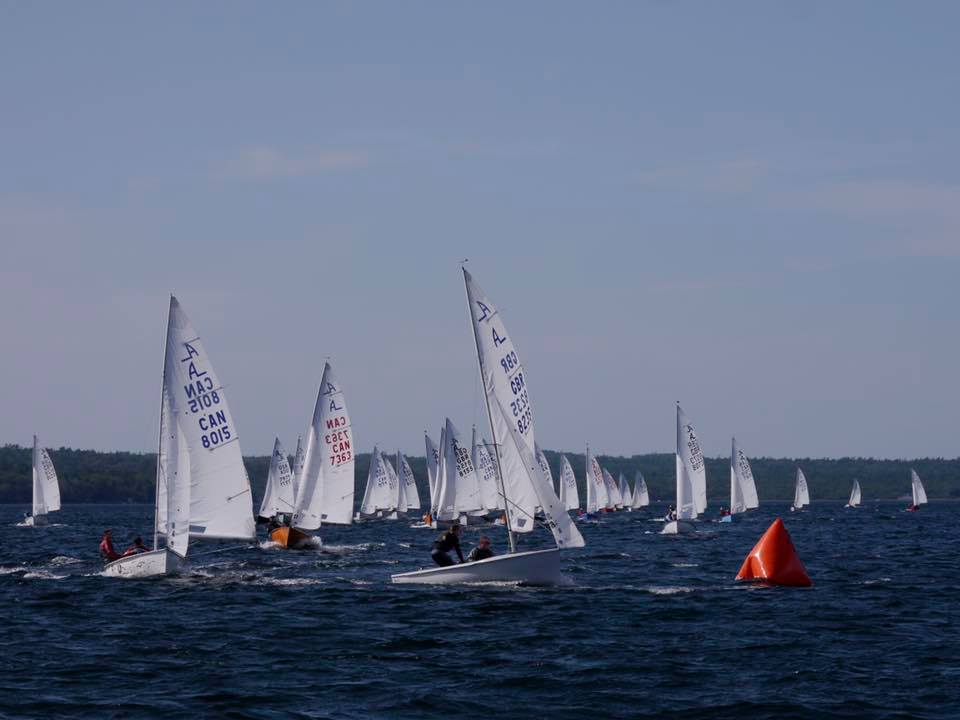
EVENT SPOTLIGHT: INTERNATIONAL ALBACORE CHAMPIONSHIP
EVENT SPOTLIGHT: INTERNATIONAL ALBACORE CHAMPIONSHIP
A Roaring Success
Forty-seven teams from Great Britain, the U.S.A, and Canada competed in the six-day regatta. British sailors Neville Herbert and Mark Fowler sailing You Can Call Me AL took the overall win.
While the official hosts of the regatta were the Shelburne Harbour Yacht Club, the Town of Shelburne also played an integral role in the event, providing infrastructure and venues so that the participants, athletes and their families and supporters, could gather each day following racing.
The Shelburne Harbour Yacht Club has received incredible support from the community and sponsors for hosting the event. Competitors used the Shelburne Harbour Yacht Club marina, the Shelburne Sailing Academy slipway, and the Town of Shelburne to store their boats. The nearby Shelburne Guild Hall served as a social gathering spot in the evenings for the competitors. These nightly gatherings were open to the public, and town residents would stop by to check out the proceedings and interact with the regatta participants. “This was a great way to bring the Sailing Club and the local community closer together,” said lead organizer Henry Pedro.
Over 67 volunteers, including many youth stepped up to the plate to help during the week, all with the help of the local community. Everyone was very enthusiastic and happy to see a large number of visitors to the town all together; competitors certainly enjoyed that as well.
The International Albacore Championship was started in 1973 and is held every two years, with Canada, Europe and the U.S.A. alternating as hosts. The 2021 Albacore International Championship will be held in at the Plas Heli Welsh National Sailing Academy in Northwest Wales.
North Sails Toronto was thrilled to support such an amazing event that brought the local community together with participants and their families.
Learn more about Albacore products from North Sails experts including tuning techniques.
READ MORE
READ MORE
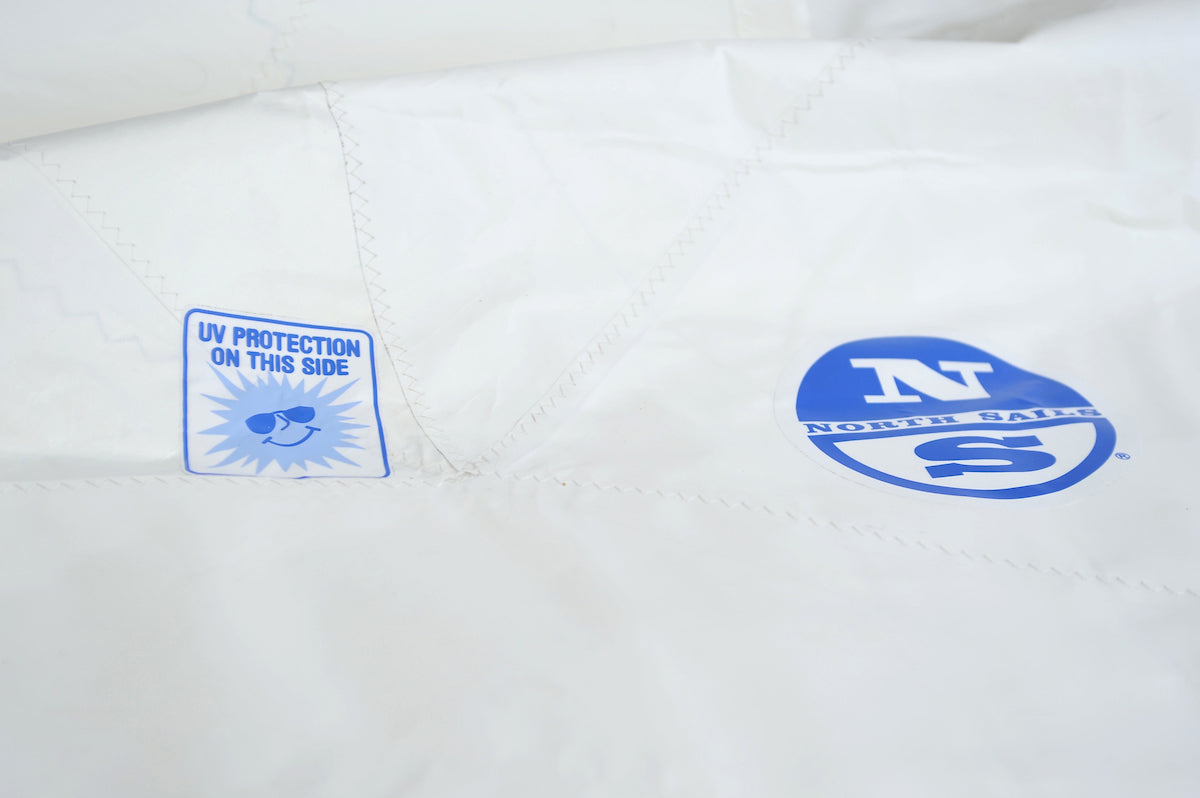
Consejo North Sails
CONSEJO NORTH SAILS
El uso y el mantenimiento son dos de los principales factores que definen la vida de una vela.
📸 Michael Egan
Asegurarnos de que las velas son utilizadas en el rango de viento para el que fueron diseñadas garantiza su longevidad y, consecuentemente, mejora nuestra satisfacción y protege nuestra economía. Por ejemplo, dejar una vela izada en un chubasco durante 30 minutos equivale a 50 horas de crucero normal.
Resulta también imprescindible revisar las velas regularmente, lo que nos permitirá detectar pequeños problemas que tratados a tiempo evitarán grandes daños y costosas reparaciones. Y cuando la temporada llega a su fin, nada mejor que una visita al Servicio Oficial North Sails, donde los mejores expertos evaluarán la salud de nuestras velas y nos propondrán las mejores soluciones para prolongar al máximo su vida útil.
READ MORE
READ MORE
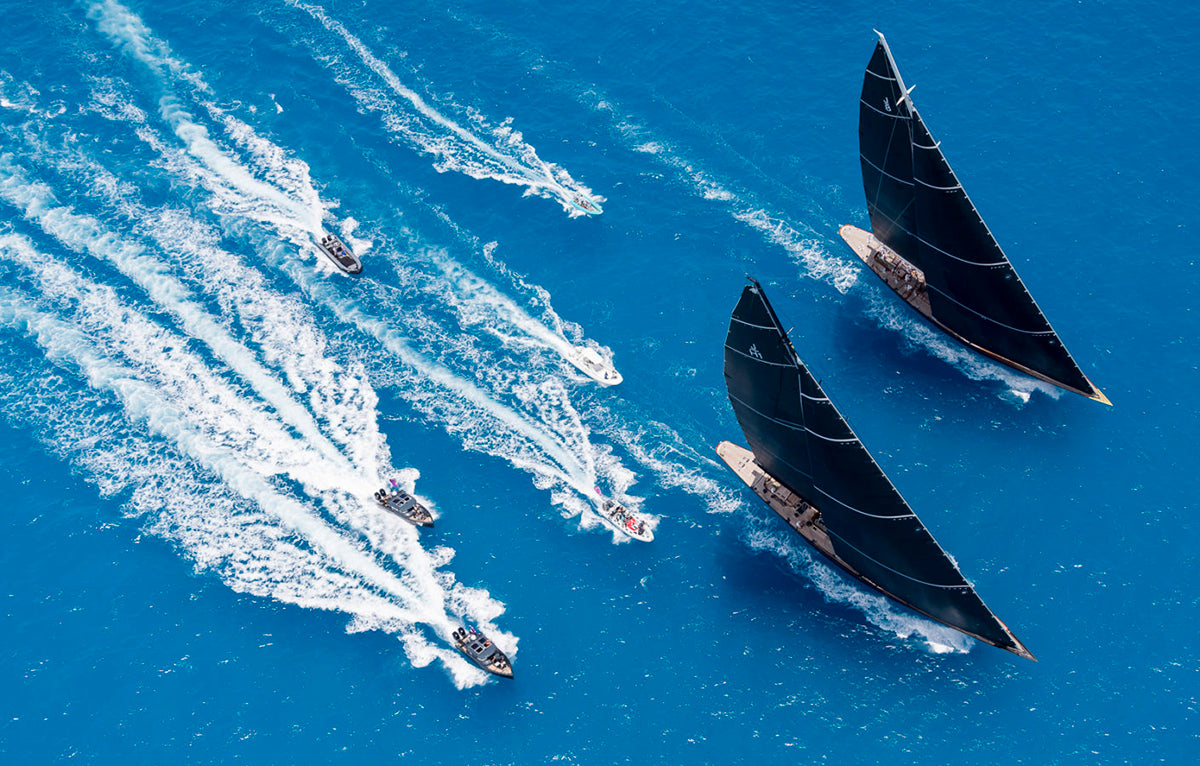
NORTH SAILS PROVEEDOR OFICIAL DE J CLASS
NORTH SAILS, PROVEEDOR OFICIAL DE
J CLASS
La J Class Association renueva su confianza en North Sails como proveedor oficial de velas.
📸 Carlo Borlenghi
Louise Morton, secretaria de esta asociación nacida en 2000 para preservar los intereses y el futuro de los J Class, explica: "North Sails continuará proporcionando su servicio de velería en los eventos y ayudando a promocionar nuestra clase. Los comentarios de nuestros armadores son unánimes al afirmar que la experiencia en diseño de North Sails, su red mundial de velerías, su excelente servicio y sus productos de última generación, contribuyen a que la competición sea más intensa e internacional".
READ MORE
READ MORE

TE AIHE YA ESTÁ EN EL AGUA
TE AIHE YA ESTÁ EN EL AGUA
Emirates Team New Zealand botó el pasado mes de septiembre Te Aihe, el AC75 con el que defenderá la próxima America’s Cup.
📸 Emirates Team New Zealand / Grant Triplow
En su condición de proveedor oficial de velas del equipo, North Sails trabaja en el desarrollo del inventario que permitirá volar al barco neozelandés.
"Históricamente, un ciclo de America’s Cup marca la próxima generación en evolución de velas, y esta vez no es una excepción", declara el presidente de North Sails, Ken Read. "Estamos a punto de presenciar una de las mayores transformaciones que ha recibido nuestro deporte". En el desarrollo de las velas del AC75, los diseñadores han recurrido al North Sails Design Suite, destacando una mayor con sistema de doble capa. Todas las velas del equipo serán finalizadas en la velería de North Sails en Auckland.
READ MORE
READ MORE

CAMPEONES DE EUROPA DE MELGES 20
CAMPEONES DE EUROPA DE MELGES 20
El campeonato del mundo 2019 de Melges 20 se disputó del 11 al 14 de septiembre en la localidad italiana de Malcesine.
📸 Zerogradinord
El Brontolo Racing del patrón y armador Filippo Pacinotti fue el mejor de los 37 equipos participantes, proclamándose campeón de Europa 2019. El mallorquín Manu Weiller ejerció de táctico del equipo junto al trimmer Federico Michetti y el proa Andrea Pacinotti (hijo del armador).
"El inventario North Sails de Melges 20 es eficiente y fácil de trimar", reflexionaba tras el triunfo el patrón italiano. "Desde las velas al servicio, creo que la velocidad que mostramos durante el campeonato fue una buena demostración de su calidad". El Brontolo Racing compitió con mayor North Sails Mi-2, foque Ji-4 y spinnakers V4-2R y R-2. La propuesta de North Sails para clase Melges 20 está disponible aquí.
READ MORE
READ MORE

AZZURRA GANA LAS 52 SUPER SERIES 2019
AZZURRA GANA LAS 52 SUPER SERIES 2019
El Azzurra se ha proclamado campeón de las 52 Super Series 2019.
📸 Nico Martínez
El barco armado por la familia Roemmers y patroneado por Guillermo Parada confirmó su cuarto título absoluto en la regata Audi 52 Super Series Sailing Week disputada en Porto Cervo, última prueba de la temporada para el circuito de monocascos más competitivo del mundo.
Al barco italiano le bastó firmar la segunda plaza en este evento (por detrás del Sled, también equipado con North Sails) para llevarse la corona, que se une a las conseguidas en 2017, 2015 y 2012. El diseñador Juan Garay está detrás del inventario de velas North Sails a bordo de Azzurra, una de las claves de esta importante victoria.
READ MORE
READ MORE

NORTH SAILS CON THE NATIONS TROPHY
NORTH SAILS, CON THE NATIONS TROPHY
La segunda edición de The Nations Trophy reunirá en Palma
La segunda edición de The Nations Trophy (8-12 de octubre) reunirá en Palma a los mejores equipos de monotipos Nautor’s Swan en un formato único que promueve la competición entre naciones.
North Sails colabora con el evento y equipa a la gran mayoría de la flota en las cuatro clases participantes: ClubSwan 50, Swan 45, ClubSwan 42 y el nuevo ClubSwan 36, que realizará su esperado debut mundial en competición. Nada menos que 41 barcos en representación de 14 países competirán por este último evento de la temporada ClubSwan, que erigirá además a los campeones del mundo de ClubSwan 50 y Swan 45, y al campeón de Europa de ClubSwan 42.
READ MORE
READ MORE

NORTH SAILS PRESENTA SU TECNOLOGÍA HELIX EN EL SALÓN DE BARCELONA
NORTH SAILS PRESENTA SU TECNOLOGÍA EN EL SALÓN NÁUTICO DE BARCELONA
North Sails participa en el Salón Náutico Internacional de Barcelona con un catálogo en el que destaca su nueva HELIX.
North Sails participa en el Salón Náutico Internacional de Barcelona (9-13 de octubre) con un catálogo en el que destaca su nueva HELIX, la gama de velas sin cabo antitorsión que está revolucionando el mundo de la competición, pero que también está disponible para barcos de crucero.
El origen de las velas HELIX se encuentra en la vela de alta competición. Los equipos de la 34 America’s Cup se dieron cuenta de que el diseño de sus potentísimos catamaranes implicaba unas cargas extremas sobre las velas de proa 3Di. North Sails ideó una solución en la que esas cargas fueran redistribuidas desde la jarcia y repartidas por toda la vela. Nacía así la Load Sharing Technology (Tecnología de Reparto de Cargas), un concepto que ha permitido la creación de las velas sin cabo antitorsión North Sails HELIX.
"Se trata de velas más ligeras y que navegan mejor", resume Luis Martínez Doreste, director comercial de North Sails. "Son además más versátiles, ya que cubren desde un través cerrado con poco viento hasta un largo con viento fuerte". Literalmente, cubren el espacio entre velas de proa y spinnakers. Son enrollables, su propia estructura hace que no necesiten cabo antitorsión y se proyectan hacia delante, creando un mejor ángulo de entrada y permitiendo navegar con un rango de viento más amplio. "Una vela HELIX se proyecta hacia delante y hacia barlovento, frente a la comba a sotavento de una vela convencional con cabo antitorsión".
Desde su incorporación al catálogo North Sails, las velas HELIX han demostrado su potencial tanto en competición como en navegación de crucero. Pueden combinarse con materiales 3Di DOWNWIND y NPL DOWNWIND, y están disponibles para barcos de prácticamente cualquier eslora, desde IRC medio a maxis de 100 pies o superyates. "Para barcos de crucero suponen un excelente activo, porque añaden a las prestaciones y la fiabilidad del 3Di o del NPL, la ligereza y facilidad de uso por prescindir del cabo antitorsión".
El equipo North Sails te espera en el Salón Náutico de Barcelona: Moll de la Fusta, Pabellón 2, Nivel 0, Stand C330.
READ MORE
READ MORE

TOUR OF MICHIGAN SERVICE COLLECTION
TOUR OF MICHIGAN
We're Coming To You For Sail Service
Our team is making it easier than ever to get your sails in for winter service! Your sails have done a lot this season and it's time for some annual TLC! Meet Karl Kuspa at the following areas to collect sails for annual servicing.
Pick Up Times & Locations
Port Huron, Michigan | October 25th from 6-8pm | Port Huron Yacht Club
West Michigan, Muskegon to Breton Harbor | November 1st - 3rd | Call or email to schedule pick up
What Does This Include?
Your sails will receive our trademark 10 point inspection:
Inspect head, tack, clew and reef attachments. Inspect webbing & hardware for chafe and UV damage. Inspect hand stitching.
Inspect luff tapes and luff attachments.
Inspect for chafe at external hardware contact points at spreaders, shrouds, stanchions etc.
Inspect leech line, foot line and attachment system.
Inspect sail for UV damage and proper furling side (if applicable).
Inspect batten pocket ends, attachments and fit (if applicable).
Inspect sail body for condition of cloth, seams, sail numbers, draft stripes and windows. Replace or add telltales (complimentary).
Inspect miscellaneous gear: Spinnaker Snuffer line and hoop, mainsail external flaking system, headsail vertical battens, UV covers, etc.
Inspect sailbag draw string, zippers, web straps, and label properly.
Sail report, 10 checkpoints, comments
One Year Free Sail Care
Recently purchased a sail within the past year? Congratulations - not just on your sail but also your sail qualifying for One Year Free Sail Care; another standard from North Sails. We proudly offer one year of sail care and repair free with the purchase of a new Cruising, Club racing or One Design sail. This program is honored anywhere in North Sails worldwide network of sales and service locations.
Annual Inspection
Annual inspection of your sails will help extend the sail life and maintain performance, don't compromise! When your sails arrive, a member of our service team will thoroughly inspect your sails and identify any maintenance issues with recommendations on how to proceed to maintain their longevity. This service is standard across any North Sails loft due to our unmatched worldwide network means you get the same quality service whether you’re at home or in a distant port. Recommendations regarding UV replacements, re-cuts and sail washing are available; we do it all!
Expertise At Your Fingertips
Beyond this, the crew at North Sails Detroit are available to help with all your related sail care needs! You can speak with Karl, Skip or Spencer about upgrading your sails or with Bill and Mike on how to best take care of your sails including short and long term storage. Beyond sails, Bill and Mike are excellent craftsman who have great skill in canvas work such as bimini's, dodgers or custom projects.
If you would like to schedule a pick up, email detroit@northsails.com
READ MORE
READ MORE

NORTH SAILS CERTIFIED SERVICE
North Sails Certified Service
Dette er tiden for sjekk av seil
Når service tas på dine seil, er vårt fokus å ikke bare reparere synlige skader, men også å oppdage slitasje som vil gi fremtidige skader.
Et skadet seil når du er ute og seiler, vil alltid være en dårlig opplevelse. Kanskje den også vil føre til avbrutt seilas, ventetid og større kostnader. Derfor er det helt vesentlig at seil vi får inn til service blir sjekket grundig.
North Sails Certified Service innebærer at den dyktigste seilmakeren vurderer ditt seil, at vi har et bredt utvalg av reparasjonsmateriell og en bred maskinpark.
Hos With Marine er dine seil i de beste hender:
Øyvind Thoresen, seilmaker i 30 år og service manager, full tid.
Margrete Helle, seilmaker i 18 år som jobber heltid med seilservice.
Nick Willetts, seilmaker og rigger i 27 år (WOR erfaring), driver til daglig vårt riggeverksted i Drøbak, men trekkes inn når det er mye å gjøre på loftet.
Christen With, seilmaker i 30 år, bistår med sin kunnskap og erfaring på utfordrende jobber.
Lever dine seil nå til:
Oslo-området: With Marine AS, Leangbukta 31, Asker, (avlevering utenom åpningstidene under ny kran utenfor seilmakeriet, se bilde).
Drøbak: Heiberg Rigg/ With Marine, Heitmann Marin, Husvikholmen
Stavanger: Ship Shape, Sølyst 1, 4085 Hundvåg v/Stavanger Seilforening
Bergen: Nautic Charter, Hjellestad
With Marine AS, Leangbukta 31, Asker
Ikke bare seil
Rigg og seil er to sider av samme sak. Vi har også riggere som holder samme høye kvalitet som våre seilmakere. Nøkkelen til kvalitet i service av din rigg, er at riggeren er 100% rigger. Han treffer du hos oss.
Hente seil på båten
Det kan være fint å få en seilmaker ombord for å ta ned seilene og bringe de til loftet for tørking, service og lagring.
Bestille henting: info@withmarine.no
READ MORE
READ MORE
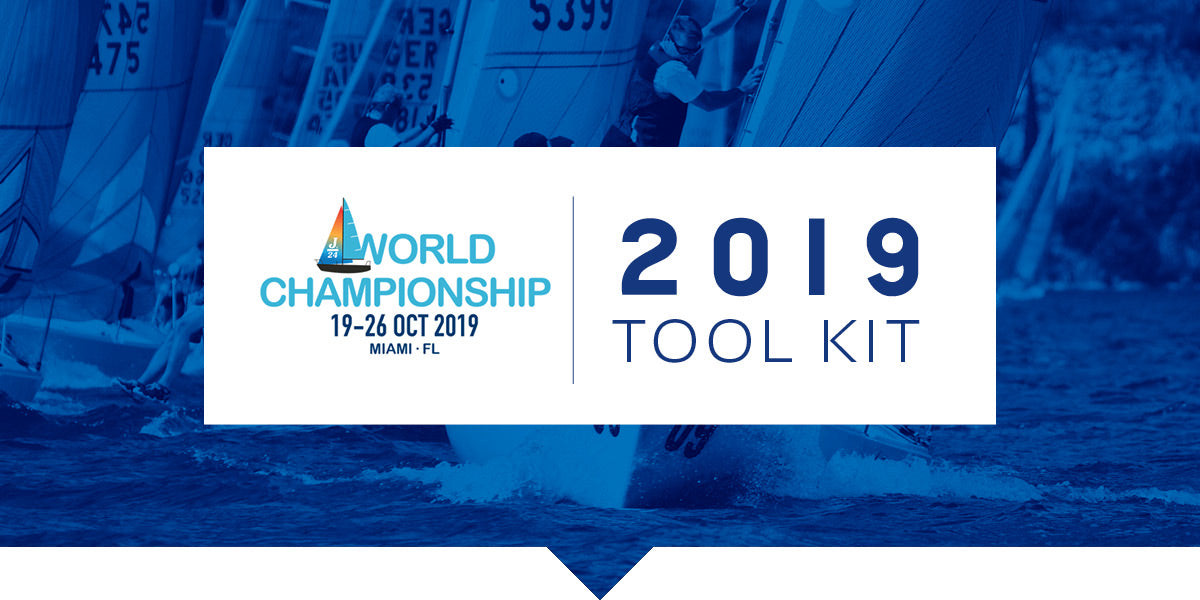
2019 J/24 WORLDS TOOL KIT
Get The Most From Your J/24
The 2019 Worlds are just around the corner. Is your team ready? Our J/24 Tool Kit will help.
Scroll down for tips about boat speed, tuning, shifting gears, jibing in breeze, and much more. Created just for J/24 sailors, by our team of experts.
Get To Know Biscayne Bay
To help you prepare for the 2019 Worlds, we asked the local Star and Snipe World Champion Augie Diaz to explain about his home waters of Biscayne Bay in Miami, FL.
How The 2018 Worlds Were Won
It may not be Lake Garda, but Miami could serve up some similar conditions where tuning and sail selection comes into play. We can expect a little bit of everything at the 2019 Worlds, and you may see some recurring themes from Garda that find their way to Biscayne Bay.
Shifting Gears
Two-time North American Champion and North Sails expert Mike Ingham explains how to shift gears when pressure is unpredictable.
Fine Tune With North
Find your groove. Get your numbers. After countless hours of sailing, sail testing, and competing in the J/24, our World Championship winning sails will get you up to speed quickly with our newly updated tuning guide and matrix.
Jibing With Authority
The key to perfect jibes is practice, practice, practice. Get the play-by-play on how to execute a jibe with success.
#NSVictoryList
There is no better performance test of a one design sail than the results it produces. In 2019 alone, North Sails J/24 inventories have powered many teams to the number one spot all over the globe.
Let us help you achieve your end goal.
Building Your Confidence In Breeze
Windy day ahead? Here are 10 tips to help you conquer those days at the top end of the genoa’s range.
Videos: Get Your Team Up To Speed
World-level preparation works for smaller regattas too. Before your next regatta, watch our video tips from Tim Healy and Will Welles.
Preparing For A Big Event
Will Welles talks us through boat prep, tuning, how to put together a winning team, and regatta logistics.
Define Your Speed
Pulling all the pieces together can be challenging. Our J/24 Speed Guide will help you leverage our expertise to make the most of your sailing.
Common Questions, Answered
We respond to 13 of the most frequently asked questions about racing a J/24 well.
Trust In Our Expertise
We’ve been winning in the J/24 since the class started, and we can help you win too. Contact your local expert, check out our inventory, and join us at the front of the pack.
READ MORE
READ MORE

NORTH HELIX POWERS IMOCAS
NORTH HELIX WITH LOAD SHARING POWERS IMOCAS
North Head of R&D Gautier Sergent Explains Why Helix Is Delivering Results
📸 Jeremie Lecaudey / BPCE / Défi Azimut
The newest generation of foiling IMOCAs are fast, exciting, and awe-inspiring. North Sails is helping six new IMOCAS, as well as older boats which have foil upgrades, prepare for the 2020 Vendee Globe, and the addition of Helix has reset the offshore performance benchmark.
We called up Gautier Sergent, North Sails Head of R&D, who works closely with the IMOCAs. Gautier explained that as the sailors learn just how hard they can push these machines, Helix is raising expectations even further than expected.
Hi G. Thanks for taking the time to chat with us. What are your first impressions of Helix sails for the IMOCA so far?
Immediately the potential of these sails is noticeable. IMOCA boats are limited in their rigging loads with the One Design rig, and this is where Helix excels. The best test so far was the Defi Azimut where North-powered teams, all sporting Helix sails, claimed the top four spots.
Helix is not new for North Sails; we have made a few hundred sails and we weren’t jumping into the unknown. But it’s still early stages of this next Vendee cycle and we keep learning about the boats, the sails, and how to best adapt the Helix concept to each sail type and different conditions. Gautier and the France-based North team have spent countless hours working alongside the yacht design teams on perfecting the models to understand the requirements. It is now time for the much-awaited reality check. As the IMOCAs will be used solo in the Vendee and then crewed in the Ocean Race, we’re focused on understanding things you can handle solo vs. what you can do crewed; parameters which are hard to capture in the numerical world. It is not a question of Helix or not Helix, it’s developing the right sail for both types of sailing. Our question is, how much Load Sharing do we put into each of these sails; the fine details of depth, draft, luff round, luff rope, etc.
📸 © Amory Ross / 11th Hour Racing
Can you describe Load Sharing Technology in your own words?
Load Sharing is how much load we design the sail to carry versus how much the luff rope or forestay takes. It sounds simple and it is simple. The trick is to find the proper ratio for the intended use and how this affects the sail shape. You also need to find the right luff rope stiffness so it interacts with the flying shape through the range of conditions.
Why is Helix with Load Sharing beneficial for an IMOCA program?
We knew that Helix would suit the IMOCA for a few reasons. First, Helix covers a wide range of expected conditions for a given sail. Sail changes in the IMOCA are very expensive, as we saw in the recent Defi Azimut. With Helix, you can focus on boat speed across the wider range and not lose miles because of costly sail changes.
The second reason is the load limit on the One Design rigs as opposed to the virtually limitless amount of righting moment the foils can generate. The more load we can move into the sail, the more beneficial it is when the boat is up on its foils as this limits the load on the rig without affecting the resulting sag of the luff.
And finally, with the dynamic nature of these boats, it is important to have very little sag so the flying shape is locked in, and converts any change in AWS into forward, not side force. Because the IMOCA boats are not allowed to have any elevators, sailing in an offshore sea state makes for a rodeo-like a ride; sharp accelerations followed by just as sharp decelerations, and very dynamic pitch and roll. Keeping the sail forces projected forward quiets the boat motion and makes for faster average speeds.
What performance gains does Helix deliver?
SPEED! SPEED! AND MORE SPEED!
Helix brings versatility and trim-ability through reduced tack load, so you can adjust the flying shape to your conditions. The IMOCA class has a sail inventory of just eight, and sail changes are very expensive, especially as the boats are much faster than the previous generation at some angles. Miles tick away when you sail 90 degrees from the course and your friends are on course doing 25+ kts…
3Di is particularly suited to Helix because of its unmatched stretch-to-weight ratio. A small adjustment makes for a noticeable change in flying shape. It is also able to handle the high loads while keeping the sails light. Not to mention the high resolution of fiber orientation and density to handle secondary off-axis load when furling.
The other major parameter is that the boats have to work in displacement (non-foiling) mode as well as on their foils. That means big changes in AWS (and to some extent AWA). Helix sails provide steady power to the boat, keeping you sailing fast on average rather than a burst of speed and then crashing off your foils.
What’s up next for the IMOCA class and how is North Sails helping prepare our clients?
The next big test will be the Transat Jacques Vabres, which begins at the end of October. This will be the first proper offshore race for the new IMOCAs and their new foils and the older boats with their retro-fitted foils.
The new sails have been put through their paces throughout the summer with a few training camps, and a first real test at the Defi Azimut. Our North team in France have been doing a lot of sailing with the teams to help them dial in their understanding and performance of the Helix Sails, and also to fine-tune the sail to their own boats. All this work helps North Sails better understand how the boat behave in real-life and in various conditions. We have collected some sailing data, exchanged with the sailors, identified some gains and things to improve, and recalibrated the models to work on squeezing out extra percent of gains. The North service team has been all hands on deck, going through sails for a simple check over and final tweaks.
The TJV is a major race and a highly sought after prize, but it is only a stepping stone on the road to the Vendee Globe. So for us and teams alike, the idea is to make sure we capitalize on this precious racing time. The race is double-handed so the boats can be sailed reasonably aggressively and with a slightly smaller penalty on sail changes.
📸 Jeremie Lecaudey / BPCE / Défi Azimut
READ MORE
READ MORE

AZZURRA ON TOP OF 52 SUPER SERIES
AZZURRA ON TOP
This is Their Fourth Overall Season Win In the 52 Super Series
📸 52 Super Series / Nico Martinez
At the end of the final TP 52 Super Series event in Porto Cervo, it was Azzurra sitting on top of the podium. North Sails is proud to have played a part in this big win, says Grand Prix sales leader Paul Westlake.
“As predicted, this season was the closest on record,” explains Westlake. “Every inch counted.” The season had three distinct highlights, he continues. “One, the 2019 Worlds, where first through third were separated by just three points. Two, Sled winning five straight races here in Porto Cervo. And three, Azzurra securing the circuit win with one race to spare! All proud moments for everyone who played a part.”
Only two teams have won the Super Series since its inception, and this is Azzurra’s fourth season victory. Even better, all ten of the teams who worked with the North Sails group of designers and Grand Prix racing experts achieved great results throughout the season.
“2019 was the most competitive and equally matched season,” remarks Azzurra skipper and team manager Guillermo Parada. There was not one team that had a big competitive edge, and the results were decided by minor details. Our focus was on the meters we could gain on the race course and positing ourselves well. All of the boats were capable of winning every race, but our team delivered a well-executed game plan.”
“The key to winning the season was consistency,” says Azzurra’s tactician Santiago Lange. “The competition in this fleet is intense because the boats are well-matched in terms of speed and quality of the sailors. In the end, the winner of the season is the team that can deliver the most consistent results.”
📸 52 Super Series / Nico Martinez
Azzurra did not have a lot of big wins throughout the season, explains Lange. “But we have a good boat, which performs well in any condition and wind speed. We were always able to secure one of the top positions anytime we were on the water, Every single day, we have enough speed to get the points needed to stay on top.”
Lange and Parada know that having the right people will deliver the best results. “The team is also on the same page in terms of how we approach each race, Lange says. We have a lot of experienced sailors on the boat who bring a good perspective. The Super Series is a long season, and it’s important that everyone has the same understanding of the game.”
“We have a good team who have been sailing together for a long time,” explains Parada. “Consistency of crew is not something that is immediately noticed but its impact is felt throughout the season and in our ability to continually sail well. In 2018 we promised ourselves we were to do better. Our biggest challenge now is defending out #1 bow in 2020.
It’s also important to have the right sail designer, and Juan Garay has been working with Azzurra for several years. “The TP52 is very demanding on sails,” explains Lange. “On a normal day we will use two or three jibs, so we’re always speaking with Juan on how to keep our sails competitive.” A daily feedback loop helps review strengths as well as areas of improvement. “We’re constantly thinking ahead as to how we’re going to spend our sail cards in the most efficient way.”
For North Sails, this feedback loop is how we learn, improve, and continually look to the next development that will give all our clients a competitive edge. The worldwide North design team has already begun a full design debrief of the 2019 season, in order to take the developments learned in 2019 forward to next March when the 2020 Super Series meets for the first time in Cape Town. “Next year the racing will be even tighter,” Paul Westlake predicts, “and we’ll be ready again to take on the best in the world.”
📸 52 Super Series / Nico Martinez
📸 52 Super Series / Nico Martinez
READ MORE
READ MORE

J/70 NORTH AMERICANS CLOSES THE SEASON
J/70 NORTH AMERICANS CLOSES SEASON
North Clients Finish 1,2*,3,4,5
Oivind LorentzenTeam Nine, 2019 North American Champions 📸 Chris Howell/J70 Class Association
The 2019 J/70 North Americans hosted by Edgewater Yacht Club in Cleveland, Ohio went off without a hitch, with ten races completed for the talented 35-boat fleet. North client Oivind Lorentzen sailing on Nine with teammates Lucas Calabrese, Ian Coleman and Will Felder won the title displaying great boat speed and consistency. North powered boats finished 1,2*,3,4,5, closing out the season with a bang. North clients have won all major J/70 events in 2019 – the Worlds, Europeans, North Americans and so far nine countries have reported National victories.
Here are important takeaways from our experts Skip Dieball and Allan Terhune from the NAs:
Starts
Working hard to maintain spacing is very important to getting a good start. The exit runway needs to be bigger in waves and hitting the line at full pace and on proper course is essential to getting poked out on the fleet and having options to implement your upwind strategy.
Upwind
Be sure to study the waves pre-start. Are they the same on each tack? Do you need to set up your trim different from tack to tack? Controls? Twist on one tack vs. the other? You gain considerable knowledge getting to the course early and figuring things out before the gun goes off.
Downwind
Always have eyes out of the boat looking for the best pressure. Many times at the NA’s there would be streaks of puffs that you’d have to reconnect if you sailed through. Dropping on the wing, fully gybing and soaking often would keep you in the best breeze longer. If you are on the step, it is essential that you prepare for the next gybe by connecting into a puff that is behind and to leeward.
Knowing Your Mode was key. The North Americans had a lot of days of full planing, lazy planing, and going wing-on-wing. Knowing when and how to do each mode allows huge downwind gains.
Sail Combos
The top three North boats all had different main and jib combos, proving our sails are user friendly and made to fit any style of sailing. North J/70 sails suit any sailing and tuning style and are fast in all wind conditions. Nine used XCS-2 mainsail and J-6 jib. Rimette had the F-1 main and J-2HC jib and Vineyard Vines used F-1 main with the J-6 jib. Each boat was able to pick a main to match their mast and then choose if they wanted the more forging J-2, or the J-6 which would allow for more inhaling.
Contact our J/70 experts for the best sail combo for your team.
* Partial North Sails inventory
3rd place John Brim and Team Rimette powered by North F-1 main and J-2HC jib 📸 Chris Howell/J70 Class Association
4th place John Baxter and Team Vineyard Vines flying fast downwind. 📸 Chris Howell/J70 Class Association
5th place Brian Keane and Team Savasana.📸 Chris Howell/J70 Class Association
READ MORE
READ MORE

ZA MALO FOLLOW US PO 21. PUT!
Za malo Follow us po 21. put!
Galijola je još jednom dokazala da je neiscrpan izvor drame i prevrata uz konstantnu dozu strepnje i neizvjesnosti u svakoj svojoj dionici, bilo da je ruta kompletna do hridi Galijola ili u skraćenom izdanju do svjetionika Zaglava.
Jednako kao i lani, ruta je skraćena zbog nepovoljnih meteo uvjeta, ali ovaj put je u pitanju bilo premalo vjetra za razliku od lanjskog izdanja kad je vjetra bilo previše. Unatoč uvjetima koji su dozvoljavali svladavanje zadane rute mnogim manje spremnim jedrilicama i posadama, na kraju je startna lista bila vrlo slična lanjskoj, a popis onih koji su odjedrili kompletu rutu bio je veći za samo jednu jedrilicu.
Start je bio klasičnog tipa, apsolutni minimum gibanja zračnih masa do obaveznog obilaska bove ispred Slatina, a tada s olujnim refulima od nekoliko čvorova svi su bježali od Istre prema sredini kanala. Recept koji i ovog puta nije dozvolio da vidimo bi li se netko kockarski odlučio na izbor rute uz Ičiće i Lovran.
Dvadeseterostruki pobjednik najstarije Hrvatske odobalne regate, Ivica Ščurić, bio je na čelu flote sa svojim ultra lakim karbonskim bolidom "Follow us". Uvjeti su mu bili naklonjeni i mnogi su prognozirali razvoj situacije na regatnom polju u njegovu korist. Međutim, njegov proboj je bio nezaustavljiv do visine Ičića kad je izašao iz zone povjetarca u kojeg su tada ušle ostale jedrilice. Follow us se prisilno zaustavlja a potjera ga ubrzo okružuje i regata tada starta iz početka. Jedino što im je broj sad manji jer se jedan dio flote vratio u lučicu JK Opatija nakon što su ispunili jedan od uvjeta za korištenje klupskog veza (startanje Galijole).
Dva sata nakon starta DSK, Tara I, Bokeljka i Follow us se izdvajaju i sinkroniziranim stilom odlučuju još par kabela izvući van i to im je izgledao vrlo dobar potez petnestak minuta dok svi ostali koji su naumili odjedriti cijelu rutu nisu krenuli jedriti višestruko većim brzinama s vjetrom koji je puhao bliže kopnu. Ovu skupinu je predvodio Cocoon koji se strelovito probio na vrh praćen s Bella Nostrom i My Wayom. Međutim, taj svježi vjetrić stiže i do izdvojenog kvarteta od kojeg se furiozno odvaja Follow us koji se vraća prema kopnenoj masi i ponovno preuzima vodeću poziciju.
To su trenuci u kojima se uspostavlja poredak koji je manje više nepromijenjen u nastavku regate i u kojem je budući pobjednik regate, DSK, skoro na začelju flote. U to vrijeme najveći gubitnici su posade jedrilice Sanja i Quodlibet koje je vjetar preskočio i silom prilika moraju čuvati posljednje dvije pozicije.
Do Zaglava uvjeti na moru su takvi da Follow us jedino treba koncentrirano pokrivati ostatak flote i parirati Cocoonu koji im je bio najbliži.
Najveći dobitnici u ovoj fazi regate su momci s DSK koji se sa začelja skupine kontinuirano probijaju prema vrhu, a klupski im kolege s Bella Nostre sve više zaostaju za svima i suočavaju se s činjenicom da se sve više udaljavaju od bilo kakvih izgleda za neko od mjesta na pobjedničkom postolju.
Malo iza 4 sata ujutro vječni favoriti ove regate prvi obilaze svjetionik Zaglav. Prate ih Cocoon i DSK koji se na samom okretu uspio probiti na drugo mjesto ukupnog poretka.
Vrlo brzo DSK nastavlja svoj nezaustavljivi prodor i par milja nakon Zaglava na par minuta preuzima vodstvo. Ali turbo iskusna posada s Follow us dokazuju da se nisu predali i da i dalje imaju ozbiljne namjere po pitanju osvajanja regate te se vraćaju na vrh.
Za to vrijeme posade Selca i Bokeljke primijećuju da su svi ostali upali u zone dosta slabog vjetra, pa biraju kurs bliže Cresu, To se pokazalo dobitnom kombinacijom i preuzimaju vodeće pozicije s popriličnom prednošću u odnosu na dotadašnje lidere. Ali dolazimo do "međutim" po tko zna kojeg puta u ovoj regati. DSK i Follow us prate situaciju i prebacuju se i oni bliže Cresu te krenu s hvatanjem priključka za Selcima i Bokeljkom.
Dok su se oni nadmudrivali uz Cres, posada Tare I bira prolazak bliže Istri. Pokazuje se da je tu više vjetra, pa su se vjerojatno nade u dobar plasman vratile i na njihovoj palubi.
Vodeći uskoro stižu u visinu Medveje koja se skoro postala novi filtar...
Jednako napeto i stresno se nastavlja i idućih 5-6NM koliko je ostalo cilja, a kako je posada DSK više nego zasluženo pobijedila regatu sa samo nekoliko duljina broda prednosti ispred Follow us najbolje da izanalizirate preko playbacka koji se s kompletnom multimedijalnom analizom regate nalazi na ovom linku.
Službene rezultate i poredak po skupinama možete pronaći na ovom linku.
READ MORE
READ MORE

QCYC WOMEN'S SKIPPER REGATTA
EVENT SPOTLIGHT: QCYC WOMEN SKIPPER'S RACE
Encouraging Women To Take The Helm
© Don Hinchley / P. Broecker
On Saturday, August 10th, the women of Queen City Yacht Club (QCYC) set out to show off their skills on the race course. The conditions presented were challenging, forcing the skippers to sail in a little bit of everything. With the wind coming down the course in puffs from the north west, the conditions were very shifty. The skippers started in the harbor before heading out through the eastern gap. Once out there, they sailed out along the island and across to the pier to round the Gibraltar mark before heading back through the eastern gap to round a mark in the north-eastern corner of the harbor before finishing just off of the QCYC clubhouse. While the wind flowed off the island, it provided some fantastic conditions out of the harbor for racers. While traveling through the eastern gap, the skippers had to be patient and adjust to the wind shifts, making things extra challenging. In true QCYC fashion, the skippers and crew rose to the challenge and had tremendous success on the race course.
Following the race, the skippers were rewarded with a party on the QCYC lawn. Awards were presented to the top finishers overall, as well as the top three in each class. In addition, QCYC recognized skippers for a variety of accomplishments, including the best showing for an all-women crew and the best showing for a first-time skipper. The event was a great success, in no small part because of the continued support we receive from sponsors such as North Sails. Thanks to the volunteers and our sponsors, QCYC is able to put on this event year after year and continue to encourage women to take the helm and get involved in this great sport.
For more details about the regatta, including race results.
© Don Hinchley / P. Broecker
© Don Hinchley / P. Broecker
© Don Hinchley / P. Broecker
READ MORE
READ MORE

NORTH SAILS JOŠ JEDNOM SLAVIO NA LATINSKOM IDRU!
North Sails još jednom slavio na Latinskom idru!
22. regata tradicionalnih brodova s latinskim idrom odjedrena je u nedjelju 29. rujna i na najljepši mogući način završila ovogodišnji ciklus navigacijskih jedrenja drevnim stilovima.
Čak 79 kaića, gajeta i leuta, zajedno s jednom batanom, okupili su se na ovom festivalu jednog nostalgičnog i mnogima više nedohvatljivog stila života. Naravno, dio sudionika ovakve regate shvaća i izrazito natjecateljski, pa su im u prvom planu rezultati, priprema, oprema, taktika... sve ono što regatu čini regatom.
S obzirom na značaj Murterskog okupljanja već u petak su počeli pristizati i sudionici iz udaljenijih krajeva Jadrana. Uz standardne sudionike iz svih mjesta s otoka Murtera, te susjeda iz Šibensko-Kninske i Zadarske županije, na rezultatima se mogu pronaći još i jedriličari iz Rovinja, Moščenićke Drage, Opatije, Cresa, Raba, Trogira, Hvara, Jelse i Splita.
Regatno polje je bilo prilagođeno vremenskim uvjetima, nešto kraća varijanta nego na lanjskom izdanju. Start u uobičajenih 15 sati bio je postavljen "na lancanu", konop rastegnut između lanterne na murterskoj rivi s jedne strane i usidrene koče. Svi sudionici su se krmom vezali na lancanu, a prije toga bacili sidra ispred prova.
Nakon signala starta krenulo je povlačenje po sidrenim konopima, otvaranje jedara i jedrenje u krmu prema izlazu iz Murterske luke. Iduća ključna točka na ruti je bila kardinalna oznaka pored otočića Arta mala. Nju je trebalo ostaviti lijevim bokom i zajedriti natrag istim putem prema cilju u Murteru.
Već na startu su se izdvojili brodovi koje smo u istim ulogama naučili viđati na ostalim regatama latinskog idra, a poprilično ispred sviju se izdvojio dvojac koji je i lani predvodio cijelu flotu. Riječ je bila o gajeti Trtuša braće Turčinov i kaiću Marinka obitelji Fržop.
Vrhunsko jedrenje oba tima bilo je izjednačeno sve do obilaska kardinalne oznake gdje je razlika među njima bila svega dvadesetak metara, ali u povratku Trtuša uspijeva napraviti malo veću razliku i u ulasku u Murtersku luku držati desnu, malo vjetrovitiju stranu regatnog polja. Taj odlazak prema Vinicima je prevagnuo, jer Fržopov kaić nije imao izbora već otići lijevo prema Murterskom groblju i pokušati iznenaditi s te strane, ali zavjetrina koju je radila marina Hramina i,ala je svoj negativan utjecaj.
Iza njih u cilj je dojedrila ekipa gajete Sirotice, još jedan favorit regate.
Analizom rezultata može se primijetiti jedna bitna razlika između Trtuše i Sirotice, s obzirom da su obje gajete, a to je da je Trtuša u kategoriji "BM - bez motora". Jednako tako je i Marinki u rezultatima naglašeno da je u istoj toj kategoriji, pa se može vidjeti u kolikoj prednosti je prvi dvojac bio u odnosu na ostale po uvjetima laganog vjetra koji je puhao tu nedjelju u Murteru.
Fotogaleriju s ove regate možete pronaći ovdje, dok su ukupni rezultati dostupni preko ovog linka.
22. Latinsko idro u Murteru je manifestacija koja traje cijeli mjesec, a završetak joj je u nedjelju 6. listopada na sportskoj regati "Gajeta kup".
READ MORE
READ MORE

SENIOR SAIL DESIGNER GLENN COOK JOINS NORTH SAILS
SENIOR SAIL DESIGNER GLENN COOK JOINS NORTH SAILS
The World’s Leading Sailmaker Continues To Attract The Brightest Stars In The Superyacht Industry
Senior Sail Designer and Superyacht Sail Design Expert Glenn Cook will join North Sails from October 2019. After 16 years with Doyle Sails North America as Head Designer, Glenn will play a key role as part of North’s global Superyacht team. He has an impressive track record of leading the design work for some of the most notable Superyachts to hit the water in the last 15 years. Standout projects include the iconic 147 metre Sailing Yacht A, as well as the eye catching 106 metre Black Pearl and 88 metre Maltese Falcon. For Sailing Yacht A in particular, Glenn developed sailing systems over the course of four years in partnership with Dykstra Naval Architects, Magma Structure, Future Fibres, Cachini and Bamar.
As Head Designer at Doyle, Glenn was responsible for the design and engineering of sails for a range of boats, from dinghies to Superyachts. As a Senior Sail Designer at North, he will be focused primarily on the Superyacht market from the outset. Glenn will be charged with bringing his unique experience and skill set to the preliminary design and engineering stages for new Superyacht builds and refits, and importantly acting as a link to the product team to ensure the right sails are manufactured and delivered for each owner.
Commenting on the new hire, North’s Director of Design and Engineering JB Braun concluded, “Glenn joining the North Sails team is another important step in ensuring we have the very best people working on our global Superyacht team. North is known for its groundbreaking 3Di technology and world beating products, but we know that success only comes from the people working within the company. All our product innovations and breakthroughs come from the dedication, hard work and skills of our team. And complete customer satisfaction is our goal. I have no doubt Glenn, with his unprecedented experience and talents, will be a key part of our ongoing commitment to our clients and everyone will benefit.”
The move continues the trend of world class talent in the Superyacht sector joining forces at North, with Commercial Manager, Andrew Schneider also joining from Doyle in 2019. Combine this talent with a number of young rising stars in North America, Europe and Asia-Pacific joining the Superyacht group, the outlook for clients seeking design, product and service support around the world has never looked stronger.
Glenn also has years of experience in software development, so will play a critical role in the further development and optimization of the North Sails Design Suite, with a particular focus on the Flow™ and MemBrain™ programs. The suite of in-house design software is key to analyzing and developing 3Di sail structures to create optimal custom layouts. Glenn’s career as a Head Designer will therefore add value across the entire design and product development process.
Glenn Cook added, “As a long time competitor to North I have followed their product developments and technology very closely. Ultimately I wanted access to these tools and products to better fulfill increasingly complex and demanding superyacht projects. Many of the best minds in sailmaking and sail design reside at North. I am honored to join this team and looking forward to working with such a talented and motivated group of people.”
Glenn will be based in Marblehead, MA and will work closely with international clients, project managers and industry partners to deliver custom sail solutions for many of the world’s most unique sailing vessels.
READ MORE
READ MORE

J/105 CANADIANS GOT IT ALL
J/105 CANADIANS GOT IT ALL
One Of The Best One Design Fleets On The Great Lakes
Fleet 4 Captain for the J/105's, Rod Wilmer, shares his report from the 2019 J105 Canadian Championships held at the Royal Canadian Yacht Club on September 27-29th. A total of 16 boats came out for the event over three days. Heartfelt congratulations to all competitors from the North Sails team!
Once again the J/105 fleet championship produced a great competition amongst the best keelboat fleet on the Great lakes. Congratulations to the RCYC, the race committee and particular the regatta chairman Doug Bullock for putting together a fantastic eight race event over three days in late September.
Mandate skippered by Terry McLaughlin and co-owned with Rod Wilmer and their experienced crew of Sandy Andrews, Ian Howse, Fraser Howell, and Andrew McTavish came through as repeat Canadian Champions leading from the first race onwards accumulating 10 points. Frank McLaughlin’s Starcross with 22 points challenged their rival Mandate throughout the regatta and beat them with superior downwind speed in the breezy race six. Jim Rathburn’s ever-present HEY JUDE rounded out the top 3 with 33 points. Notable finishes from Jamaica Me Crazy (Peter Hall) and Thunderstruck (Andrew Moor) came through the competitive fleet for 4th and 5th place.
Late September on Lake Ontario can deliver a variety of racing conditions and this regatta got it all. Friday started with an AP for an hour followed by a light air race building to winds in the mid-teens for the second race and light wind for the third. Saturday saw stronger winds with a steady 12-16 knots for the first race, however a line squall came in and hit the fleet on the final downwind leg of the second race with a 180 degree shift ending the day for racing. It is a credit to the seamanship of the fleet that the un expected line squall resulted in only minor mishaps and the sailors were able to adjust quickly to the challenging conditions. The last day saw large seas building from the east topping out at 10-12 feet and winds 16 to 18 with gusts over 20 knots for all three of the final races. These were challenging conditions for crews up wind but Ideal surfing conditions down.
The regatta dinner held on Saturday night featured 400 Oysters, shelled in a record time of one hour by one server followed by a Steak Dinner for 140 all included in the entry fee. The legendary reggae musician, Errol Blackwood, provided the night’s entertainment.
A Gold Clean Regatta, for the third time in a row from the Sailors for the Sea, this regatta had it all covered, from responsible dinnerware and reusable signage to refilling water bottle station and paperless race management. Our goal was to eliminate one use plastic and reduce the garbage coming off all boats at day’s end.
Our J/105 fleet is very fortunate to have incredibly generous members who were able to raise an astonishing $29,500 that supports our local Broad Reach Foundation that introduces kids at risk to sailing. The J/105 Fleet 4 Lake Ontario has been supporting Broad Reach for over 15 years. It is an important part of this regatta and our Fleet culture.
North Sails Toronto was thrilled to support the Clean Regatta efforts of the event by donating water bottles to encourage reusable drink ware and reduce the garbage impact. While it was not needed we were happy to provide overnight repair services for racers, just in case!
To learn more about J/105 One Design Products and Services, see here.
READ MORE
READ MORE

WATER CATS FALL REGATTA 2019
WATER CATS FALL REGATTA 2019
Big Turn Out For Local Cat Sailors
© Dean Goodwin
Early this September, local catamaran club Water Rats Sailing Club hosted their annual Water Cats Fall Regatta for 20 cat sailors. Conditions were awesome with good wind and sunshine amongst the gorgeous backdrop of the Toronto skyline. North Sails loves supporting local community events such as this because we love seeing the participation, enthusiasm and dedication from sailors for catamaran sailing.
Thanks to everyone who helped to make this regatta a success. Our dedicated PRO Ralph Glass, power boat captain Jimmy Sabourin, Rob Wessel and his committee boat, Peter Eager and his Canada National Team experience, Olga Veselova Andrew Lewycky, Marvin Coulson and Ted Kerr for meals, JTown sailing Club for support boat, Water Rats Sailing Club, North Sails and Fogh Marine for prizes.Dan Borg who got the Kadafi trophy resurrected, Roy Spencer for registration, Marvin Coulson as Race Chair, Jen Forkes, Stephen Neprily and Benoit Friolet on flags and elapsed time, Paul McHugh, Dean Goodwin and Dinesh Ram on crash boats, and Dean Goodwin for photography!
Thanks to everyone from near and far who came out to make this event a success. Special thanks to Kevin Smith who chartered his boat to a team from Ottawa, and thanks to all out of owners who came to sail with us - from Burlington Beach Catamaran Club (Burlington) and from Nepean Sailing Club (Ottawa).
Congrats to all winners and a special shout to first overall Floris Van Laar, and to Mauro Spagnolo and his crew for winning the largest one design fleet prize, the Kadafi Cup.
© Dean Goodwin
© Dean Goodwin
READ MORE
READ MORE

CUSTOMER SPOTLIGHT: DON CONDIT
A Summer Of Fun And Success
It was a jammed packed summer for Don Condit and his crew aboard his Tartan 4000 Roxy, which is powered by 3Di Endurance Main, Jib and Genoa as well as an AirX A2. Over the course of 4 weeks, Don participated in the Chicago to Mackinac Race, the Bell's Beer Bayview to Mackinac Race and the Biennial Trams Superior International Yacht Race taking an impressive 1st in Class/ 2nd overall in the Chicago Mac Cruising Division, 1st in Class/ 51st Overall* in the Bell's Beer Bayview to Mackinac Race Double Handed Division and 1st in Class/ 1st Overall in the Trans Superior PHRF Division. In all Don raced 875 nm for an elapsed time of 7 days: 5 hours: 51 min: 54sec. This doesn't include the deliveries. We caught up with Don to learn a little bit more about his experience this summer.
How Did You Prepare for Your Season And All The Racing?
As a crew we've kind of been at this for about eight years on this boat. So every year we make a few less mistakes and get a little better, I think.
Have Your North Products Contributed to Your Success? And If So, In What Ways?
Definitely. Our main sail gave us better performance in a wide ranges of wind conditions. We had new North main this year and a new North number three. And then we had a North Genoa that we've had for a couple seasons that's reefable. It's been in a very effective in a wide range of conditions as well. For us, you know we're a Tartan 4000 which is a racer cruiser. I love it because I can sail my wife and I, and our grand-kids, but we can also put eight sailors on do Mackinac races or Superior races and being competitive amongst our peers.
Did Your New Main Perform How You Expected It To?
Well, you know, better light air performance, get a more powerful shaped, the light air. Our boat's a shoal draft boat. You only draw five nine and so we don't have a lot of lifts from our keel. But we're able to sail higher and in lighter areas than we have with our previous main.
For The Mackinac Races, What Is Your Favorite Aspect Of Sailing Those Races?
Enjoying the beauty and the Great Lakes with family and friends.
What Has Made You Choose North Sails Over The Years?
I've been sailing for 50 years and I sailed in college, and North sails have always been the best, the best sails you could get. I even had a chance to do a race with Lowell North one time. A favorite, you know, the best, the best, best sails that you can get.
Where Do You See You And Your Crew Racing In The Next Two Years?
We'd love to compete and perhaps do a Newport Bermuda race. But you know, compete in the Caribbean. I was doing the Trans-Superior race this year was an opportunity to take our crew and boat to a new level and compete in waters that we've never sailed in before and in a wider range of conditions than we've normally seen.
READ MORE
READ MORE

WINTER SERVICE
It's That Time Of The Year!
Bring in your sails for winter service and free storage.
It's that time of year to bring your sails in for their annual check up and winter storage. Your local team offers washing and drying services with an added sail check at no extra cost. Letting us check over your sails will enhance performance and extend their life.
We offer free winter storage in our air-conditioned rooms (dry and heated) until March 2020. Don't leave your sails in the garage or on the boat - talk to us about our storage area at North Sails Italy.
Schedule Winter Service
READ MORE
READ MORE
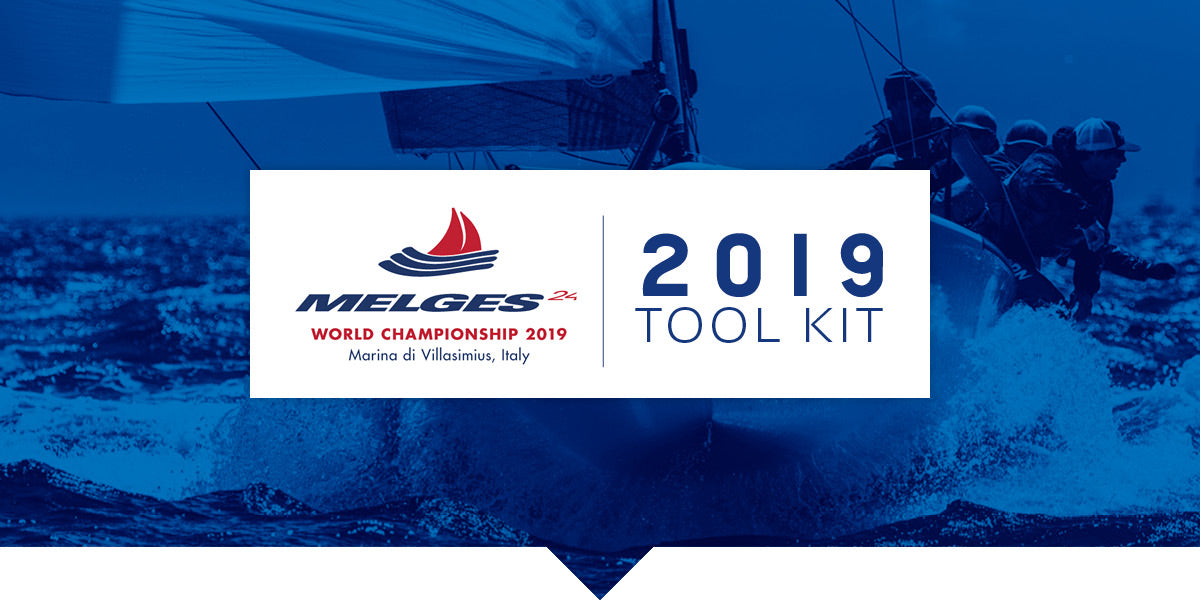
MELGES 24 WORLDS TOOL KIT
Fine Tune With North
Find your groove. Get your numbers. Be confident in all wind conditions. After countless hours sailing, testing, and competing in the Melges 24 our tuning guide will help you achieve race-winning speed.
Raise The Bar With 3Di
Lucky Dog confirms new 3Di sails make a difference in the race course at the Melges 24 North Americans.
What To Expect In Villasimius
Fresh from winning the Pre-Worlds, North Sails Expert Giulio Desiderato provides his intel on what competitors should expect at the upcoming Melges 24 World Championship.
Get Up To Speed
Pulling all the pieces together can be challenging. The North Sails Melges 24 Speed Guide leverages our expertise to help you improve your team’s performance.
World Champions Tips
What worked for Team Altea in the past Worlds? Take a look at the tips from the winning team and get inspired to sail fast.
Our Experts Make It Happen
Have questions? Contact your local Melges 24 expert today for more information on choosing the right sails for your Melges 24.
READ MORE
READ MORE
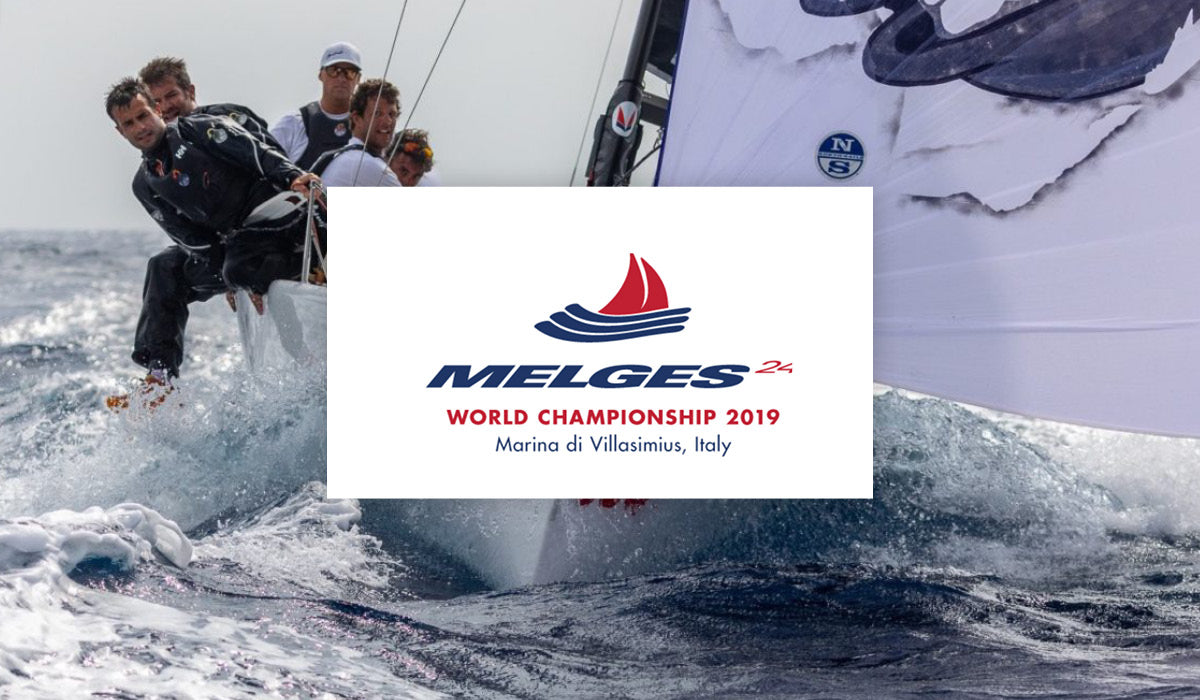
MELGES 24 WORLDS LOCAL KNOWLEDGE
MELGES 24 WORLDS LOCAL KNOWLEDGE
What To Expect In Villasimius
North Sails Expert Giulio Desiderato provides his intel on what competitors should expect at the upcoming Melges 24 World Championship.
It is hard to say exactly what we expect to see at the Worlds. The pre worlds event was my third event in Villasimius this year, and each time I’ve sailed here we’ve had different conditions – a strong Mistral, strong northeasterly with flat water, light sea breeze, big waves, and even one time with wind from the south. Each day at the pre worlds the wind was out of a different direction, so it will be very interesting and we should expect a variety of sailing conditions.
Because Villasimius is not a very common place to hold regattas, there isn’t really any local knowledge as not a lot of people of sailed here very often. This means it will be an open playing field when it comes time for the championship. It could be anyone’s game, which will be exciting.
I’ve sailed here in the tactician role and as main trimmer, and now most recently I’ve coached. What I’ve observed over those experiences on the boat and from the sidelines is that if the wind comes from the North, it will be really important to keep an eye on it and try to figure out which side the newest pressure will fill in.
During this time of year in Sardinia, the wind can be anything. The sea breeze is still common, but because of where Villasimius lies geographically, it is close to a cape and exposed to storms and wind lines that can be frontal and come up quickly.
Tips For Clients:
Manage your risks and get a good start. It will be important to manage your risks with the large fleet. Avoid big mistakes during the starts, and focus on finding a good place to get a clear lane off the line. Ideally, if you can start and sail for three minutes straight before having to make any moves, this will be key.
Keep an eye on pressure. Try to figure out where it’s coming from most often. They may drop the windward mark in an area where the pressure is filling in, which may put you on one particular side of the race track.
Tuning. Don’t be afraid to adjust your rig. If you try different settings, you can find what works best with the conditions at the time- which are going to be changing a lot at this location. It could be beneficial to set up for a certain condition knowing you’ll see it at the top-end of the course.
Sailing with 3Di? With 3Di, you won’t have to play with your tuning settings as much as teams using paneled sails will. We always use the same numbers. Our jib track setting also remains the same. The benefit is that there is not much play required. It is very user friendly.
Recommended Sail Inventory
For the championship, I recommend the following inventory: Mi1 mainsail, Ji-2 Jib, P-1 and P-3 Spinnaker.
Have questions about sails? Interested in upgrading your Melges 24 inventory to Championship-winning sail power? Contact your local expert today.
READ MORE
READ MORE
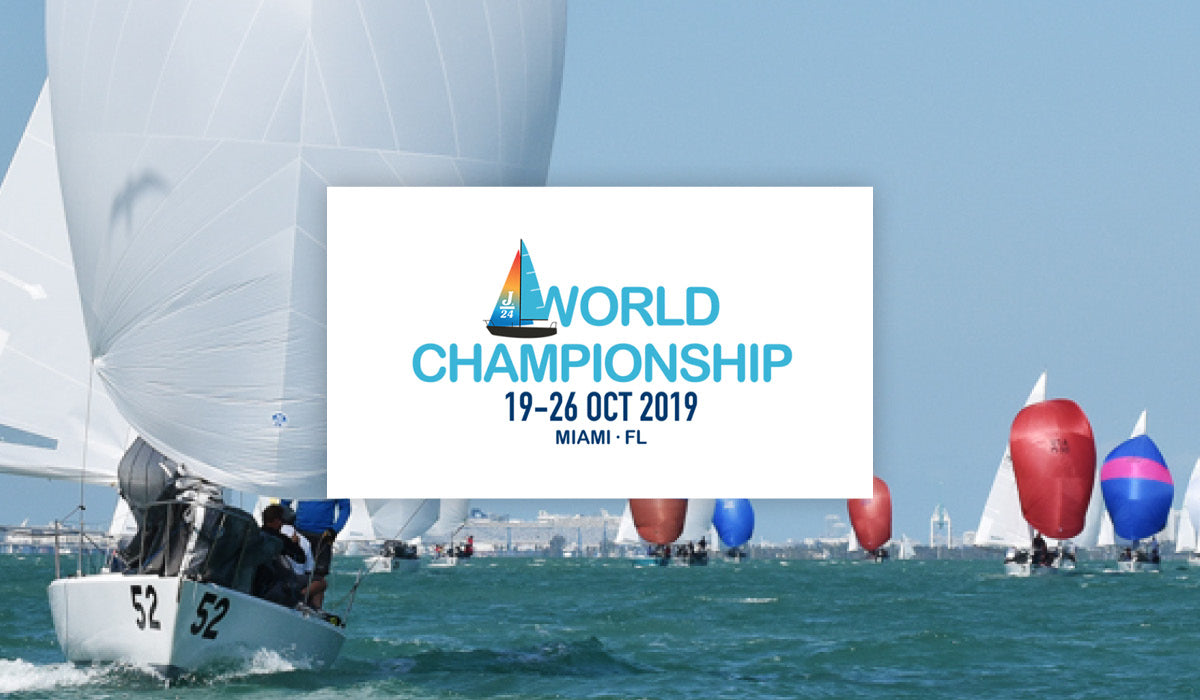
J/24 WORLDS LOCAL KNOWLEDGE
J/24 WORLDS LOCAL KNOWLEDGE
Get To Know Biscayne Bay
To help you prepare for the 2019 J/24 Worlds, we asked the local Star and Snipe World Champion Augie Diaz to explain about his home waters of Biscayne Bay in Miami, FL.
Biscayne Bay is I think pretty straightforward. The weather is driven by cold fronts approaching, and we don’t get as much breeze as we used to because the city’s grown so big. But generally, any breeze from the northeast around through the southwest is great sailing. From this direction, the breeze is usually under fifteen knots, with relatively flat water (chop but no swell). Spring and fall are the best seasons, because we don’t get many fronts.
Dominant wind direction: easterlies
The old rule of thumb is still the case: if the wind’s to the left of the south end of Key Biscayne, you go left. Near the Key, from 120-160 degrees, there is a little more pressure closer to the end of the Key, and also a geographical shift off the land. How favored is somewhat current-dependent; from 70 degrees to 160 degrees with an outgoing current, then left is really good, what we call the “Old Man Expressway”. At the top of the beat on the J/24 Worlds course, the Old Man Expressway could be important.
On what I call the Cuba Course, where the Etchells sail, way down south of Matheson Hammock, there’s less left down there than there is closer to the point of Key Biscayne. So you have to keep in mind where you are on the Bay.
Current
Understanding the current is very important. People think the current comes in and out of the Bay from the east, but it actually runs in and out from Bear Cut. If you get close to what we call the Valves, which are the channels through the shallow areas that on the chart are labeled Biscayne Flats, there is a component of current going in and out of there. But you have to be very close to the Valves for that to be the net effect. Otherwise, the current basically ebbs from the southwest to the northeast, and goes the opposite way when it floods.
As for the timing relative to high and low tide, I’ve seen it as much as an hour off, so I just use tide change as a gauge and then keep checking the buoys, all the time. Sometimes seaweed will show lines of current, but I’ve never really seen a change in the color of the water.
Other wind directions
Once the wind gets to about 170-180, it’s pretty important to protect the right. That’s true all the way to 220 degrees. Anything right of 220-230, it’s going to march quickly to the northwest because that’s a frontal-driven direction, which doesn’t doesn’t have the ability to stick.
If the wind’s right of 230 degrees, I like coming in from the top left because you get some really nice puffs off the left shore. It depends where you are on the Bay; on the J/24 course, close to the west shoreline, you’ll definitely want to come in from the top left.
Northwesters are like you’re on a lake: very shifty, very up and down. But in late October, it’s actually less frontal, so that’s less likely.
Secret to success
Focus on what the current’s doing, and in the easterly understand how important it is to go left.
Thanks Augie!
READ MORE
READ MORE

HEATING UP FOR THE NATIONS TROPHY
HEATING UP FOR THE NATIONS TROPHY
North Sails Supports ClubSwan 50 Training Weekend In Palma
Preparation for The Nations Trophy began in Palma when eight ClubSwan 50s came together for a pre-regatta clinic. Team One Group spearheaded the organization of bringing the fleet together for this training weekend. North experts were amongst the fleet onboard with clients, helping improve techniques, tuning, boat speed, accelerations, and timing. The main goals of the weekend were to collectively raise the bar of competition in advance of The Nations Trophy, which begins on October 8th.
Local conditions delivered, making drills efficient and effective. A mixture of practice starts and races, with emphasis placed on sail trim and starting line strategies, skills that will be important when this one design class lines up in the 20-boat fleet during The Nations Trophy. All in all the racing was extremely close, and there was no ‘slow’ team in participation.
Over the course of the training, it became clear just how important it is to get into the groove as fast as possible. “All boats have very similar speeds, given they are all sporting the same one design class inventories,” said North class expert Arnd Howar. “From what we saw during this training session, starting, boat handling, sail trim, and boat positioning will make all the difference in overall speed and performance for individual teams when it comes time to race.” Boats that stood out during the training weekend were Skorpio, EarlyBird, and Stella Mares, consistently arriving at the corners of the racetrack in the front of the pack.
Thank you to our clients for helping make this training session a success. And a special thank you to North expert Marc Patino who ran the coach boat and daily debrief sessions. At North, we dedicate our services to improve the quality of racing for our clients with leading sail designs and support. After catching the group in action throughout this training, it looks to be an exciting regatta for our clients.
North Sails is a proud partner of the 2019 edition of the Nations Trophy. Here is a selection of our favorite photos from our ClubSwan 50 training weekend.
Fleet start at training weekend. 📸 Jesus Renedo / Sailing Energy
Norwegian team on Fram XVIII 📸 Jesus Renedo / Sailing Energy
📸 Jesus Renedo / Sailing Energy
Hendrik Brandis’ German team on Earlybird. 📸 Jesus Renedo / Sailing Energy
Sweedish team on Regina 2.0 📸 Jesus Renedo / Sailing Energy
Norwegian team on Fram XVIII 📸 Jesus Renedo / Sailing Energy
📸 Jesus Renedo / Sailing Energy
📸 Jesus Renedo / Sailing Energy
📸 Jesus Renedo / Sailing Energy
READ MORE
READ MORE
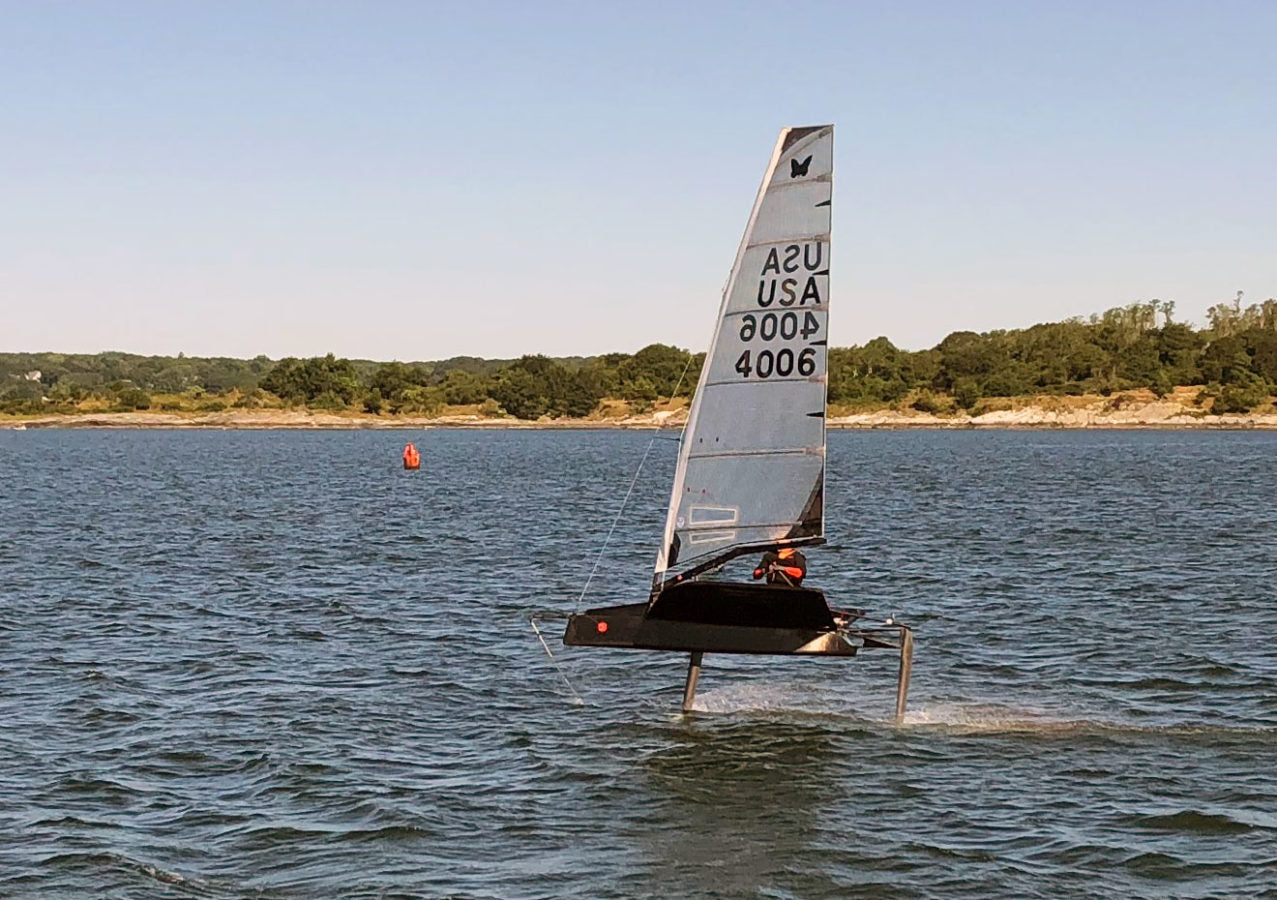
HOW TO BUILD YOUR MOTH SKILLS
HOW TO BUILD YOUR MOTH SKILLS
Dan Neri Explains How To Get Started Sailing this Foiler
Compared to most dinghies, building the basic skill set for the Moth takes a long time. After about 40 hours of sailing the Moth, I can foil with confidence in all directions in the limited window of 8-14 knots of wind. I feel like I am close to executing a foiling jibe but have not connected two of them yet, and every tack is still an adventure with a surprise ending.
The experienced Moth sailors tell me that I am on a typical timeline. I was told that my decades of Laser sailing would help, but I don’t recognize a lot of cross over to the Laser. A skiff sailor will get there more quickly. Younger sailors probably learn faster than older sailors, but older sailors can afford to replace the broken parts! It all evens out.
Here are some lessons I have learned in my first nine months of Moth ownership that might help a fellow beginner.
First Assembly: Study the boat manufacturer’s assembly guide. Then get an experienced Moth sailor to help you. Plan on two full days. Take your time and you will break less parts.
Rigging: Watch the Nathan Outteridge tutorials. Then get a Moth sailor to help you the first time.
(And make sure to read How to Rig a Moth in 20 Steps)
Launching: Watch the Nathan Outteridge tutorials. Rig up in your yard and practice carrying the boat around in an area with no obstacles. You will find a balance point with the boom and mainsheet on your shoulder and the mast tip and wing bar both off the ground.
Flight setup: Get a Moth sailor to help you set the ride height control (see Flight Controls below). Pull the wand all the way up. Put the gearing in the middle. Then forget about the flight controls, and pretend it is a regular dinghy.
Balancing the Moth at low speed: Look for a day with 8-10 knots of steady breeze. Practice low riding while focusing on keeping the wings out of the water. Learn to tack at low speed. Hint: you can not scull with a Moth rudder. Try to not get stuck out on your Moth in less than six knots of wind. The Mach II is happier in reverse than in forward in very light wind.
Foiling: Watch the Nathan Outteridge tutorials. Look for a 10-12 knot day. Less than 10 knots makes taking off tricky. More than 12 knots feels like a hair-on-fire experience until you get some confidence.
Plan to sail for one hour with equal time spent swimming and foiling. Sail back and forth on a beam reach and enjoy the ride. Upwind and downwind can wait for another day; the first sensations of liftoff and controlled flight are the foundation that will keep you working up the steep and frustrating learning curve.
Turning downwind: This might be easier for sailors with skiff or catamaran backgrounds than it was for a lifetime Laser sailor, but the upwind-to-downwind transition is where I’ve had my most violent crashes. It is mostly a matter of starting with windward heel and then committing to the maneuver. The more breeze there is, the more aggressively you need to move through the transition zone. Waves make it more exciting. If you don’t go home with a few bruises, you probably did not progress. Get comfortable making the turn up and down in 10-12 knots before you try it in 14-16.
Foil Jibing: Watch the Nathan Outteridge tutorials. Then plan to crash a lot.
The maneuver has a few distinct steps; get moving at maximum speed with a slight windward heel, set your back foot on the hull and tuck your front foot, swing the tiller extension to the new wing bar, and lunge across and under the boom. Let the boat carve through the turn while getting your butt fully onto the new wing bar, then switch hands. While doing that make subtle steering adjustments, pushing the tiller slightly toward whichever wing bar is higher, to keep the boat under the rig. Simple.
Sail Trim: The Moth is extremely sensitive to sail trim, but for me, there was so much other stuff to deal with (balancing the boat in particular) that I took a set-it-and-forget-it approach at first. That was a mistake. Sail trim makes a huge difference in lighter wind by generating take-off speed (with a powered-up sail) and then by reducing drag and heeling moment once you are foiling (a flatter sail than you’d think). Again, the learning curve is steeper than other boats. To make sail trim adjustments, you have to learn to grab the right control lines (vang and cunningham) without looking down to find them, and then you have to pull two feet of line without upsetting the boat, while steering with the mainsheet in your tiller hand. Easier said than done.
Flight Controls
There are four controls that dictate lift-off and ride height.
1.) Ride height adjustment: It’s critical to set the ride height adjustment barrel in the correct position. The ride height mechanism connects the wand to the main foil flap. The ride height range is set while still on land but after the boat is fully rigged, on its side. Once the range is set correctly, you can dial in a little more or less lift with the control line while sailing.
The ride height adjustment controls the position of the main horizontal foil flap. If the linkage is set with the rod too long (barrel screw opened up), the flap will be pulled up (no lift) and the boat will not take off. The opposite adjustment (barrel screw closed down) creates too much lift (a big gap between flap and vertical foil indicates the flap is pushed down, making a lot of camber) which will cause the boat to lift off and keep rising until the horizontal foil catches air (and you crash).
The long black barrel is a telescoping screw that changes the length of the wand connecting rod. The barrel is turned by the control lines wrapped around it that lead out to the starboard and port wing bars. The aft end is connected to the curved arm (between my hands in this picture). The curved arm connects to a vertical rod that is in turn connected to the flap on the main horizontal foil. The “gearing” adjustment moves the ride height barrel up or down on the curved arm. A lower position results in more direct response between the wand and flap, while a high position dampens the action. Got it?
Experienced Moth sailors set the ride height by eye and it is a bit of a black art. If there are no expert Moth sailors available, adjust the barrel so that the flap and forward part of the foil form a fair curve when the wand is angled back about 45 degrees. Another gauge on the Mach 2 is to measure the gap between the flap and the vertical foil, which should be about 7mm with the wand all the way forward.
This shows the camber amount needed when you are up on the foils with just enough lift to keep you flying, with the wand hanging straight down and ticking the water.
Set up your ride height control line so that this neutral lift position is at the middle of the range of adjustment. If the breeze is very light, dial in more lift. If the breeze comes up, dial out some lift. As a newbie, it is easy to second-guess the ride height adjustment when in fact your technique is the problem, or to assume your technique is bad when in fact the ride height is way off. Get some help, so you can have confidence in this setting and focus on sailing.
2.) Gearing: Gearing comes into play once the boat is flying. Anthony Kotoun explains the function of the gearing control as “how much information do you want the wand to deliver to the flap.” If you find your boat is bouncing when passing over small surface waves, you have too much gearing (the flap is moving too much). If your boat is too floaty and slow to respond, the flap is not moving enough and you need to pull the gearing control down. Setting it in the middle is a pretty safe bet.
On my boat, the gearing control is the red line. If you follow it forward (towards the lower left of the photo) it connects to the black slider that is pushing down on the ride height adjusting barrel, along the curved arm. Most boats have the gearing led to both wing bars for adjustment on the fly. For now I leave it in the middle, so I have less lines to get tangled in!
The blue control line adjusts the shock cord that pulls the wand forward. In very light air, you want very little tension on the shock cord; as the breeze comes on, you want a little more. Worn shock cord makes the boat hard to control in windy conditions.
3.) Rudder angle: The rudder pin (the long pin that goes through both the upper and lower gudgeons) slides forward or aft in the rudder head, which changes the pitch, or angle of attack, of the foil at the bottom of the rudder. Changing the pin position and foil pitch controls the fore and aft flight trim. With the pin forward the rudder head moves aft, which in turn tips the foil up and creates more lift. More lift results in easier take off and more bow-down fore and aft trim. Moving the pin aft causes the rudder foil to sink and makes the boat fly with the bow higher than the stern. The pin position is adjusted by a big plastic screw inside the tiller, which is adjusted by twisting the tiller extension.
4.) Wand Length: The wand is telescoping with the length adjusted by a continuous-loop control line led to both wings. Shorten the wand for a lower fly height (better control but more drag and lower speed) and lengthen the wand to fly higher with greater righting moment and less drag (higher speed).
Left: shorter wand, lower fly height (better control, but more drag and lower speed). Right: long wand = higher ride height.
That probably seems like an awful lot to learn. It is, but it is also much easier to understand once you get your boat rigged up and laying on its side at the water’s edge. Pre-launch set up and check over is the only part of the Moth sailing game that you can learn while comfortably on land, without fear of crashing.
READ MORE
READ MORE

CLIENTS MAKE A STATEMENT AT MELGES 24 PRE WORLDS
CLIENTS MAKE A STATEMENT AT MELGES 24 PRE WORLDS
Gearing Up For The Ultimate Showdown In Villasimius
📸 Zerogradinord
Act four of the 2019 Melges Tour was the last hurrah before the World Championship in Villasimius, Sardinia, Italy. Andrea Pozzi and his team Bombarda have been chomping at the bit in their final preparations before the Worlds which begins October 5th and after spending a week at the worlds venue, they have set the tone for the main event. “Since the very first day of training here in Villasimius, the feeling with the racecourse and the boat has been positive,” said Andrea. Bombarda took the fleet by storm at the pre worlds, scoring three bullets in the first three races, upping the game from the very beginning for the remainder of the fleet.
In conditions of all kinds, Bombarda came out on top in 20-knot gusts, steep waves, and even in the light and lumpy conditions; they couldn’t be beaten. After eight races and one discard, Andrea’s team sat at the top of the leaderboard with six points to spare, ahead of Taki 3.
“Other than having great race results,” said Giulio, “Bombarda had great speed, executed perfect maneuvers and made smart tactical calls which made the difference in their overall result.”
North Sails expert Giulio Desiderato was in Villasimius working with Bombarda for the pre worlds. “The team’s goal for the worlds was to be comfortable and confident with the Villasimius venue. We developed a sense of local knowledge during the days of training and sail testing, which helped build our confidence.”
Andrea has had quite the season, always working to improve on the team’s weak points. “From the very beginning, said Giulio, we felt confident in the windy conditions, so we focused a bit more on our light air techniques.”
📸 Zerogradinord
“We started our campaign with the long term goal of doing well at the worlds, and we’ve taken small steps each time to get closer to that goal.”
From a coaches perspective, Giulio is very proud of team Bombarda. “They never give up,” he said. “That’s what I love about this team.”
Giulio gives a ton of credit to debriefing with the team after racing. Seeing what is going on from an off-the-boat perspective can be very beneficial when it comes to critiquing each position. “After racing, we watch the video footage and look at the photos together so we can see where changes could be made. We discuss the conditions, boat handling, and they make improvements. For me, as their coach, this is a winning approach.”
“The decision on what sails to use was made before the pre worlds,” he commented. “After the Bacardi Cup in Miami, we were confident with North Sails 3Di. Our goal was to test configurations in all conditions from then until now to get more confident with tuning.”
When asked what he loves so much about racing and coaching the Melges 24, Giulio replied; “I love this boat. From the rib, you can see all the action, too, which makes it hard to watch from the sidelines.” The Melges 24 is a great mix- providing technical upwind legs, fast and fun downwind sprints, and is super sensitive to boat handling. I have a feeling that more owners are coming back because it’s a great time. Andrea and his team are the perfect examples of owners that love being apart of this class.”
Andrea Racchelli’s Altea, a solid contender for the 2019 Worlds, was also at the top of the leaderboard, but suffered a UFD along with two finishes out of the top five, keeping him off the podium. Altea is an absolute contender for the Worlds, and fast-clean sailing will help their average. Kevin Welch’s MiKEY, as well as Bruce Ayers’ Monsoon, and Brian Porter’s Full Throttle are also a likely contender for the title.
The Corinthian division has a fair battle with Tõnu Tõniste’s Lenny, Miles Quinton’s Gill Race Team and Michael Tarabochia’s White Room all in the hunt for a podium spot.
There are 62-boats registered for the worlds, with 15 nations from three continents, which shows how much the class has evolved in numbers over the last 20 years. The Worlds will be a five-day test for all, combining some of the best sailors around the globe in one of the most popular small-boat one design racing platforms. The unique location will make for a real grand finale to the class season circuit.
Are you interested in championship-winning sails for your Melges 24? Contact your local expert today.
📸 Zerogradinord
📸 Zerogradinord
READ MORE
READ MORE

HOW TO DOMINATE THE VX ONE NORTH AMERICANS
HOW TO DOMINATE THE VX ONE NORTH AMERICANS
Here’s The Recipe From The Winners
Mike Marshall, Madeline Gill and Jo Ann Fisher, 2019 North American Champions 📸 Jeff Westcott
36 VX Ones gathered in Newport, Rhode Island from September 19-22 to race in the 2019 North American Championship. Class expert and designer Mike Marshall, sailing with North Sails design expert Madeline Gill and Jo Ann Fisher, dominated over the largest fleet in class history, with only one finish out of the top three. Newport breezes were shy for the first two days, and it wasn’t until Sunday’s seabreeze filled that the team was able to fully showcase the versatility of the North Sails inventory. North-powered teams finished 1,2,3,5,6,7,8,9,10.
Mike Marshall commented after the event:
“North Sails offers the fastest VX One sails on the market. The main allows for a wide range of rig tuning. You are able to ease the lower shrouds in light air to get headstay sag, but also tighten them in the bigger breeze to get headstay tension. The jib pairs well with the main, allowing for tight in-hauling and hard sheeting. The AP spinnaker is perfect for all the different modes, from slightly more bow down, almost planing mode in light air, to the much higher planing mode in medium and heavy air.”
Here’s their recipe for their success:
Conservative Plan
Madeline Gill had never sailed with Mike before, but as the team trimmer she says that consistency was the biggest factor in their success. “We formed a conservative plan and stuck to it – arrive early to the venue, launch the boat as soon as everything has been checked over, and get off the dock before as many other boats as possible. We quickly settled into a reliable routine that allowed us to focus fully on our individual responsibilities and quickly bounce back from most mistakes.”
Conservative Setup
Before each race, Madeline explains, the team would sail upwind to get a visual on the power in the sails. “We would then make minor adjustments to the rig tune to have adequate power in the lightest breeze we expected, without sacrificing too much depowering ability. We rarely adjusted any shroud more than one turn between races. Even when things weren’t going our way and we were not sailing well, we resisted making large scale or multiple changes.”
Marshall crossing the line to win race 7 📸 Jeff Westcott
Build Before You Burn
Mike adds that the key to speed in the VX One is to “match the speed of the boats around you before you match the angle. The chord of the keel and rudder are short; in order for them to work efficiently, the boat has to be going fast. If you ever felt like you were not pointing with the boats around you, it was probably because you weren’t moving fast enough forward. As the boat speed increases, the boat slides sideways less so it feels like you are pointing higher than the boats around you. For most of the event, I think that we kept the driving telltales of the jib with the windward one at 45 degrees lifted and the leeward one straight. If we were a little low on point, but faster than the boats around us, I would trim the main harder. If were were still low, I would potentially trim the jib a little harder, but not to the point where the top leech telltale was stalling.”
Flat Is Fast
Another part of making sure that the boat is going fast is to be able to get the bow down; Mike points out that can only happen with the boat flat, upwind and downwind. “In most conditions, I was looking to sail the boat with 8 degrees of leeward heel upwind and slightly more than that downwind. Only half of the hull is in the water, but it’s still a nice planing hull shape. Any more heel and the leeward corner is digging in, loading the rudder. Any less heel and the wetted surface is causing extra drag. When I was overpowered, I absolutely had to ease the mainsheet—in the biggest breeze, as much as two feet. Lighter teams might have to ease it a bit more, while heavier ones will have to ease it less.”
HIKE!
“I really couldn’t say it enough times all weekend!” Mike laughs. “The harder we hiked, the less I had to ease the mainsheet to get the boat flat. I’m quite sure that my team was tired of hearing me say “big hike here,” but it really is a difference-maker and in looking at the event photos, we were one of the hardest-hiking teams.”
North Sails fast VX One sails 📸 Jeff Westcott
Tuning
Forward crew Jo Ann Fisher says that tuning was a constant discussion on the boat. “Between every race, we would go upwind and check the rig. We were looking for the leeward upper shroud to be just going slack. If it wasn’t, we would put turns on the uppers. Once that was done, we would look for overbend wrinkles coming from the spreaders toward the clew, about halfway back in the sail. Any farther back, and we would tighten the diagonals until it went away. Any farther forward, we would loosen the diagnonals. Then we’d move our eyes down the sail, looking for overbend wrinkles from the gnav attachment to the clew. To reduce them, we would put a turn on the checks. From the lightest air to the windiest, we only adjusted the checks three turns. As with all tuning, the key is to be sailing upwind in race mode before you check: jib trimmed, vang on (if needed), and crew hiking hard.”
Weight Placement
Another topic Jo Ann mentioned was fore-aft weight placement. “Upwind in light air, we were trying to get as far forward as possible. If you could hear bubbles come out from behind the boat, you were too far back; if you took two or three waves over the bow, you were too far forward. Downwind too, we pressed as far forward as possible in light air. Mike was to windward sitting on the floor, Madeline was a little more to leeward, and I was sitting out leeward.”
In bigger breeze, Jo Ann says the team moved a half body width back from the shrouds upwind. “Downwind, we moved to all sitting on the weather side and then to all hiking a body width back from the shouds. Again, the goal was to not hear any bubbles from behind the boat. When you are planing, it is more about keeping the bow out, but unless the wide part of the boat near the mast is digging in, you don’t need to move any further back.”
Communication
Finally, Jo Ann points out that the team’s communication was crystal clear, well in advance of each maneuver. “At five minutes to the start, we knew where we’d start and what we were going to do upwind. 10-15 boat lengths before the windward mark, we knew what boats we would be ducking and whether we would be setting the kite at the offset (or before) and going straight, or looking to jibe. Three quarters of the way down the run, we knew which gate we’d round and which way we wanted to go upwind. It was not a lot of words, but everyone was prepared. Some of the biggest opportunities to pass boats is at marks, so knowing what the plan is long before you get to them is critical to having a good rounding.”
For more information about VX One North Sails products or to talk with your local expert, visit the VX One class page.
Mike’s superb concentration on the race course. 📸 Jeff Westcott
READ MORE
READ MORE
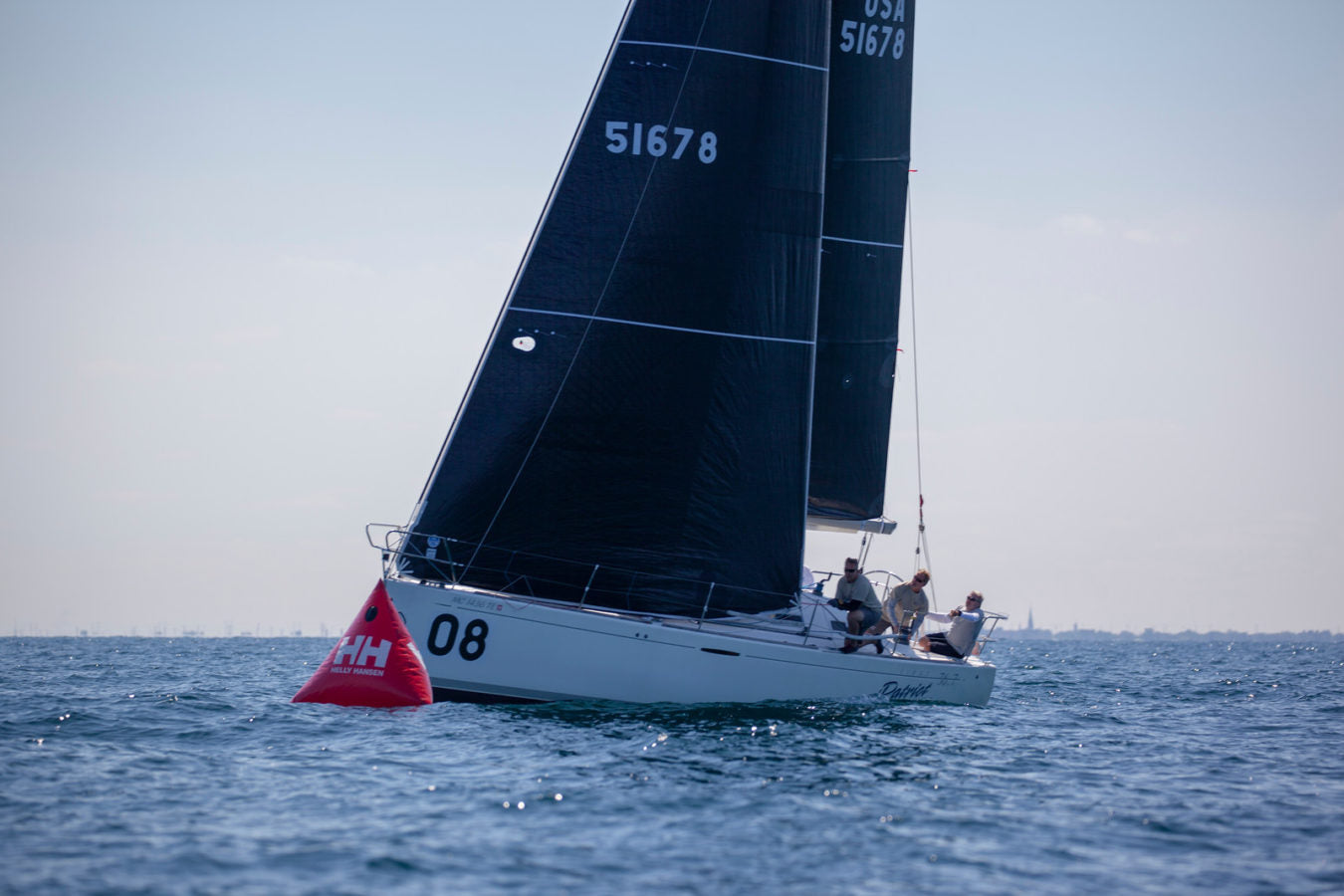
CLEAN SWEEP AT BENETEAU 36.7 NORTH AMERICANS
CLEAN SWEEP AT BENETEAU 36.7 NORTH AMERICANS
North Sails Clients Dominate The Podium
Patriot Owner Ken Sharpe and his crew for their overall victory, winning six of 11 races. Chris Duhan's Tequila Mockingbird took second, and Jarrett Altmin's Soulshine took third and was also the Corinthian Champion. "Our upwind speed made my job pretty easy. There was still another option to switch gears when we needed to," said Todd Jones, tactician on Patriot.
Wind conditions for the four-day event ranged from light with flat water to light with a leftover chop to the top end of buoy Number 1. All three of the top boats sported 3Di for their upwind inventory. "The sails performed well and were easy to shape for the wide range of conditions we saw," says North Expert Karl Kuspa, mainsail trimmer on Patriot. Kuspa shared one of his favorite parts of the event was that the host club was very accommodating and opened up their doors to competitors. "Columbia Yacht Club ran a first-rate event." Looking ahead to future regattas, Karl noticed one area of improvement that all Beneteau Owners could takeaway. "Gear shifting- with the varying winds we had, there was a lot of on-the-fly gear shifting going on. I watched a fair number of boats fall off a cliff because they were not shifting gears frequently enough."
Karl's three tips for 36.7 sailors:
Upwind playing the backstay is crucial. Puff on, backstay on. Puff off, backstay off. I played the backstay way more then I played the sheet.
Consistent heel angle. This is done through crew weight (hiking), main trim, and most importantly driver.
When in doubt heat it up! This is especially true in light and slop with these boats when sailing downwind. It is easy to lulled into sailing too deep.
READ MORE
READ MORE

2019 CANADIAN OPTIMIST NATIONAL CHAMPIONSHIPS
For all of these “green”sailors this was their very first time participating in a National event. Not only did young sailors have an opportunity to develop their racing skills and meet new friends, they learned that even in light wind it is possible to have fun on the race course.
READ MORE
READ MORE

ROLEX BIG BOAT SERIES RECAP
2019 ROLEX BIG BOAT SERIES
From Low To High On The San Francisco Bay
📸Rolex / Sharon Green
It is safe to say that it’s never a dull experience sailing in the San Francisco bay. For the crews taking part in the 55th edition of Rolex Big Boat Series, the culmination of sailing events in the bay area, there was a mix of confusion and unfamiliarity for the first two days of racing, as light winds and scorching sunshine limited time on the water. “Sailing in shorts and a t-shirt is not typical for San Francisco in September” noted local North rep and regional manager Seadon Wijsen. “But it was pretty awesome to do so, and we had just enough wind to sail one race each day”. With wind picking up later in the afternoons, boats enjoyed 12-18 knots with beautiful sunshine on the iconic waters.
The first two days of racing were anticipated to be light, and boats encountered exactly what the weather man predicted. That particular weather man being expert meteorologist and guest speaker Chris Bedford from Sailing Weather Service. Chris joined racing expert and sailing legend Peter Isler as part of the North Sails pre race briefing, held at the St Francis yacht club on the morning of race day one. Peter was able to provide teams with valuable insight into navigating the complex bay waters and tides, while Chris provided tactical weather forecasting for the four days. Commenting on the Expert Briefing, local North rep Pete McCormick said,"At North Sails we aim to add value and experiences to the events we support, so bringing experts like Peter Isler and Chris Bedford in to provide expert advice really benefits every boat and sailor. That’s what it’s all about."
With the first two days permitting two total races, everyone was delighted when the full on San Francisco breeze returned for the weekend. On Saturday, 18-24 knots quickly became 24-30, with gusts hitting up to 35 later in the afternoon. This proved too much for some, with three boats in the race losing their rigs.
Kuai, the melges 32 owned by local Daniel Thielman was on a mission to dominate the regatta, and excelled in all conditions to score five bullets out of six races, taking the win for the ORR B division. “Daniel and his team really put in the work for this win. They prepare the hardest and it’s great to see with a well deserved win” Seadon Wisjen commented.
📸Rolex / Sharon Green
Ray Paul and his crew on Blue, the Swan 53 battled it out in the OOR A fleet to take second place at the end of the weekend. Claiming a bullet on the first and last race, they just scathed the top position on the podium by one point and four seconds.
For the final day of racing, teams enjoyed cool temperatures, gathering breeze and flooding waters to take on the bay distance tour. Ending just off of the St Francis Yacht Club gave a perfect stadium style finish to end the regatta.
As part of North Sails’ commitment to supporting the Rolex Big Boat Series, Certified Service experts were on hand each day at the North Sails dockside lounge to pick up sails for overnight repair. “The weather on the bay is always so unpredictable, and this regatta surely represented that” commented Sailmaker Charlie Jenkins, “ We want to make sure all boats have the support to be able to get back on the race course, so having our team of sailmakers on standby at the club is a priority for us.”
📸Rolex / Sharon Green
📸Rolex / Sharon Green
📸Rolex / Sharon Green
📸Rolex / Sharon Green
📸Rolex / Sharon Green
READ MORE
READ MORE
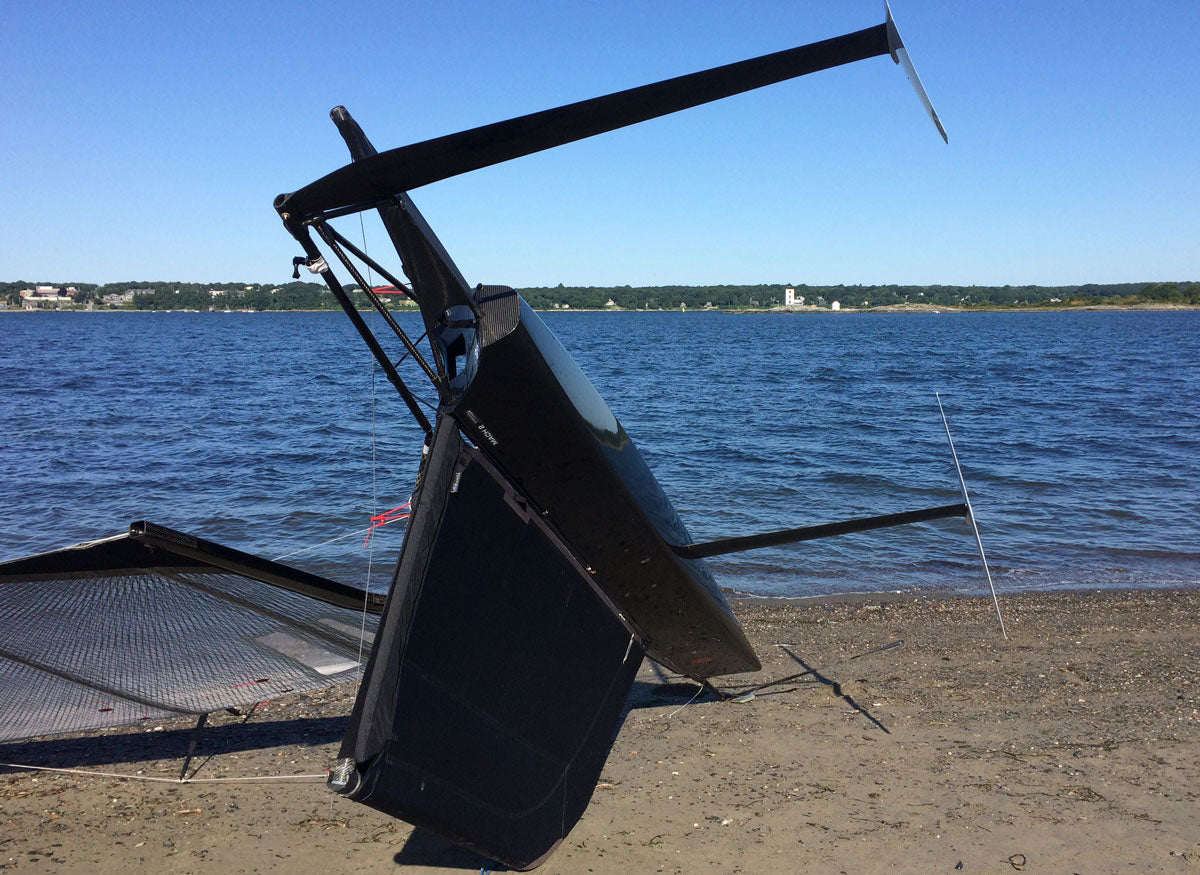
HOW TO RIG A FOILING MOTH
HOW TO RIG A FOILING MOTH IN 20 STEPS
Dan Neri Gets Ready to Sail this Singlehanded Foiler
When I first set up my Moth, I broke a lot of stuff. Since then I’ve learned what to do (and what not to do) and in what order. First, bring everything to the beach. Set the foils off to the side, safely out of the way of the boat and any spectators.
Rig sail and spreaders
1. Slide the mast into the sail, keeping the mast above all the camber inducers. It is easy to get the mast past the lower cams. You’ll have to shove it past the top two one at a time.
2. I keep a string with a couple of spliced loops in my pocket to use as a temporary cunningham. I pull it just enough so the spreader bracket is positioned in its sleeve cutout. After stepping the mast this string is replaced by the regular cunningham.
3. Push the cams onto the mast and zip up the sleeve, starting at the top (when you derig, take them off starting at the bottom). To load the cams, put the mast on your knee, push down on the batten (against your knee) with one hand and push up on the cam with the other hand.
4. Before you lay down the sail and walk away, make sure the battens are pushed down so the sail doesn’t fly down the beach.
5. With the sail laying across the wing bars, untangle the stays, install the spreaders, and then attach the forestay and side shrouds to the mast.
Step the mast
Note: My boat has an adjustable headstay, so I can step the mast with the headstay adjustment at its loosest setting. If you have a fixed headstay, you’ll need to use a longer temporary headstay.
6. Position the boat so that it is pointing about 10 degrees away from head-to-wind. Hook up the shroud on the windward side and the long headstay. Pick up the mast between the two attached shrouds with the masthead into the wind, put the mast butt into the step, and push the mast up into place.
7. The wind will do most of the heavy lifting and the mast will fall to leeward, toward the loose side shroud. Hook up the leeward shroud, but leave the headstay long until after you attach the clew to the outhaul.
8. Attach the boom to the gooseneck and then hook up the cunningham and pull it tight. The tight cunningham will help to bend the mast and make it easier to hook up the outhaul.
9. Attaching outhaul to clew requires three hands; two hands to pull the sail and boom together against the boom vang, and a third to install the clevis pin. I have learned a little trick; I set the boom in the crook of my elbow and simultaneously pull down on the leech with that same hand, until the clew grommet lines up with the outhaul car. Then I install the pin with my other hand. Don’t forget to tension the headstay.
Install blades
10. If you’re rigging on a beach, remember to put a flat rock or a towel or anything other than sand under the tip of the bowsprit and the wand axle bolt. Then capsize the boat so you can install the blades.
11. Make sure the sail battens are popped down so the sail does not lift the boat. Tighten the mainsheet so the wind is pushing the sail towards the ground.
12. Assemble tiller/rudder and install on transom. Remember to put the tiller under the shock cord.
13. Take away the dolly and insert the main foil into the slot. Insert the daggerboard retaining pin. (You may need a hammer to tap it in if you are having trouble lining it up perfectly.)
Final adjustments
14. Hook up the ride height adjuster and gearing (on the floor just aft of the mast).
15. Pull the gearing to the middle of the range.
16. Attach the ride height uphaul/gearing cap.
17. Pull a little tension onto the wand shockcord.
18. Use a stiff ruler to check the foil flap gap with the ride height adjustment barrel control line in the middle of its range. For the Mach II, with the wand all the way forward, a 7mm gap is a good starting point.
19. Install a GoPro on the tiller so you can compare yourself (unfavorably) to the Nathan Outteridge tutorial videos.
20. Go find your hat if you are bald, and your cheapest sunglasses. Take off the foil covers. Ready to go sailing!
Read Moth Newbie: Dan Neri Learns to Foil
READ MORE
READ MORE
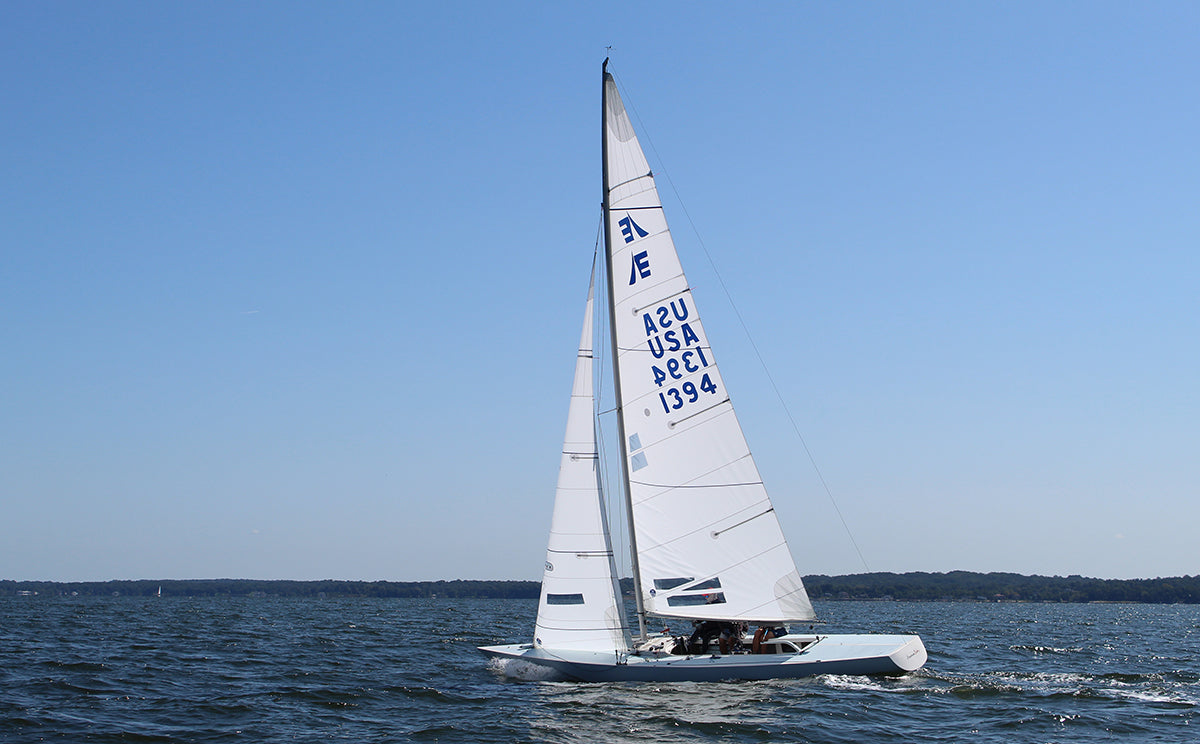
NORTH SAILS SUPPORTS ETCHELLS U.S. NATIONALS
NORTH SAILS SUPPORTS ETCHELLS U.S. NATIONALS
Etchells Fleet One Celebrates 50th Anniversary
George Francisco’s American Baby (USA 1394) sailing in the light airs which dominated the weekend
American Yacht Club, located in Rye, NY delivered more summer than fall weather for the 2019 Etchells U.S. Nationals. The hot temperatures created instability in the breeze making it difficult for the Race Committee to complete races, but they did the best they could with the conditions they had. Frustratingly, this meant that only four races were completed in the three-day regatta.
Talking about the event, North Sails Ched Proctor explains the tricky conditions: “It was light air with a lot of goofiness, often coming down to catching puffs of air which scattered the race course. The organizers worked hard to put on a good event, so it was a shame the wind didn’t cooperate.”
Jim Cunningham (Etchells International Class Chairman) and his team of Erik Shampian, Steve Hunt and Carrie Wiley onboard Lifted (USA 1461) took the title after achieving consistent, top ten results throughout. New boat Lifted was sailed by Iain Murray’s team to win the recent World Championship in Corpus Christi where Iain thought outside the box with the boats rigging and sail set-up. Whilst the fleet waited for wind on Saturday morning, it provided great entertainment with easy viewing of Lifted’s several unique features which allowed the jib to be sheeted further inboard and and smaller lines with more appropriate purchases to make things easier.
Although the racing was not as prominent, class camaraderie was top notch. While waiting for wind, the fleet spent time together sharing stories about the past. This is a great indicator of how important it is to bond with your fleet members!
50th Anniversary Stories To Remember
Formed in 1969, the Saturday night dinner celebrated the 50th anniversary of Etchells Fleet One with several speakers coming to laud the Etchells sailors. Dewy Eisdale referred to the founding members going against the club traditions, saying “there’d never be an Etchells fleet here”. The IOD was the boat of choice at the time, but a few stepped up and bought an Etchells. Jim Mertz is one name that came up, which then initiated a great fleet story to share in the downtime.
Peter Duncan (PD) spoke about crewing for Jim Mertz one summer when he was 11 years old. He was part of the first four-man Etchells team and he recalled one funny yet exciting time when they were rounding the offset mark, while leading a race in the Larchmont Race Week. The crew was composed of Jim’s wife and ten-time Adams Cup winner, Alegra “Leggy” Mertz, and a large Labrador retriever which ideally cowered by the base of the mast (best place to carry weight in an Etchells!). As they approached the offset, there was a flock of ducks making a racket which sprung the dog into action, along with the crew. Jim jibed the boat trimming both sheets, he also grabbed the dog by the tail performing a dog-flip, slinging it forward over Leggy’s shoulder into the front of the cockpit. 11 year old PD managed to jibe the pole, while viewing the flying Labrador. As they calmly sailed away from the jibe mark, Jim commented “Good job PD”.
The stories kept on coming – multi-time World Champion Dave Curtis talked about four ways to lose an Etchells Worlds that he should have won and reviewed the losing tactics in the 1980 Olympic trials. It was a reunion for several long-time Etchells sailors.
North Sails was proud to sponsor the Etchells U.S. Nationals and despite the conditions, the top twelve boats used North Sails. Ched Proctor sailed with his son Charlie, and friends Monica and Chris Morgan who finished in a respectable sixth place.
Learn more about our championship-winning Etchells sails.
View the full results
Steve Benjamin practicing the day before the regatta
North Sails, proud sponsor of the 2019 Etchells US Nationals.
READ MORE
READ MORE

MOLO LONGO I NS ZA 7 I POL SATI OKO KRKA
Molo Longo i NS za 7 i pol sati oko Krka
Ponovno vrlo dobro posjećenu regatu s 24 jedrilice na startu organizirali su u suradnji JK Jadro iz Selca, te JK Burin i Mitan marina iz Novog Vinodolskog.
Ove godine su na redu za start bila Selca, a cilj se organizirao u Novom Vinodolskom ispred Mitan marine, a ruta na kojoj se ove godine jedrilo je vodila u smjeru obrnutom od kazaljke na satu, odnosno prvo prema Krčkom mostu, pa na jug kroz Senjska vrata i prema cilju.
Dugo se raspravljalo o smjeru obilaska, na svim organizacijskim instancama. Razlog razmjeni mišljenja bili su vremenski uvjeti. Nekoliko dana pred start vremenska prognoza za Senjska vrata je bila nepromijenjena. U najavi je bila umjerena do jaka bura u toj zoni, pa je glavna tema tih diskusija bila da li je bolje Vrata proći na početku regate u noćnim satima ili po dnevnom svjetlu u završnoj fazi regate.
Na kraju je odlučeno da to bude pred finiš, ali tri vodeće jedrilice su kroz taj tjesnac ipak prošle po noći. Razlog je bila vrlo brza regata.
Naime, na startu je puhalo oko 15 čvorova, naravno bure, tako da je start u Selcima bio s vjetrom u bok. Sve jedrilice su to iskoristile maksimalno i odmah se moglo naslutiti da će rekord regate biti oboren. Osim standardnih sudionika većine prethodnih izdanja, svoj drugi nastup je imala i najveća jedrilica Kvarnera, Molo Longo Tutta Trieste.
Startnu liniju je presjekla u punoj brzini i odvojila se od ostatka flote već od samog starta, a u tom dijelu regate, ispred Crikvenice, ostvarivala je brzine oko 15 čvorova!
DSK, Extreme 37 i mali openaš Joker su bili najbliži posadi Rajka Kujundžića, ali ipak u samoj blizini ostatka flote tako da u slučaju bilo kakvog posustajanja doslovno za desetak sekundi bi bili preteknuti od jedrilica iza njih.
Ostatak potjere, s nekoliko desetaka metara prednosti ispred ostalih, vodili su Cocoon i Trogir. Jedini koji su zaostali odmah nakon starta su bili Senjani na Vještici (Striga del vento) jer su imali problema sa sustavom za kraćenje. Problem su riješili za oko pola sata, a u to vrijeme je Molo Longo bio već između Jadranova i Krčkog mosta.
U ovoj zoni brzina flote malo pada, tako da i vodeća jedrilica jedri brzinama oko 5 čvorova, ali zato sad do izražaja dolaze i performanse ostalih bolida, pa se DSK značajno odvaja od ostalih, dok lagani Cocoon dolazi na svoje i izbija na treće mjesto. Jednako tako jedina jedrilica u regati koja je stigla s Kariba, Wild Devil Baby - Melges 24, zajedno s Blu Labelom koji je trenutno na trećem mjestu i s My Wayom prelazi Jokera i Trogira koji se trenutno može samo pohvaliti pozicijom najbržeg od tri JOD-a na regati.
Otprilike ovim rasporedom jedrilice prolaze ispod Krčkog mosta između otočića Sv.Marko i Krka. I dalje su im u toj zoni brzine u prosjeku 5 čvorova, osim Molo Longa koji je Omišalj obišao u širokom luku i nastavio jedriti s brzinama većim od 10 čvorova!
Glavnine flote i dalje nastavlja jedriti u grupi i svi prate rutu vodećih, te su u jednom dijelu regate čak i bliže Cresu nego Krku. Razlog tomu je izbjegavanje sjene vjetra koju stvara Krk između Omišlja i Malinske, a očito je na ostvarenim brzinama koje sad dosta padaju u odnosu na jurnjavu nakon starta.
Tri i pol sata nakon starta Molo Longo već dolazi do otoka Plavnika i tu kreće rodeo. Ova posada prvi put od kad su na ovom bolidu, regatu jedri s kratom! Nagli udari bure koji su od 5 čvorova puhali do preko 40 su tražili i dizanje olujnog floka da bi se jedrilica mogla kontrolirati. Tu su im brzine u prosjeku oko 8 čvorova.
Za to vrijeme ostali biraju rutu bliže Krku da bi što manje bili izloženi buri. To im djelomično uspijeva, ali sviju čeka "čistina" ispred Krka i Punta.
Malo iza ponoći, pet sati nakon starta, Molo Longo je stigao do otočića Prvića, desne vratnice Senjskih vrata.
Kako je ova zona tradicionalno najizloženija udarima bure, a i po njoj je nadaleko poznata, sa zanimanjem se očekivao izbor jedriličara o strani obilaska. Jedan dio publike je očekivao prolazak kroz vrata s povećim brojem viravanja, a drugi dio je kalkulirao da li će se posade odlučiti na rute starih Senjskih kapetana koji su u burno vrijeme tradicionalno birali obilazak Prvića s istočne strane.
Na kraju svi koji su ušli u ovaj završni dio regate izabrali su kraću rutu, direktno kroz Senjska vrata. Molo Longo ih je čak odradio sa samo dvije vire i nakon prebacivanja na desne uzde imao je samo na istim uzdama jedriti do cilja.
Dok je bio na nekoliko milja od Mitan marine DSK stiže do Vrata, a najbliži pratioci, Cocoon, Sjena vjetra i Trogir bore se s burom nasuprot Punta.
Ekipa Cocoona tada zbog sigurnosti jedrilice donosi odluku o prekidanju regatnog jedrenja i povratku u Rijeku. Procijenili su da su premali i prelagani za forsiranje orce po tim uvjetima. Osim njih slične poteze je povukla većina manjih jedrilica, te jedan dio odlazi u Krk i Punat, dok se neki odlučuju za čekanje na otvorenom dok bura ne oslabi.
Jedini koji u to vrijeme nastavlja jedriti dalje je Trogir. Solidna gradnja i relativno velika masa osigurali su mu i dosta dobar prosjek brzine jedrenja u orcu po ovim teškim uvjetima, te uspješno zadržava vrlo visoko treće mjesto do samog kraja regate!
Do kraja regate u cilj ulazi još osam jedrilica, a kako je koja ulazila u cilj i na koje načine su izbjegavali buru možete pronaći u playbacku na ovom linku. A osim bure koja je natjerala većinu flote da potraži zaklon, regata će dobiti svoj poseban status jer je Molo Longo postavio novi rekord regate od 07:32:56!
Za razliku od ranijih 5 izdanja ova regata je pomaknuta za dva tjedna kasnije. Taj pomak je napravljen u dogovoru s organizatorima regate na Malom Lošinju koja je organizirana tjedan ranije i s organizatorima Galijole koja će se odjedriti vikend kasnije. Na ovaj način se omogućilo jedriličarima iz daljih klubova da svoje jedrilice ostave na mjestima održavanja idućeg eventa, te da se im se tako pruži mogućnost sudjelovanja na ovom vrlo kvalitetnom jesenskom ciklusu.
READ MORE
READ MORE
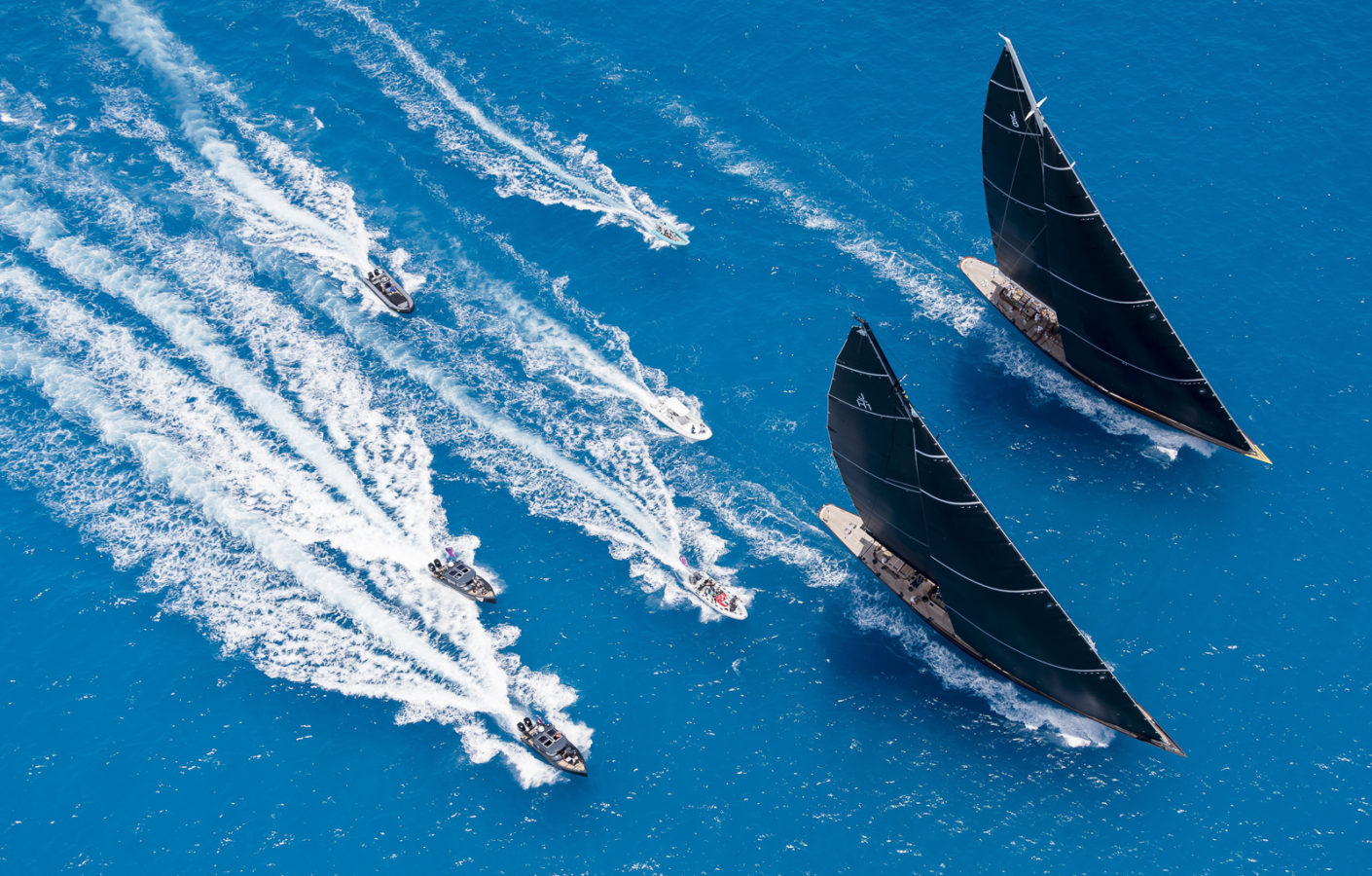
J CLASS OFFICIAL SAILMAKING PARTNER
NORTH SAILS OFFICIAL SAILMAKING PARTNER OF THE J CLASS
Ramping Up Racing With An Eye On New Zealand
📸Carlo Borlenghi
North Sails is excited to confirm continuing our partnership with the J Class Association as the Official Sailmaking Partner. Combining unprecedented experience and heritage in the class, the world’s leading sailmaker is the sailmaker of choice for the J Class fleet and is set to continue to provide support on and off the water as the Class builds towards and exciting year in 2021 as the current America’s Cup cycle culminates in New Zealand.
The J Class Association was founded in 2000 to protect the interests of the Class, present and future. Class Secretary Louise Morton said: “The J Class Association is pleased to continue our very successful partnership with North Sails. North Sails will continue to provide on-site service at regattas, as well as helping to showcase our class to the wider sailing world. Feedback from our owners is unanimous that they truly benefit from the North Sails design expertise, global loft network, world class customer service and cutting edge products as the racing gets ever more competitive and international.”
North Sails have an exceptional team working across the J Class fleet with relationships built up over many years. The team understands the needs and desires of the owners combined with their knowledge of the latest technology to ensure the perfect sail selection. Combining performance, strength and durability, 3Di is the perfect technology for the J Class and the owners have benefited from the ever growing expansion of North 3Di product offerings to improve and optimize performance. A range of North sails are used across the fleet to fulfill needs from racing to cruising, more advanced racing, charters and day sailing.
“The J Class is a rare blend of classic designs using the latest advancements in modern technology,” said North Sails President Ken Read. “Following a raft of new builds, refits and renewed energy on the circuit over the last few years, the future looks bright for J Class owners as they ramp up racing with an eye on New Zealand when these beautiful classic yachts will be able to join the excitement of racing alongside the America’s Cup. The J Class boats are the most unique fleet of boats in the world and North Sails is proud to power the majority of the class. Combining the old and the new in a way that no other boat can do, the fleet showcases so much that is great about sailing.”
In 2021 the Royal New Zealand Yacht Squadron will host regattas in the Bay of Islands and Auckland to commemorate the Squadron’s 150th year and celebrate the return of the America’s Cup to their shores. In the meantime, the fleet will continue to race at the world’s most prestigious events in 2019 and 2020, including the Superyacht Challenge Antigua, and then full schedule of events in New Zealand in 2021.
📸Breed Media
READ MORE
READ MORE
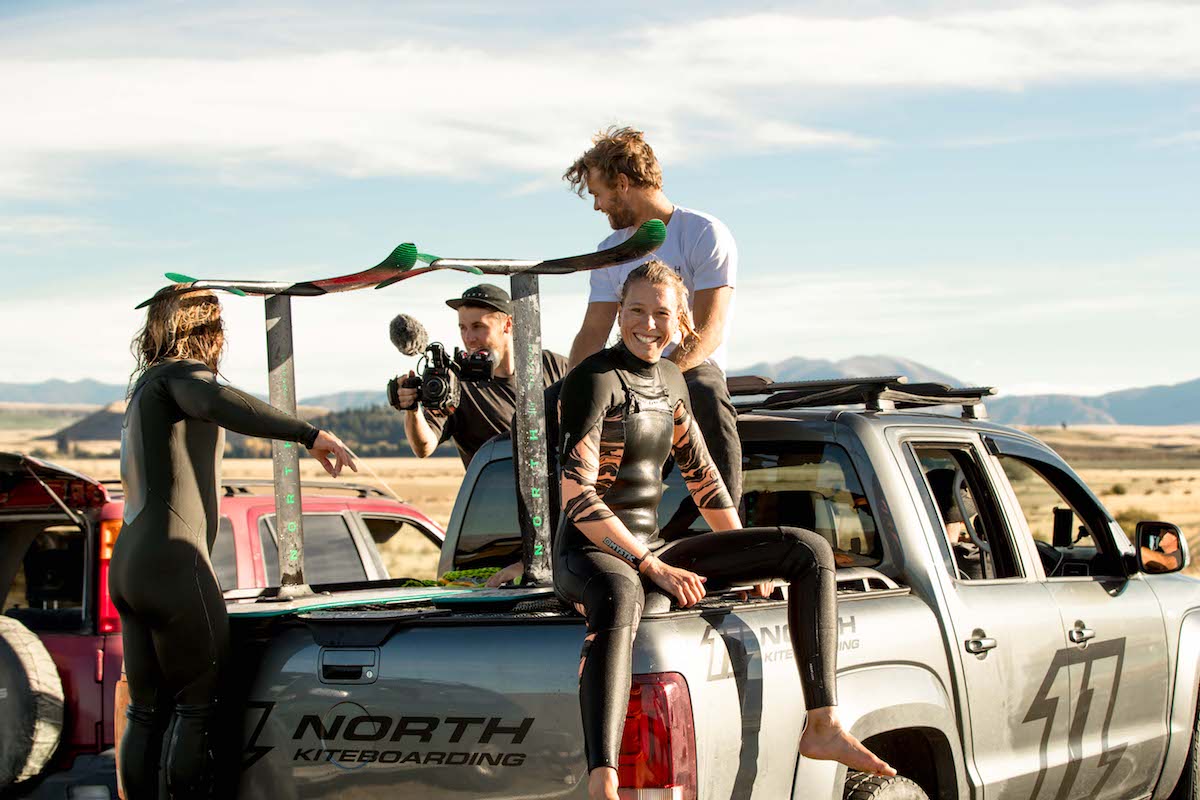
NORTH KITEBOARDING COMES HOME
NORTH KITEBOARDING COMES HOME
We Celebrate The Launch of North Kiteboarding
By Victoria Stuart
With a hand-picked team of the industry’s most experienced and respected designers, engineers and brand managers at the helm, the freshly re-calibrated brand delivered their thoughtfully refined range of kites, boards, foils and accessories to market under the North Technology Group (NTG) umbrella on the 8th August.
Kite-buffs around the world speculated if it was even possible – bringing to market a new premium brand almost twenty years into the sport? Especially with only one year to turn a blank slate into a full product range. But applauded for their intuitive, less-is-more approach to design, North Kiteboarding has rocketed, like their flagship kite the Orbit, above and beyond expectations.
Alongside the product designs, the team were instrumental in shaping a new brand philosophy that holds to our North heritage while also inspiring groundbreaking innovative solutions.
“The new North range is like nothing you’ve ever ridden before… bringing a high-quality, much needed, masterfully minimalist approach to their gear.” – Nathan Patterson, MACKiteboarding 📸 Vincent Schaap, Dakhla, Morocco
A Powerful Alliance Under NTG
North Kiteboarding’s return for the model year 2020 came about after NTG announced it would make a significant investment in its brand North Kiteboarding – bringing the design, innovation and manufacturing of its products home under the umbrella of the group and ending its third party licensing agreement. In January 2019, North Kiteboarding joined forces with world-leading accessories group Mystic BV under a new part of NTG called North Actionsports Group. This merger gave the brand instant access to one of the biggest distribution networks in the kite world, further strengthening its foundations and infrastructure.
North Actionsports Group represents a powerful alliance of world-class kiters and experienced industry innovators and leaders, determined to make kiteboarding more accessible, sustainable, innovative and exciting.
“I firmly believe creating great products is all about investing in incredible people,” says Mike Raper – North Kiteboarding Brand Director.
“At North, we are always seeking, always asking; ‘Where can there be more power, greater performance, more intuitive intelligence?’. Then, always: ‘How can it be simpler?’.
“I’m very proud of how our team has collaborated, working hard to leverage years of experience and passion and develop a high-performance range of gear.”
Working closely with the NTG’s composite engineers and designers, North Kiteboarding is excited to continue leveraging the unmatched aero and hydro expertise the Group has within its portfolio.
Engineered. Refined. Intuitive.
“We are determined to drive the sport of kiteboarding forward through unprecedented technological development and an unwavering commitment to our principles,” says Raper.
North Team Riders Jesse Richman, Jalou Langeree and Graham Howes after a foil session on the Hydro Canals captured by Content Creator Jonty Norton, with Mike Raper in the driver’s seat. 📸 Scott Sinton, MacKenzie Country, NZ
Tom Whidden, CEO of NTG, comments: “We have so much technology within our group which we can better share with our fellow lovers of wind and waves. Sailing and kiting are equipment-driven sports – when you have the best gear, being out there in the wind, on the water is so much better – in fact, it’s the greatest feeling on earth.”
Discover North Kiteboarding at www.northkb.com or join the conversation on:
Facebook: @northkiteboarding
Instagram: @northkiteboarding
READ MORE
READ MORE

NEW LOOK FOR THE US SAILBOAT SHOW IN ANNAPOLIS
LOOKING TO THE 2019 US SAILBOAT SHOW
Annapolis Loft Manager Jonathan Bartlett Talks New Offers & New Looks
North Sails has been a fixture at the United States Sailboat Show in Annapolis MD for well over 40 years. And for 2019, visitors to one of the most popular boat shows in North America (October 10-14) will be able to come and meet the team of experts from the world’s leading sailmaker in a brand new space at booth Dock-F1. Visitors will be able to discover how North Sails has the technology, products and global loft network to match any needs, whether for One Design Classes, racing or cruising. And for cruisers particularly, seeking a game-changing sail, they will be able to take advantage of the special Annapolis boat show promotion on 3Di NORDAC or NPL Tour. In an Annapolis boat show exclusive, North Sails are offering a special promotion: any customer who buys a 3Di Nordac or NLP Tour main and headsail together will receive a free G1 gennaker as a bonus sail. 3Di NORDAC is a revolutionary cruising sail made of 100% polyester fiber. Tailored for small to medium sized cruising boats, 3Di NORDAC transforms polyester fiber into seamless, one-piece sails that are uniquely strong, marrying the shape holding technology of 3Di with the toughness and affordability of polyester sails. Commenting on their presence as one of the longest exhibitors at the show, Jonathan Bartlett who is site Manager of the North Sails loft in Annapolis, said, “We are very excited to unveil our sleek new customer space at the Annapolis Boat Show. We are still at our usual location on the floating docks, which is always popular, but we have a bigger and brighter space to welcome anyone who wants to discuss our range of products, technology and service solutions. The Annapolis Show is one of our busiest events of the year, with up to five North experts working the booth at any point throughout the day and we leave the show with a number of leads and sails sold . We have a really experienced team working in our Annapolis loft, from both our sales and service sides - and it is our people that really make a difference for our clients so the chance to meet with them here at the Show is a great opportunity.” JB concluded, “3Di NORDAC has been a revolutionary product which has been hugely popular at the show for the last couple of years, so we’re delighted to be able to have this special offer here on our flagship cruising product. Alongside 3Di NORDAC, our range of cross-cut Dacron sails are also ideally suited to meet the cruising needs of any size of boat. We expect to see strong interest in the latest NPL SPORT Xi and 3Di RAW 360 from our racing clientele here in Annapolis. And finally, there are a lot of offshore One Design keel boats on the water in the Chesapeake Bay region and we are confident we can offer these owners the best products available in the market.” Key representatives from North Sails at the show include Allan Terhune, Will Keyworth, Austin Powers, Scott Allan, Ron LaNeve, and Certified Service Manager Ridgely Mackenzie.
READ MORE
READ MORE

AC36 REVENGE OF THE SAILMAKERS
AC36 REVENGE OF THE SAILMAKERS
The America’s Cup Is Back To The World Of Battens And Sailcloth
📸 Emirates Team New Zealand
By Ivor Wilkins, first published in the Royal NZ Yacht Squadron magazine, Breeze
On the eve of Emirates Team New Zealand’s new AC75 launch, the waterfront was buzzing with speculation about how these boats would perform. Would they crash and burn, or majestically rise up on their foils and race away? Within the halls of the team’s smart base at the Viaduct Basin, faith in what the sophisticated simulation programs had indicated remained strong. But the sense of eager anticipation and just a touch of nerves was palpable. For North Sails designer Burns Fallow, AC36 is a return to the America’s arena. This is his sixth America’s Cup campaign, but he was forced to sit out AC35 in Bermuda, when the sails were limited to one-design jibs. With hard wings no longer featured and a sail plan now made up of soft sails, albeit in an unfamiliar form, could this be regarded as the revenge of the sailmakers? He laughs at the notion, but doesn’t dismiss it. “It is a bit like that. We have had no mainsails for two cycles, so for this one we have two. We have to keep this configuration for one more go-around and then we will be equal again.”
His reference to two mainsails relates to the double luff twin-skin arrangement introduced for this cycle. Double luff mainsails are not entirely new, but have been largely confined to experimental craft. They are about to come under very close attention at this cycle of the Cup. Fallow says the first thing observers will notice is how short the rig is. “The sail plan is very small. If you go back to the Version 5 monohulls in Valencia, these rigs are more than 8m shorter. “Everybody understands that once you are foiling, you don’t need a large sail plan.” In displacement mode, this keel-less monohull does not need a large sail plan either. With low stability at slow speeds, excessive sail would be a liability. “It is quite different in that respect from a catamaran, which has massive stability from the get-go,” Fallow explains. However, regardless of the hull form, the name of the foiling game is to get up and out of the water as quickly as possible and to remain flying as long as possible. Surely, a monohull, which is considerably heavier than the previous America’s Cup catamarans, would require more power to achieve lift-off? Fallow says all the teams are going to be very coy about their lift-off speeds. “The aim is certainly to get foiling as soon as possible.”
A glance at the figures indicate that the sail designers have a challenge on their hands delivering the power to achieve that. The hard wing on the AC50 in Bermuda was 3m shorter than the AC75 with about 40m2 less area, but the monohull is three times the weight. The AC72 wings in San Francisco were 11.5m taller than the AC75 rig, with a surface area of about 260m2 and an overall weight (platform + wing but without crew) of approximately 7,200kg. The new AC75 is slightly lighter with an overall weight of 6,450kg (platform + wing but without crew) powered by the double luff mainsail with about 100m2 less surface area. The AC75 does gain from jibs that are proportionally much larger than the catamaran jibs, with the forestay attaching 2m below the top of the 26.5m mast.
These yachts can also carry masthead code zero sails flying from a bowsprit. Code zeros were allowed but seldom used on the AC72s and dispensed with altogether with the AC50s in Bermuda. Fallow also points out that, although the wings were very efficient, the soft-sail system is much lighter – “about half the weight of a solid wing.”
The value of the code zero remains a question mark. “Just where this sail fits in is one of the big questions,” says Fallow. “All the teams will be keen to find out how it works at full scale. “The rule is very open on how deep the code zero can be, how triangular, how big or small. There is a wide range of options, from almost like an A1 on an IRC boat in its most extreme version, down to a small, flat jib-top, or anywhere in between. As always with code zeros it will come down to ease of deployment and how to cope with the transitions from non-foiling to foiling and vice verse.”
📸 Emirates Team New Zealand
“It is a big mode change and there is an awful lot happening all at once for the guys trimming the sails. It is not like shifting gears on an IRC boat. This is like changing the whole transmission in an instant. It is a time of very high energy demand, that is for sure.” All those factors suggest that code zeros will probably carry a considerable “handle with care” warning and will probably come out only in light conditions. Within the triangular space created between the mast and the forestay, considerable freedom is given to jib designs. While most of the early design effort has gone into the double luff mainsails, the jibs are likely to play a big performance role and Fallow expects that once the yachts are trialing more attention will be devoted to headsails.
The objective with the new mainsail arrangement is to achieve a wing-like shape without the tremendous logistical demands involved in stepping and removing a cumbersome solid wing structure every day. It is accepted that the efficiency and control of the soft sail will be less than the solid wing, but considerably more than a conventional mainsail. The rule provides teams two zones within the sail plan – a 4m upper zone at the top and a 1.5m zone at the bottom – to install custom control systems to influence shape and twist. The area between what Fallow refers to as the “trickery” zones has to be passive. Glenn Ashby was seen as king of the wing at Bermuda as he reclined in his foxhole with his thumbs dancing over an X-box type controller to shape the wing for maximum performance. He acknowledges the soft system will have less control, but is confident of enough trickery in the freedom zones to achieve considerable shape-shifting.
In terms of design tools, Fallow says Michael Richelson of North Sails Group had done a lot of FEA work on solid wings using their proprietary Membrain software, so they used that as a starting point for investigating the new system. “During the rule development, I was debugging,” Fallow says, “and Michael was writing code. We were going backwards and forwards two or three times a day. It has been an invaluable tool.” In practice, the two skins are hoisted on separate luff tracks 400mm apart on the aft face of a D-shape mast that rotates 45° either way.
📸Emirates Team New Zealand
Teams are free to decide whether to join the two leeches, or leave them separate. Bearing in mind the leeward side has more curvature than the windward side, allowance has to be made for the natural tendency of the skins to slide backwards and forwards along the leeches on opposite tacks. Sheeting and tensioning arrangements are left open to the teams, as is the decision on whether or not to have a boom.
Fallow says the sheet loads would be comparable to a conventional maxi yacht at equivalent speeds. There was talk early on about whether the mainsails would be reef-able. Fallow: “The rule has been written in such a way that you could still have a mainsail that did not go to full hoist, but that would leave the top of the rig creating turbulence and drag.” More likely, teams will have full hoist mains designed for different wind ranges. “You would not have to necessarily make your final sail selection at the dock,” says Fallow. “You could switch mainsails on the water, but it is a considerable exercise by the time you have the two skins hoisted, with all the attachments and internal controls connected. You would not want to be leaving that decision to the 10-minute gun. It would be more like 40-45 minutes.” With the long-awaited on-water phase of the program about to begin, the sailors and team will soon learn the capabilities of this radical new design. Fallow expects it will follow a similar progression to the catamarans, first coming to grips with the foiling transition, then moving to foiling gybes, upwind foiling, foiling tacks and finally the ultimate goal of 100% dry laps Looking back, Fallow says the two years since they set about framing the new rule have rushed by. “We have learned a great deal in that period. Now we are about to go in the water and we will learn a great deal more. We are fully aware that this is just a milestone along the way. There is a long way to go.”
READ MORE
READ MORE
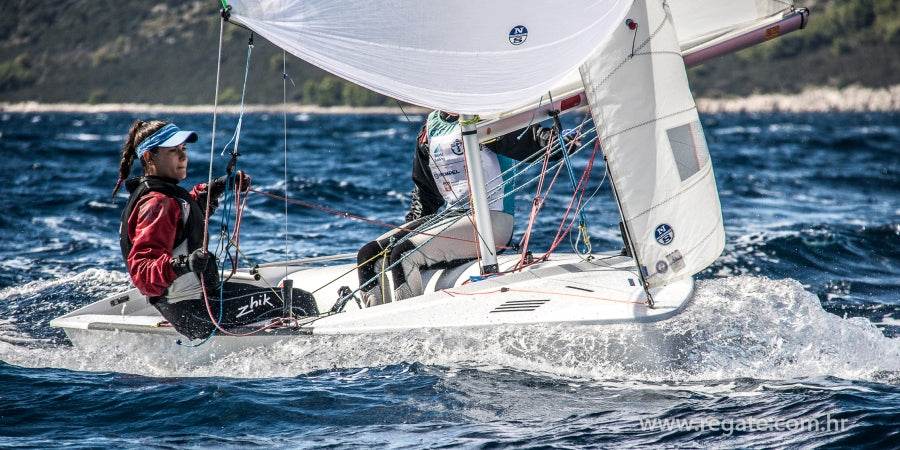
OTVORENO PH NEOLIMPIJSKIH KLASA
Otvoreno PH neolimpijskih klasa
Jedriličarski klub Marina Kaštela je od 13. do 15. rujna organizirao drugo ovogodišnje Prvenstvo Hrvatske za "male klase". Nakon ekipnog jedrenja za klasu Optimist ovog puta je bila riječ o Otvorenom PH za neolimpijske klase.
Jedrilo se u Laser 4.7, Laser Radialu, 420 i Techno 293, a uz domaće jedriličare nastupili su predstavnici Crne Gore i Slovenije.
Uvjeti na moru su bili takvi da su samo svestrani natjecatelji mogli računati da će se popeti na postolje. U petak se jedrilo u Kaštelanskom zaljevu po laganom burinu i sve klase su na kraju dana napravile konto sa po dve plova.
Subotnja prognoza je obećavala puno više vjetra sa zapada, pa je RO flotu pozvao na regatno polje s druge strane Čiova. To se pokazalo punim pogotkom jer su tamo odjedreni puni programi za sve flote po uvjetima koji su uključivali jedrenje po malom i umjerenom valu, kao i laganom, te umjerenom vjetru.
Jedino se nije jedrilo u nedjelju jer je vladala bezvjetrica s obje strane Čiova.
Sve flote su jedrile na istom regatnom polju postavljenom u trapez, samo su surferi imali štap varijantu, a startali su po redu koji je predvodio dvosjed 420, a iza kojeg su slijedile 4.7, pa Radiali i na kraju daske.
Pravu renesansu na ovom PH je doživjela klasa 420. Konkurencija je imala 11 posada iz 5 klubova od Istre do Splita. Posade su bile u svim kombinacijama, djevojke, momci i kombinirano, a od petka su liderski status preuzele članice Uskoka, Antonia Kuštera i Maris Bašić. One su prvenstvo započele s dvije pobjede, a u istom stilu su nastavile i u subotu kad su nastavile idealni niz.
Ove dvije djevojke su ujedno jedrile u kategoriji U19. U mlađem razvrstanju, U17, najbolje su bile klupske im kolegice Eva Šiško i Marta Mavar. Njih dvije su inače zauzele 4. mjesto u generalnom poretku.
Što se tiče laseraša, te dvije flote su bile najbrojnije. Lasera 4.7 je bilo ukupno 46, a prvog dana je najbržio bio gost iz Crne Gore, Nikola Golubović. On je regatu otvorio s dva prva mjesta, dok je oba puta prva iza njega bila naša trenutn najbolja jedriličarka u ovoj klasi, Ursula Balas.
Idućeg dana situacija se okrenula i njih dvoje su zamijenili mjesta, a svoje pozicije su zadržali unatoč tome što je Ursula dobila BFD u 4. plovu, a Nikola što nije startao u 3. pa je dobio DNC. Srećom, zbog ukupno odjedrenih 5 jedrenja mogli su odbaciti ove rezultate.
Zanimljiv podatak je i da je Nikola imao jednak broj bodova kao Lovre Bakotić koji je završio kao brončani, ali za konačni plasman je presudilo to što je Nikola pobijedio u dva plova, dok je Lovre uknjižio samo jedno prvo mjesto. Također je zanimljivo da su Nikola i Lovre, jednako kao i četveroplasirani Luka Fatović, u kategoriji U16.
Na 5. mjestu je finiširala jedriličarka Eleonore Borgin koja je vikend prije osvojila Europa Cup u svojoj kategoriji na Balatonu, a iza nje je završila pobjednica u skupini U16, Lea Rakovac.
Lasri 4.7 su u subotu imali i najproblematičnije starteve. Vjerojatno je razlog što je ovo bila prva ozbiljna regata mnogima koji su izašli iz klase Optimist i još uvijek nisu svladali ovu jedrilicu dovoljno dobro da je mogu staloženo kontrolirati na startnoj liniji. S druge strane veseli činjenica da neki od novopridošlih su se odmah ugurali u sam vrh klase i to sigurno obećava rezultatski zanimljivu jesen.
I Laseri s većim jedrom, Radiali, imali su jednako efektivno otvaranje regate kao i dvije prethodne klase, bar po pitanju lidera. Dva prva mjesta u petak je napravio Roko Stipanović. Jednako dobro je nastavio jedriti i u subotu, ali mu je poziciju na vrhu ugrozio Božo Golubić koji regatu završava s jednakim brojem bodova, ali Roko u svojoj rubrici ima tri pobjede, dok je Božo imao "samo" dvije. U svakom slučaju vrhunsko nadmetanje za zlatnu medalju.
Na vrhu ljestvice su dominirali stariji jedriličari. U prvih 7 svi osim Luke Vukovića su bili U19, dok je jedini senior u klasi, Krešimir Buneta, završio PH na desetom mjestu.
I za kraj su ostali surferi, jedini koji su odjedrili 4 plova na prvenstvu. I ovdje je situacija definira prvog dana regate. Na vrh su se odmah smjestili naš Nikola Stipčić i mlada slovenka, Marina Vrščaj.
Posebnost ove klase u odnosu na ostale je što je ovdje bilo i nekoliko natjecatelja u stvarno najmlađoj kategoriji, U13! To je i glavni razlog zašto je u subotu nije bila cijela flota na moru, jer je vjetar za najmlađe bio stvarno prejak.
U nedjelju, na proglašenju pobjednika, podijeljeno je ukupno 17 kompleta odličja! Tko je sve nagrađen i u kojoj kategoriji možete pronaći na ovom linku.
Ukupne rezultate Otvorenog PH za neolimpijske klase možete pronaći na web stranicama organizatora, fotogaleriju subotnjih jedrenja možete pogledati ovdje, dok se video izvještaj može pronaći u video galeriji.
READ MORE
READ MORE
